Past Fellows
Emilija Aleksandrovic
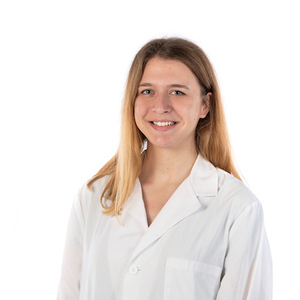
B.S. 2020, Hartwick College,Oneonta, NY
Discipline: Biology, IBMS program
Mentor: Siyuan Zhang
CBBI Fellow: 2021-2022
Current Position: Ph.D. candidate at UT Southwestern, Dallas, TX
Research Project:
Emilija's research project is centered around studying the metastatic microenvironment through the use of genetic labeling approach. She plans to investigate the role of metastasis-associated cells using high throughput single-cell sequencing and proteomics methods.
Internship:
Emilija is planning a research internship in the laboratory of Dr. Uma Aryal in the Summer of 2022 to receive training in targeted and global LC-MS/MS analysis of proteins.
Publications:
- Golomb, S.M.; Guldner, I.H.; Zhao, A.; Wang, Q.; Palakurthi, B.; Aleksandrovic, E.; Lopez, J.; Yang, K.; Zhang, S. Multi-modal single cell analysis reveals brain immune landscape plasticity during aging and gut microbiota dysbiosis. Cell Reports.2020, 33,108438. PMCID: PMC7737488.
W. Temple Andrews

B.A. 2015, Goucher College, Baltimore, MD
Ph.D. 2019, Biochemistry, University of Notre Dame, Notre Dame, IN
Dissertation: Development and Application of Mass Spectrometric Imagining Protocols
Discipline: Biochemistry
Mentor: Amanda Hummon
CBBI Fellow: 2017
Current Position: Lead Research Specialist, University of Maryland School of Pharmacy
Research Project:
Temple’s research focuses on peptide active extraction methodology for tissue imaging. He is planning to conduct a research internship in the laboratory of Prof. Merlin Bruening at the University of Notre Dame to learn to synthesize functionalized membranes for selectively extracting species.
Publications:
- Andrews, W.T.; Donahue, D.; Holmes, A.; Balsara, R.; Castellino, F.J.; Hummon, A.B. In situ metabolite and lipid analysis of GluN2D -/- and wild-type mice after ischemic stroke using MALDI MSI. Anal Bioanal Chem. 2020, 412, 6275-6285. PMID: 32107573. PMCID: PMC7483268 (available on 2021-09-01).
- Andrews, W.T.; Skube, S.B.; Hummon, A.B. Magnetic bead based peptide extraction methodology used for tissue imagining. Analyst, 2017, Dec 18; 143(1):133-140. doi: 10.1039/c7an00757d.PMID: 29119981 PMCID: PMC5734995.
Marcus Arieno

B.S. 2010, Eastern Washington University, Cheney, WA
M.S. 2017, Chemistry, University of Notre Dame, IN, Notre Dame,IN
Discipline: Chemistry
Mentor: Olaf G. Wiest
CBBI Fellow: 2012-2013
Current Position:
Research Project:
Marcus’ project is centered on the design of new drugs that inhibit epigenetic readers, specifically bromodomains by means of the analysis of protein dynamics by MD simulation to gain atomic-level understanding of drug binding and protein flexibility, computationally docking libraries of drug-like molecules against bromodomain receptors and rescoring docked poses by MD simulation and MM methodologies to obtain relative binding energies for predicting which compound libraries to assay experimentally, and quantifying the shape complementarity of drug-receptor complexes in order to relate overall shape fit of drugs with different scoring functions.
Internship
May – August 2012 University of Oxford, Structural Genomics Consortium, Headington, Oxford, UK: Mentor: Professor Panagis Filippakopoulos
The goal of Marcus’ internship is to use technology and resources available at the Structural Genomics Consortium, to express and purify various bromodomains to perform binding assays of virtually screened compounds and to grow protein crystals to obtain X-ray structures. Aim is to use results to apply toward the design of more potent binders and improved predictive models.
Publications:
- Xu,W.; Arieno, M.; Low, H.; Huang, K.; Xie, X.; Cruchter, T.; Ma, Q.; Xi, J.; Huang, B.; Wiest, O.; Gong, L.; Meggers, E. Metal Templated Design: Enantioselective Hydrogen-Bond-Driven Catalysis Requiring Only Part-per-Million Catalyst Loading. Am. Chem. Soc. 2016, 138, 8774-8780. PMID: 27336458.
- Byrd, K.M.; Arieno, M.D.; Kennelly, M.E.; Estiu, G.; Wiest, O.; Helquist, P. Design and Synthesis of a crosslinker for studying intracellular steroid trafficking pathways. Bioorg Med Chem. 2015, 23(13),3843-3851.
PMID: 25890696 PMCID: PMC4461494.
Luis Avila

B.S.2017, University of Kansas, Lawrence, KS
Ph.D. 2023, Biochemistry, University of Notre Dame, Notre Dame, IN
Dissertation: Elucidating the Protein-Protein Interaction Networks and Localizations of the Lytic Transglycoylases RlPA and Slt of Pseudomonas aeruginosa
Discipline: Biochemistry
Mentor: Shahriar Mobashery
CBBI Fellow: 2018-2020
Current Position:
Research Project:
Luis's research focuses on the bacterial cell-wall degradome. Luis will receive training in biochemistry as his major area, but he will integrate his biochemical research with analytical chemistry and physical-chemical analyses of proteins.
Publications:
- Masitas, C.; Peng, Z.; Wang, M.; Konai, M.M.; Avila-Cobian, L.F.; Lemieux, L.; Hovanesian, J.; Grady, J.E.; Mobashery, S.; and Chang, M. Matric metalloproteinase-14 as an instigator of fibrosis in human pterygium and its pharmacological intervention. ACS Pharmacology & Translational Science. DOI Science. DOI: 10.1021/acsptsci.2c00125. PMID: 35983271 PMCID: PMC9380204 (available on 2023-07-19).
- Peng, Z.; Konai, M.M.; Avila-Cobian, L.F.; Wang, M.; Mobashery, S.; and Chang, M. MMP-1 and ADAM10 as targets for therapeutic intervention in idiopathic pulmonary fibrosis. ACS Pharmacology & Translations Science. DOI: 10.1021/acsptsci.2c00050. PMID: 35983283 PMCID: PMC9380212 (available on 2023-07-18).
Emily Bacher
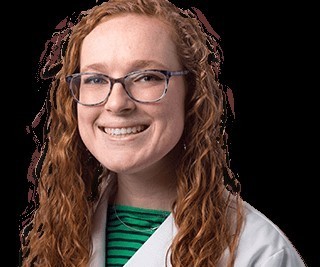
B.S. 2015, Wofford College, Spartanburg, SC
Ph.D. 2020, Chemistry, University of Notre Dame
Dissertation: Shedding New Light on Squaraines: Utilizing Squaraine Dyes as Effective Tools in Organic Synthesis
Discipline: Organic Chemistry
Mentor: Brandon Ashfeld
CBBI Fellow: 2016-2018
Current Position: Scientist l, Cambrex, Durham, North Carolina
Research Project:
Emily’s research focuses on utilizing nucleophilic phosphines for the construction of highly substituted oxindole and benzofuranone derivatives from appropriately substituted squaraine dyes. She is planning to conduct a research internship in the laboratory of Prof. Siyuan Zhang at the University of Notre Dame to understand how Ebola virus infection leads to unregulated phospholipid synthesis by mass spectrometry, as well as the effect drug treatment has on lipid composition.
Internship:
January 2018 – March 2018 University of Notre Dame, Department of Biological Sciences, Notre Dame, IN: Mentor: Professor Siyuan Zhang. Emily’s research internship was conducted to understand how the Ebola virus infection leads to unregulated phospholipid synthesis by mass spectrometry, as well as the effective drug treatment has on lipid composition.
Publications:
- Bacher, E.P.; Koh, K.J.; Lepore, A.J.; Oliver, A. G.; Wiest, O.; Ashfeld, B. A Phosphine-Mediated Dearomative Skeletal Rearrangement of Dianiline Squaraine Dyes.Org Letter. 2021, 23, 2853-2857. PMCID: PMC8126346 (available on 2022-04-16).
- Rodriguez, K.X.; Howe, E.N.; Bacher, E.P.; Burnette, M.; Meloche, J.L.; Meisel, J.; Schnepp, P.; Tan, X.; Chang, M.; Zartman, J.; Zhang, S.; Ashfeld, B.L. Combined Scaffold Evaluation and Systems-Level Transcriptome-Based Analysis for Accelerated Lead Optimization Reveals Ribosomal Targeting Spirooxindole Cyclopropanes. Chem Med Chem. 2019, doi: 10.1002/cmdc.201900266. PMID: 31140738.
-
Bacher, E.P.; Lepore, A.J.; Pena-Romero D.; Smith, B.D.; Ashfeld, B.L. Nucleophilic addition of phosphorus(iii) derivatives to squaraines: colorimetric detection of transition metal-mediated or thermal reversion.
Chem Commun (Camb). 2019, 55(22):3286-3289. doi: 10.1039/c9cc01243e. Epub 2019 Feb 27.PMID: 30810572.
Kerry Bauer

B.S. 2009, College of Saint Benedict/St. John’s University, St. Joseph, MN
Ph.D. 2014, Biochemistry, University of Notre Dame
Dissertation: Using Quantitative Transcriptomic and Proteomic Methodologies to Interrogate Biomarkers in Colon Cancer
Discipline: Biochemistry
Mentor: Amanda Hummon
CBBI Fellow: 2011-2014
Current Position: Senior Scientist, Meso Scale Diagnostics, LLC, Rockville, MD
Research Project:
Kerry interrogated the effect of a microRNA cluster on the colon cancer proteome and transcriptome. She used mass spectrometry, microarrays, RT-PCR and RNA interference to investigate the role of these antitumorigenic microRNAs. Kerry has completed a research internship with Dr. Lingjun Li (School of Pharmacy, University of Wisconsin-Madison) to learn quantitative chemical labeling strategies for proteomics.
Internship:
University of Wisconsin-Madison, School of Pharmacy, Madison, WI: Mentor: Lingjun Li. Kerry’s research internship involved learning quantitative chemical labeling strategies for proteomics.
Honors:
- College of Saint Benedict Chemistry Achievement Award (2006)
- Epsilon Sigma, Omega Chapter National Catholic Honor Society (2008)
- Graduated with summa cum laude honors (College of Saint Benedict, 2009)
Publications:
- Wangsa, D.; Braun, R.; Stuelten, C.H.; Brown, M.; Bauer, K.M.; Emons, G.; Weston, L.A.; Hu, Y.; Yang, H.H.; Vila-Casadesús, M.; Lee, M.P.; Brauer, P.; Warner, L.; Upender, M.; Hummon, A.B. Camps, J.; Ried,T. Induced Chromosomal Aneuploidy Results in Global and Consistent Deregulation of the Transcriptome of Cancer Cells. Neoplasia. 2019, 21(7), 721-729. doi:10.1016/j.neo.2019.04.009. Epub 2019 June 4. PMID: 31174021.
- Schroll, M.M.; Ludwig, K.R.; Bauer, K.M.; Hummon, A.B. Calcitriol Supplementation Causes Decreases in Tumorigenic Proteins and Different Proteomic and Metabolomic Signatures in Right versus Left-Sided Colon Cancer. Metabolites. 2018, 8(1). pii. E5. doi: 10.3390/metabo8010005. PMID: 29324674.
- Bauer, K.M.; Watts, T.N.; Buechler, S.; Hummon, A.B.; Proteomic and functional investigation of the colon cancer relapse-associated genes NOX4 and ITGA3. J. Proteome Res. 2014, 13, 4910-4918. doi:10.1021/pr500557n. epub 2014 Aug 18. PMID: 25096929.
- Weston, L.A.; Bauer, K.M.; Hummon, A.B.; Comparison of bottom-up proteomic approaches for LC-MS analysis of complex proteomes. Anal Methods. 2013, 5(18).
doi:10.1039/C3AY40853A. PMID: 24288579. - Weston, L.A.; Bauer, K.M.; Skube, S.B.; Hummon, A.B.; Selective, bead-based global peptide capture using a bifunctional cross-linker. Anal. Chem. 2013, 85, 10675-10679. doi:10.1021/ac401825m. Epub 2013 Oct 28. PMID: 24117407.
- Bauer, K.M.; Hummon, A.B.; Effects of the miR-143/-145 microRNA cluster on the colon cancer proteome and transcriptome. J. Proteome Res. 2012, 11, 4744-4754. doi: 10.1021/pr300600r. Epub2012 Aug 27. PMID:22897626.
- Bauer, K.M.; Lambert, P.A.; Hummon, A.B. Comparative label-free LC-MS/MS analysis of colorectal adenocarcinoma and metastatic cells treated with 5-fluorouracil. Proteomics. 2012, 12(12), 1928-1937. doi: 10.1002/pmic.201200041. PMID: 22623418.
- Bauer, K. M.; Hummon, A. B.; Buechler, S. Right-side and left-side colon cancer follow different pathways to relapse. Mol Carcinog. 2012, 51:411-421. doi: 10.1002/mc.20804. Epub 2011 Jun. PMID : 21656576.
Jill Bouchard
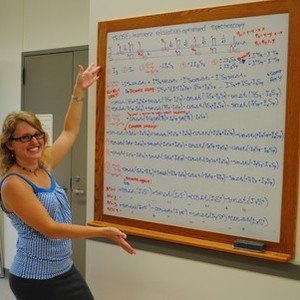
B.S. 2009, University of Montana, Missoula, MT
Ph.D., 2014, Biochemistry, University of Notre Dame, Notre Dame, IN
Dissertation: Ensemble Interpretation of Domain Mobility in Modular Protein PIN1 by NMR and Molecular Dynamics
Discipline: Biochemistry
Mentor: Jeffrey Peng
CBBI Fellow: 2011-2013
Current Position: Editor in Chief, Condensates. com
Research Project:
Jill investigated how interdomain motion affects the function of human Pin1, a peptidyl-prolyl isomerase involved in mitotic regulation. Pin1 contains two domains: a WW domain that binds specific phosphorylated substrates, and a PPIase domain that catalyzes substrate isomerization. Her goal was to define the crosstalk between these domains via the orientation and dynamic information contained in residual dipolar couplings. Jill’s cross-disciplinary work was to be in the lab of Dr. David Case at Rutgers University to produce a complete picture of Pin1’s functional dynamics by using computational approaches to integrate multiple experimental parameters reporting on different timescales.
Internship:
Rutgers University, New Brunswick, NJ: Mentor: Professor David Case. Jill’s cross-disciplinary work was to produce a complete picture of Pin1’s functional dynamics by using computational approaches to integrate multiple experimental parameters reporting on different timescales.
Honors:
- Outstanding Senior in Chemistry (2009)
- Montana Integrative Learning Experience for Students (MILES) Internship & Fellowship (2008)
- Lien Undergraduate Fellowship (2008)
- John D Sullivan Memorial Chemistry Scholarship (2006)
- Montana University System (MUS) Scholarship (2004-2007)
Publications
- Bouchard, J.J.; Xia, J, Case, D.A.; Peng, J.W. Enhanced Sampling of Interdomain Motion Using Map_Restrained Langevin Dynamics and NMR: Application to Pin1. J Mol Biol. 2018, 430, (14), 2164-2180. doi: 10.1016/j.jmb.2018.05.007. Epub 2018 May 16. PMID: 29775635.
- Wilson, K.A.; Bouchard, J.J.; Peng, J.W.; Interdomain interactions support interdomain communication in human Pin1. Biochemistry 2013, 52 (40), 6968-6981. doi: 10.1021/bi401057x. Epub 2013 Sep 24. PMID: 24020391.
Renee Bouley
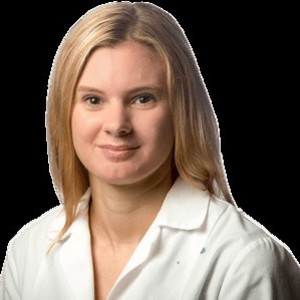
B.S. 2010, Grand Valley State University, Allendale, MI
PhD 2015, Chemistry, University of Notre Dame, Notre Dame, IN
Dissertation: Discovery of New Antibacterial Agents for the Treatment of Methicillin-Resistant Staphyloccocus Aureus
Discipline: Chemistry
Mentors: Shahriar Mobashery & Mayland Chang
CBBI Fellow: 2012-2015
Current Position: Assistant Professor, Ohio State University, Marion, OH
Research Project:
Renee’s research project focused on the quinazolinone class of antibiotics.
Internship:
Publications:
- Janardhanan J.; Bouley R.; Martínez-Caballero S.; Peng, Z.; Batuecas-Mordillo, M.; Meisel, J.E.; Ding, D.; Schroeder V.A.; Wolter, W.R.; Mahasenan, K.V.; Hermoso J.A.; Mobashery, S.; Chang, M. The Auinazolinone Allosteric Inhibitor of PBP 2a Synergizes with Piperacillin and tazobactam against Methicillin-Resistant Staphylococcus aureus. Antimicrob Agents Chemother. 2019, 63(5). pii: e02637-18. doi: 10.1128/AAC.02637-18. Print 2019 May.PMID: 30858202.
- Mahasenan K.V.; Molina R.; Bouley R.; Batuecas M.T.; Fisher J.F.; Hermoso, J.A.; Chang M.; Mobashery S. Conformational Dynamics in Penicillin-Binding Protein 2a of Methicillin-Resistant Staphylococcus aureus, Allosteric Communication Network and Enablement of Catalysis. J Am Chem Soc. 2017 139(5),2102-2110. doi: 10.1021/jacs.6b12565. Epub 2017 Jan 27.PMID: 28099001.
- Bouley R.; Ding D.; Peng Z.; Bastian M.; Lastochkin E.; Song W.; Suckow M.A.; Schroeder V.A.; Wolter W.R.; Mobashery S.; Chang M. Structure_Activity Relationship for the 4(3H)-Quinazolinone Antibacterials.J Med Chem. 2016 59(10),5011-5021. doi: 10.1021/acs.jmedchem.6b00372. Epub 2016 May 5. PMID:27088777.
- Gonzales P.R.; Pesesky M.W.; Bouley R.; Ballard A.; Biddy B.A.; Suckow M.A.; Wolter W.R.; Schroeder V.A.; Burnham C.A.; Mobashery S.; Chang M.; Dantas G. Synergistic, collaterally β-lactam combinations suppress resistance in MRSA. Nat Chem Biol. 2015, 11(11),855-861. doi: 10.1038/nchembio.1911. Epub 2015 Sep 14. PMID:26368589.
- Wang H.; Lee M.; Peng Z.; Blázquez B.; Lastochkin E.; Kumarasiri M.; Bouley R; Chang M.; Mobashery S. Synthesis and evaluation of1,2,4-triazolo[1,5-a]pyrimidines as antibacterial agents against Enterococcus faecium. J Med Chem. 2015, 58(10):4194-203. doi: 10.1021/jm501831g. Epub 2015 May 12. PMID: 25923368.
- Bouley R.; Kumarasiri M.; Peng Z.; Otero L.H.; Song W.; Suckow M.A.; Schroeder V.A.; Wolter W.R.; Lastochkin E.; Antunes N.T.; Pi H.; Vakulenko S.; Hermoso J.A.; Chang M.; Mobashery S. Discovery of antibiotic (E)-3-(3-carboxyphenyl)-2(4-cyanostyryl) quinazolin-4(3H)-one. J Am Chem Soc. 2015, 137(5),1738-1741. doi: 10.1021/jacs.5b00056. Epub 2015 Feb 2.PMID: 25629446.
- Testero S.A.; Bouley R.; Fisher J.F.; Chang M.; Mobashery S. Exploration of mild copper-mediated coupling of organotrifluoroborates in the synthesis of thiirane-based inhibitors of matrix metalloproteinases. Bioorg Med Chem Lett. 2011 21(9):2675-2678. doi: 10.1016/j.bmcl.2010.12.076. Epub 2010 Dec 29. PMID: 21256011.
Esther Braselmann

Diploma 2009, Biochemistry, University of Bielefeld, Germany
Ph.D. 2014, Biochemistry, University of Notre Dame, Notre Dame, IN
Dissertation: Investigating the Secretion of Folding Mechanism of a Beta-Sheet Rich Virulence Protein
Discipline: Biochemistry
Mentor: Patricia Clark
CBBI Fellow: 2010-2013
Current Position: Assistant Professor, Georgetown University, Washington, DC
Research Project:
Esther characterized the structural features of the stalled outer membrane secretion intermediate to determine whether the passenger domain crosses the outer membrane through its own porin domain or association to a non-autotransporter porin complex. She incorporated unnatural amino acids in the passenger and porin domains in vivo, isolates the complex, and after digestion identifies the cross-linked peptides by mass spectrometry. She conducted a research internship at Franklin and Marshall College to learn synthetic methods to produce novel cross-linkers and optimize incorporation of unnatural amino acids into proteins.
Internship:
Franklin and Marshall College, Lancaster, PA. Esther’s research internship involved learning synthetic methods to produce novel cross-linkers and optimize the incorporation of unnatural amino acids into proteins.
Honors:
- DAAD Fellowship, 2007
Publications:
- Braselmann E.; Chaney J.L.; Champion M.M.; Clark P.L. DegP Chaperone Supperesses Toxic Inner Membrane Translocation Intermediates. PLoS One. 2016 11(9): e0162922. doi: 10.1371/journal.pne.0162922. eCollection 2016.
- Cressiot B.; Braselmann E.; Oukhaled A.; Elcock A.H.; Pelta J.; Clark P.L. Dynamics and Energy Contributions for Transport of Unfolded Pertactin through a Protein Nanopore. ACS Nano. 2015, 9(9), 9050-9061. doi: 10.1021/acsnano.5b03053. Epub 2015 Aug 28. PMID: 26302243.
- Drobnak I.; Braselmann E.; Clark P.L. Multiple driving forces required for efficient secretion of autotransporter virulence proteins. J Biol Chem. 2015, 290(16), 10104-10116. doi: 10.1074/jbc.M114.629170. Epub 2015 Feb 10. PMID: 25670852.
- Drobnak I.; Braselmann E.; Chaney J.L.; Leyton D.L.; Bernstein H.D.; Lithgow T.; Luirink J.; Nataro J.P.; Clark P.L. Of linkers and autochaperones: an unambiguous nomenclature to identify common and uncommon these for autotrasporter secretion. Mol Microbiol. 2015, 95(1), 1-16. doi:10.1111/mmi.12838. Epub 2014 Nov 24. Review. PMID: 25345653.
- Braselmann E.; Chaney J.L.; Clark P.L. Folding the proteome. Trends Biochem Sci. 2013, 38(7), 337-344. doi: 10.1016/j.tibs.2013.05.001. Epub 2013 Jun 11. Review. PMID: 23764454.
- Braselmann E. ; Clark, P.L. Autotransporters: The Cellular Environment Reshapes a Folding Mechanism to Promote Protein Transport. J Phys Chem Lett. 2012, 3(8), 1063-1071. PMID: 23687560.
- Renn, J. P.; Junker, M.; Besingi, R. N.; Braselmann, E.; Clark, P. L. ATP-Independent Control of Autotransporter Virulence Protein Transport via the Folding Properties of the Secreted Protein. Chem Biol. 2012, 19(2), 287-296. doi: 10.1016/j.chembiol.2011.11.009. Epub 2011 Dec 29. PMID: 22209629.
Kurtis Breger

B.S.2016, Saint Louis University, Saint Louis, MO
PhD. 2023, Biochemistry, University of Notre Dame, Notre Dame, IN
Dissertation: Elucidating the Kinetic Mechanism of Human Mettl16 and It's Role in Miller-dieker Syndrome
Discipline: Biochemistry
Mentor: Jessica Brown
CBBI Fellow: 2020-2021
Current Position:
Research Project:
Kurtis's research project is focused on understanding the enzymes involved with RNA modifications and elucidating the disruptions to the transcriptome and epitranscriptome when these enzymes are impaired in human diseases.
Internship:
February 7, 2022- April 8, 2022. University of Cincinnati, Cincinnati, OH. Mentor: Professor Patrick Limbach. Kurtis's internship provided expertise in using mass spectrometry and other chromatographic techniques for quantifying RNA modifications and related metabolites from various sources. He performed various mass spectrometric analyses on cellular and nuclear extracts of healthy cells (BJ cells) and Miller-Dieker Syndrome cells. He worked on measuring the cellular concentrations of SAM and SAH using Liquid Chromatography Electrospray Ionization Tandem Mass Spectrometry. Kurtis also measured DNA and RNA modifications using liquid chromatography-tandem mass spectrometry.
Publications:
- Breger, K.; Brown, J.A. Elucidating the Kinetic Mechanism of Human METTL16. Biochemistry. 2023, 62, 494–506. doi.org/10.1021/acs.biochem.2c00601. Epub 2022 Dec 30.PMID: 36584291.
- McCown, P.J.; Ruszkowska, A.; Kunkler, C.N.; Breger, K.; Hulewicz, J.P; Wang, M.C.; Springer, N.A.; Brown, J.A. Naturally Occurring Modified Ribonucleosides. Wiley Interdiscip Rev RNA. 2020, e1595, doi: 10.1002wrna.1595. [online ahead of print] PMID: 32301288.
Katherine M. Byrd
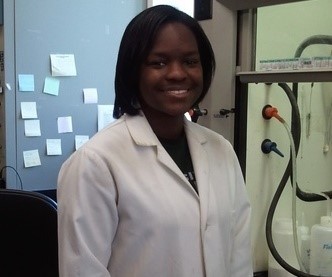
B.S. 2008, Xavier University, New Orleans, LA
Ph.D. 2014, Chemistry, University of Notre Dame, Notre Dame, IN
Dissertation: Design, Synthesis and Application of Cholesterol-Based Molecular Probes as Biochemical Tools for the Study of Cholesterol Trafficking
Discipline: Chemistry
Mentor: Paul Helquist
CBBI Fellow: 2011-2012
Current Position: Project Manager, Park Mobile, LLC, Atlanta, GA
Publications:
- Byrd K.M.; Blagg B.S.J. Chaperone Substrate Provides Missing Link for Cancer Drug Discovery. J Biol Chem. 2018, 293, 2381-2382. doi: 10.1074/jbc.H118.001591. PMID: 29453286.
- Byrd K.M.; Kent C.N.; Blagg B.S.J. Synthesis and Biological Evaluation of Stilbene Analogues as hsp90 C-Terminal Inhibitors. ChemMedChem. 2017, 12(24), 2022-2029. doi: 10.1002/cmdc.201700630. epub 2017 Nov 30. PMID: 29058824.
- Byrd K.M.; Subramanian C.; Sanchez J.; Motiwala H.F.; Liu W.; Cohen M.S.; Holzbeierlein J.; Blagg B.S. Synthesis and Biological Evaluation of Novobiocin Core Analogues as Hsp90 Inhibitors. Chemistry. 2016, 22(20), 6921-31. doi: 10.1002/chem.201504955. Epub 2016 Apr 1. PMID: 27037933.
- Byrd, K.M. Diastereoselective and Enantioselective Conjugate Addition Reactions Utilizing α,β-Unsaturated Amides and Lactams. Beilstein J Org Chem. 2015, 11, 530-562. doi: 10.3762/bjoc.11.60. eCollection 2015. Review. PMID: 25977728.
- Byrd K.M.; Arieno M.D.; Kennelly M.E.; Estiu G.; Wiest O.; Helquist P. Design and Synthesis of a Crosslinker for Studying Intracellular Steroid Trafficking Pathways. Bioorg Med Chem. 2015, 23(13), 3843-3851. doi: 10.1016/j.bmc.2015.03.053. Epub 2015 Mar 27. PMID: 25890696.
- Cosner, C. C.; Cabrera, P. J.; Byrd, K. M.; Thomas, A. M.; Helquist, P. Selective oxidation of benzylic and allylic alcohols using Mn(OAc)3/catalytic 2,3-dichloro-5,6-dicyano-1,4-benzoquinone. Org Lett. 2011, 15, 2071-3. doi: 10.1021/o120041g. Epub 2011 Mar 11. PMID: 21395252.
Verodia Charlestin

B.S. 2016, University of Florida, Gainesville, FL
Ph.D. 2023, Biochemistry, University of Notre Dame, IN
Dissertation: The Effect of Aquaporin-7 on Breast Cancer Progression and Therapeutic Resistance
Discipline: Biochemistry
Mentor: Laurie E. Littlepage
CBBI Fellow: 2018-2020
Current Position: Adjunct Faculty, Bethel University, Mishawaka, IN
Research Project:
Verodia's research focuses on the alteration of the metabolism of tumor cells in the tumor microenvironment using mass spectrometry imaging MALDI. She plans a research internship with Professor Costas Lyssiotis at the University of Michigan in January 2020 to learn new approaches in molecular imaging of lipids. Verodia's project involves novel correlation-based network analysis of breast tumor metabolism identifying the glycerol channel protein Aquaporin-7 as a regulator of lipid and arginine metabolism during breast cancer.
Internship:
January 2020 - March 2020 University of Michigan, Ann Arbor, MI. Mentor Professor Costas Lyssiotis. She will be learning how to use labeled substrates in metabolic flux analysis and incorporating other analytical techniques into my research.
Honors:
- Midwest TME Young Investigator Award 2022
- Deans' Fellowship 2020-2023
Publications:
- Charlestin, V.; Fulkerson, D.; Matus, C.E.A.; Walker, Z.T.; Carthy, K.; and Littlepage, L.E. Aquaporins: new Players in Breast Cancer Progression and Treatment Response. Frontiers Oncology, 2022, 12:988119. doi:10.3389/fon. 2022.988119.
- Publication with internship mentor CA Lyssiotis. Nwosu, Z.C.; Giza, H.; Nassif, M.; Charlestin, V.; Menjivar, R.E.; Kim,D.; Kemp, S.; Steele, N.G. Hu, J.; Hu,B.; Wang, S.; Pasca di Magliano,M.; Lyssiotis, C.A. Multi-dimensional analyses identify genes of high priority for pancreatic cancer research. bioRXiv 2021.05.28.446056. doi:https;//doi.org/10.1101/2021.05.28.446056
- Dai, C.; Charlestin, V.; Wang, M.; Walker, Z.T.; Miranda-Vergara, M.C.; Facchine, B.A.; Wu, J.; Kaliney, W.J.; Dovichi, N.J.; Li, J.; Littlepage, L.E. Aquaporin-7 Regulates the Response to Cellular Stress in Breast Cancer. Cancer Res., 2020, 80(19):4071-4086.;Doi: 10.1158/0008-5472.CAN-19-2269. Epub 2020 Jul 6. PMID: 32631905.
- Nwosu, Z.C., Piorońska, W.; Battello, N.; Zimmer, A.D.; Dewidar,B.; Han, M.; Pereira, S.; Blagojevic,B.; Castven, D.; Charlestin,V.; Holenya, P.; Lochead, J.; De La Torre, C.; Gretz, N.; Sajjakulnukit, P.; Zhang, L.; Ward, M.H.; Marquardt,J.U.; di Magliano, M.P.; Lyssiotis, C.A.; Sleeman, J.; Wölfl, S.; Ebert, M.P.; Meyer, C.; Hofmann, U.; Dooley, S. Severe Metabolic Alternations in Liver Cancer Lead to ERK Pathway Activation and Drug Resistance. EBioMedicine. 2020, 54, 102699. PMCID: PMC7182727
Mary Cloutier
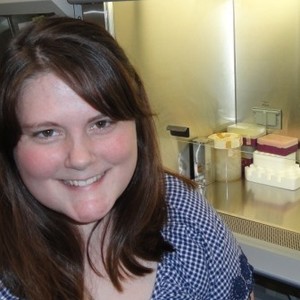
B.S. 2008, Biochemistry, University of Maine, Orono, ME
M.S. Biological Sciences 2013, University of Notre Dame, Notre Dame, IN
Discipline: Biological Sciences
Mentor: Kasturi Haldar
CBBI Fellow: 2010-2011
Current Position: Curriculum Mapping Writer, Study. Com, Mountain View, CA
Research Project:
Mary is studying the binding of cholesterol to Neimann Pick Type C-1. Using docking simulations of cholesterol to the N-terminal domain of NPC-1, she found that the isooctyl sidechain buried conformation was more energetically favorable than the 3beta-hydroxyl group buried conformation. She will also conduct NMR studies using recombinant NPC1- N-terminal domain protein to determine the relevance in vitro, as well as using cholesterol binding assays. Mary’s cross-disciplinary training consists of computational studies with Prof. Jesus Izaguirre and NMR studies with Prof. Jeff Peng. In addition, she plans a research internship at Washington University School of Medicine to learn techniques for the purification and analysis of oxysterols and cholesterol to understand the trafficking defects contributing to Niemann Pick Type C disease.
Honors:
- Biology Book Award
- Member, National Society of Collegiate Scholars, 2004
- Member, Phi Mu Epsilon Honors Society, 2007
- Cum laude graduate, 2008
Erin Cole
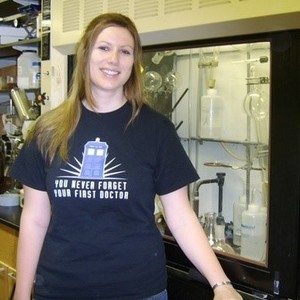
B.S. Chemistry and Biochemistry 2007, Drake University, Des Moines, IA
Ph.D. 2013, Chemistry, University of Notre Dame, IN
Dissertation: Water-Soluble, Deep-Red Fluorescent Squaraine Rotaxanes
Discipline: Organic Chemistry
Mentor: Bradley Smith
CBBI Fellow: 2009-2011
Current Position: Senior Scientist, Bristol-Meyers Squibb
Research Project:
Erin is synthesizing multivalent fluorescent probes for imaging of damaged bone. Repetitive loading and stress result in microdamage to bone tissue that leads to increased susceptibility to fractures. Conventional methods for imaging and quantifying of microdamage are invasive and destructive, leading to limited medical applications. She is currently working in collaboration with the Ryan K. Roeder laboratory in the Department of Aerospace and Mechanical Engineering at the University of Notre Dame. In this collaboration, she is learning about microdamage and bone imaging. Her research is to synthesize and evaluate multivalent squaraine-rotaxanes probes and nanoparticles for imaging of microdamage.
Internship:
University of Notre Dame, Department of Aerospace and Mechanical Engineering, Notre Dame, IN Mentor: Ryan Roeder. In this collaboration, she learned about microdamage and bone imaging. Her research was to synthesize and evaluate multivalent squaraine-rotaxanes probes and nanoparticles for imaging of microdamage.
Honors:
- Dr. William Homer and Florence Coppock Chemistry Research Award, 2006
- Department of Chemistry Outstanding Senior Award, Drake University, 2007
- Drake Undergraduate Science Collaborative Research Grant, 2006
- Beta Beta Beta Biological Honor Society
Publications:
- Harmatys, K.M.; Cole, E.L.; Smith, B.D. In vivo imaging of bone using a deep-red fluorescent molecular probe bearing multiple iminodiacetate groups. Mol Pharm. 2013, Nov 4, 10(11):4263-4271. doi: 10.1021/mp400357v. Epub 2013 Oct 22. PMID: 24099089 PMCID: PMC3943353.
- Smith, B.A.;Harmatys, K.M.; Xiao, S.; Cole, E.L.; Plaunt, A.J.; Wolter, W.; Suckow, M.A.; Smith, B.D. Enhanced cell death imaging using multivalent zinc(II)-bis(dipicolylamine) fluorescent probes.Mol Pharm. 2013,
Sep 3 10(9):3296-3303. doi: 10.1021/mp300720k. Epub 2013 Aug 5. PMID: 23915311 PMCID: PMC3874067. - Smith B.A.; ,Xie B.W.; Van Beek E.R.; Que I.; Blankevoort V.; Xiao S.; Cole E.L.; Hoehn M.; Kaijzel E.L.; Löwik C.W.; Smith B.D. Multicolor fluorescence imaging of traumatic brain injury in a cryolesion mouse model. ACS Chem Neurosci. 2012, 3(7), 530-537. doi: 10.1021/cn3000197. Epub 2012 Apr 7. PMID: 22860222.
- Cole E.L.; Arunkumar E.; Xiao S.; Smith B.A.; Smith B.D. Water-soluble, deep-red fluorescent squaraine rotaxanes. Org Biomol Chem. 2012, 10(30), 5769-5773. doi: 10.1039/c2ob06783h. Epub 2011 Dec 8 .PMID: 22159917.
- Smith, B. A.; O’Neil, E. J.; Lamplins, A. J.; Johnson, J. R.; Lee, J.-J.; Cole, E.; Smith, B. D. Evaluation of fluorescent phosphatidylserine substrates for the aminophospholipid flippase in mammalian cells. J. Fluoresc. 2011, DOI 10.1007/s10895-011-0933-0. Epub 2011 Aug 4. PMID: 21814762.
Hannah Corman

B.A. 2016, Hamilton College, Clinton, NY
Ph.D. 2022, Biology, University of Notre Dame, Notre Dame, IN
Dissertation: Characterization of a Select Series of Small Molecules as Potential Anti-Leishmanial Agents
Discipline: Biology
Mentor: Mary Ann McDowell
CBBI Fellow: 2019-2021
Current Position: Postdoc at Scripps Research Institute
Research Project: Hannah’s project is centered on the development of novel anti-leishmanial agents: structure-activity relationships of heteroaromatic scaffolds.
Honors
- Indiana CTSI Predoctoral Training Award (July 2019)
- Leadership Advancing Socially Engaged Research Fellow (May 2018)
Publications:
- Corman, H.N.; Shoue, D.A.; Norris-Mullins, B.; Melaconcon, B.J.; Morales, M.A.; McDowell, M.A. Development of a Target-free High Throughput Screening Platform for the Discovery of Antilesishmanial Compounds. Int J Antimicrob Agents. 2019, 54, 496-501. pii: S0924-8579(10) 30193-1. doi: 10.1016/j.ijantimicag. 2019.07.013[epub ahead of print] PMID 3232307.
Katie Del Vecchio
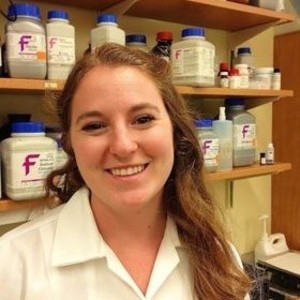
B.S. in Biochemistry 2012, Creighton University, Omaha, NE
Ph.D. 2018, Biochemistry, University of Notre Dame, Notre Dame, IN
Dissertation: Biophysical Analysis of Phosphatidylserine-Binding Proteins Lactadherin C2 and the Ebola Virus Matrix Protein VP40
Discipline: Biochemistry
Mentor: Robert V. Stahelin
CBBI Fellow: 2013-2015
Current Position: Senior Scientist, Treeline Biosciences, Watertown, MA
Katie’s project involves investigating the biophysical interactions between cellular membrane lipids and the Ebola Virus Matrix protein, VP40.
Internship
February – April 2014 Department of Immunology and Microbial Science, The Scripps Research Institute, La Jolla, CA: Mentor: Erica Olmann-Saphire. The goal of Katie’s project was elucidating lipid-protein interactions of Ebola virus protein 40 (VP$) with lipids found in the plasma membrane. The three major techniques explored were lipid-protein crystallography, isothermal titration calorimetry (ITC), and electron microscopy (EM).
Honors:
- CBBI Symposium Best Oral Presentation (May 2015)
- CBBI Symposium Best Poster Award (May 2014)
Publications:
- Del Vecchio K, Stahelin RV. Investigation of the phosphatidylserine binding properties of the lipid biosensor, Lactadherin C2 (LactC2), in different membrane environments. J Bioenger Biomembr. 2018 Feb; 50 (1):1-10. doi: 10.1007/s10863-018-9745-0. Epub 2018 Feb 10. PMID: 29426977 PMCID: PMC5820145.
- Del Vecchio, K.; Frick, C.T.; Gc J.B.; Oda, S.I.; Gerstman, B.S.; Saphire, E.O.; Chapagain, P.P.; Stahelin, R.V. A cationic, C-terminal patch and structural rearrangements in Ebola virus matrix VP40 protein control its interactions with phosphatidylserine. J Bio Chem. 2018, Mar 2; 293(9):3335-3349. doi: 10.1074/jbc.M117.816280. Epub 2018 Jan 18. PMID: 29348171 PMCID: PMC5836117.
- Del Vecchio, K, Stahelin, R.V. Using Surface Plasmon Resonance to Quantitatively Assess Lipid-Protein Interactions. Methods Mol. Bio. 2016, 1376, 141-153. PMID: 26552681 PMCID: PMC5964981.
David Dik
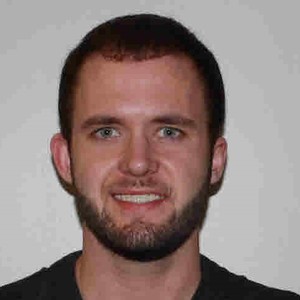
B.S. in Chemistry 2013, Hillsdale College, Hillsdale, MI
Ph.D. 2018, IBMS. University of Notre Dame, Notre Dame, IN
Dissertation: The Cross-talk Between Cell-wall recycling and Antibiotic Resistance of the Gram-negative Pathogen
Discipline: Biochemistry
Mentor: Shahriar Mobashery
CBBI Fellow: 2014-2016
Current Position: Principal Investigator, Calibr at Scripps Research Institute, La Jolla, CA
Research Project:
David’s Project focuses on the mechanisms of cell-wall recycling and antibiotic resistance in Gram-negative bacteria. One mechanism of resistance in many Gram-negative bacteria is the inducible AmpC βlactamase, which hydrolytically degrades the β-lactam ring of β-lactam antibiotics. The induction of AmpC β-lactamase is regulated by the protein AmpR. When β-lactam antibiotics are administered to a bacterial organism physiological changes occur in cell-wall peptidoglycan. A component of the altered cell wall is believed to derepress AmpR allowing for the transcription and translation of AmpC β-lactamase. His research aims to elucidate both the structure and function of this key regulatory protein in antibiotic resistance."
Internship:
May 2015 – July 2015, Consejo Superior de Investigaciones Cientificas (CSIC), Institute of Physical Chemistry “Rocasolano”, Madrid, Spain. Mentor: Juan Hermoso. David’s project involves co-crystallizing AmpR bound by both the transcriptional repressor and derepressor muropeptides. Focus on preparing samples for crytallization, diffracting cryatals, and solving protein structure. At conclusion will identify the ligand, which binds to the AmpR EBD resulting in the conformational change that activates of ampC transcription.
Honors:
- B.S. Honors, 2013
- Beta Beta Beta Honor Society
- Sigma Zeta Honor Society
Publications
- Dik, D.A.; Kim, C.; Madukoma, C.S.; Fisher, J.F.; Shrout, J.D.; Mobashery, S. Fluorescence Assessment of the AmpR-Signaling Network of Pseudomonas aeruginosa to Exposure to β-Lactam Antibiotics. ACS Chem Biol. 2020 Feb 10. doi: 10.1021/acschembio.9b00875. [Epub ahead of print] PMID: 31990176.
- Alcorlo, M.; Dik, D.A.; De Benedetti, S.; Mahasenan, K.V.; Lee, M.; Domínguez-Gil, T.; Hesek, D.; Lastochkin, E.; López, D.; Boggess, B.; Mobashery, S.; Hermoso, J.A. Structural basis of denuded glycan recognition by SPOR domains in bacterial cell division. Nat Commun. 2019 Dec 5;10(1):5567. doi: 10.1038/s41467-019-13354-4.PMID: 31804467.
- Dik, D.A.; Madukoma, C.S.; Tomoshige, S.; Kim, C.; Lastochkin, E.; Boggess, W.C.; Fisher, J.F.; Shrout, J.D.; Mobashery S. Slt, MltD, and MltG of Pseudomonas aeruginosa as Targets of Bulgecin A in Potentiation of β-Lactam Antibiotics. ACS Chem Biol. 2019 Feb 15;14(2):296-303. doi: 10.1021/acschembio.8b01025. Epub 2019 Jan 18. PMID: 30620575.
- Dik, D.A.; Batuecas, M.T.; Lee, M.; Mahasenan, K.V.; Marous, D.R.; Lastochkin, E.; Fisher, J.F.; Hermoso, J.A.; Mobashery S. A Structural Dissection of the Active Site of the Lytic Transglycosylase MltE from Escherichia coli. Biochemistry. 2018, Oct 23; 57(42):6090-6098. doi: 10.1021/acs.biochem.8b00800. Epub 2018 Oct 10. PMID: 30256085.
- Dik, D.A.; Fisher, J.F.; Mobashery, S. Cell-Wall Recycling of the Gram-Negative Bacteria and the Nexus to Antibiotic Resistance. Chem Rev. 2018 Jun 27; 118(12):5952-5984. doi: 10.1021/acs.chemrev.8b00277. Epub 2018 May 30. Review. PMID: 29847102.
- Tomoshige. S.; Dik. D.A.; Akabane-Nakata, M.; Madukoma, C.S.; Fisher, J.F.; Shrout, J.D.; Mobashery, S.Total Syntheses of Bulgecins A, B, and C and Their Bactericidal Potentiation of the β-Lactam Antibiotics. ACS Infect Dis. 2018 Jun 8;4(6):860-867. doi: 10.1021/acsinfecdis.8b00105. Epub 2018 May 7. PMID: 29716193.
- Lee, M.; Batuecas, M.T.; Tomoshige, S.; Domínguez-Gil, T.; Mahasenan, K.V.; Dik, D.A.; Hesek, D.; Millán, C.; Usón, I.; Lastochkin, E.; Hermoso, J.A.; Mobashery. S. Exolytic and endolytic turnover of peptidoglycan by lytic transglycosylase Slt of Pseudomonas aeruginosa. _ Proc Natl Acad Sci U S A._ 2018 Apr 24; 115(17):4393-4398. doi: 10.1073/pnas.1801298115. Epub 2018 Apr 9. PMID: 29632171.
- Byun, B.; Mahasenan, K.V.; Dik, D.A.; Marous, D.R.; Speri, E.; Kumarasiri, M.; Fisher, J.F.; Hermoso, J.A.; Mobashery, S. Mechanism of the Escherichia coli MltE lytic transglycosylase, the cell-wall-penetrating enzyme for Type VI secretion system assembly. Sci Rep. 2018 Mar 7;8(1):4110. doi: 10.1038/s41598-018-22527-y. PMID: 29515200.
- Domínguez-Gil, T.; Molina, R.; Dik, D.A.; Spink, E.; Mobashery, S.; Hermoso, J.A. X-ray Structure of Catenated Lytic Transglycosylase SltB1. Biochemistry. 2017 Dec 5; 56(48):6317-6320. doi: 10.1021/acs.biochem.7b00932. Epub 2017 Nov 16. PMID: 29131935.
- Dik, D.A.; Marous, D.R.; Fisher, J.F.; Mobashery, S. Lytic transglycosylases: concinnity in concision of the bacterial cell wall. Crit Rev Biochem Mol Biol. 2017 Oct; 52(5):503-542. doi: 10.1080/10409238.2017.1337705. Epub 2017 Jun 23. Review. PMID: 28644060.
- Lee, M.; Hesek, D.; Lastochkin, E.; Dik, D.A.; Boggess, B.; Mobashery, S. Deciphering the Nature of Enzymatic Modifications of Bacterial Cell Walls. Chembiochem. 2017 Sep 5;18(17):1696-1702. doi: 10.1002/cbic.201700293. Epub 2017 Jul 25. PMID: 28591487.
- Lee, M.; Hesek, D.; Dik, D.A.; Fishovitz, J.; Lastochkin, E.; Boggess, B.; Fisher, J.F.; Mobashery, S. From Genome to Proteome to Elucidation of Reactions for All Eleven Known Lytic Transglycosylases from Pseudomonas aeruginosa. Angew Chem Int Ed Engl. 2017 Mar 1;56(10):2735-2739. doi: 10.1002/anie.201611279. Epub 2017 Jan 27. PMID: 28128504.
- Dik, D.A.; Domínguez-Gil, T.; Lee, M.; Hesek, D.; Byun, B.; Fishovitz, J.; Boggess, B.; Hellman, L.M.; Fisher, J.F.; Hermoso, J.A.; Mobashery, S. Muropeptide Binding and the X-ray Structure of the Effector Domain of the Transcriptional Regulator AmpR of Pseudomonas aeruginosa. J Am Chem Soc. 2017 Feb 1; 139(4):1448-1451. doi: 10.1021/jacs.6b12819. Epub 2017 Jan 17.PMID: 28079369.
- Dominguez-Gila, T., Lee, M., Acebron-Avalosa, I., Mahasenan, K.V., Hesek, D., Byun, B., Lastochkin, E., Dik, D.A., Fisher, J.F., Mobashery, S., Hermoso, J.A. Activation by allostery in cell-wall remodeling by a modular membrane-bound lytic tranglycosylase from pseudomonas aeruginosa. Structure. 2016 Oct 4; 24(10):1729-1741. doi: 10.1016/j.str.2016.07.019. Epub 2016 Sep 8.PMID: 27618662.
Homero Domínguez

B.S. 2017, the University of Texas at Austin, Austin, TX
MS 2022, University of Notre Dame, Notre Dame, IN
Discipline: Chemistry
Mentor: Shahriar Mobashery
CBBI Fellow: 2019-2020
Current Position: Scientist, Senseonics, Germantown, MD
Research Project:
Homero's project is centered on targeting allostery in proteins for the design of antibiotics.
Honors
- Phi Kappa Phi Honor Society (2015)
- Outstanding Graduate Student Teacher (2019)
- GEM Associate Fellow (2019)
Michelle Favila
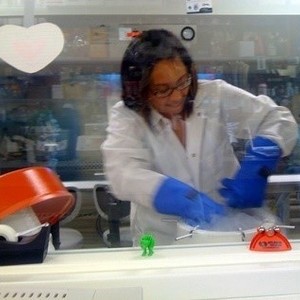
B.S. Biology and French 2005, Emory University, Atlanta, GA
Ph.D. 2013, Biological Sciences, University of Notre Dame, Notre Dame, IN
Dissertation: Host and Pathogenic Features that Drive Cellular
Discipline: Biology
Mentor: Mary Ann McDowell
CBBI Fellow: 2009- 2012
Current Position: Technology Transfer Manager National Cancer Institute, Bethesda, MD
Research Project:
Michelle is identifying the genes that are expressed in Leishmania major and Leishmania donovani to provide insight into the disease phenotypes observed. She is also conducting genetic analysis of the biosynthesis of the lipophosphoglycan on the parasite surface to elucidate factors important for parasite virulence. She conducted a research internship with Prof. Steven Beverley in the Department of Molecular Microbiology at Washington University School of Medicine and learned double targeted gene replacement techniques to generate two L. major null mutant parasites lacking LPG1 and LPG2 genes. She conducted a second internship in the laboratory of Prof. Salvatore Turco, Department of Molecular and Cellular Biochemistry at the University of Kentucky to isolate and identify the lipophosphoglycan structures.
Internship:
- Washington University School of Medicine, Department of Molecular Microbiology, St. Louis, MO Mentor: Professor Steven Beverley. Michelle’s research internship, she learned double targeted gene replacement techniques to generate two L. major null mutant parasites lacking LPG1 and LPG2 genes.
- University of Kentucky, Department of Molecular and Cellular Biochemistry, Lexington, KY Mentor; Professor Salvatore Turco. Michelle’s research internship was to isolate and identify the lipophosphoglycan structures.
Honors:
- Post baccalaureate NIH fellowship, 2005
- Post baccalaureate NIH fellowship, 2006
Publications:
- Favila, M.A.; Geraci, N.S.; Jayakumar, A.; Hickerson, S.; Mostrom, J.; Turco, S.J.; Beverley, S.M.; McDowell, M.A. Differential Impact of LPG-and PG-Deficient Leishmania major Mutants on the Immune Response of Human Dendritic Cells. PLoS Negl Trop Dis. 2015 Dec 2; 9(12):e0004238. doi: 10.1371/journal.pntd.0004238. eCollection 2015 Dec. PMID: 26630499 PMCID: PMC4667916.
- Favila, M.A.; Geraci, N.S.; Zeng, E.; Harker, B.; Condon, D.; Cotton, R.N.; Jayakumar, A.; Tripathi, V .; McDowell, M.A. Human dendritic cells exhibit a pronounced type I IFN signature following Leishmania major infection that is required for IL-12 induction. J Immunol. 2014 Jun 15; 192(12):5863-72. doi: 10.4049/jimmunol.1203230. Epub 2014 May 7. PMID: 24808365 PMCID: PMC4052223.
- Ricardo-Carter, C.; Favila, M.; Polando, R.E.; Cotton, R.N.; Bogard Horner, K.: Condon, D.; Ballhorn, W.; Whitcomb, J.P.; Yadav, M.; Geister, R.L.; Schorey, J.S.; McDowell MA. Leishmania major inhibits IL-12 in macrophages by signaling through CR3 (CD11b/CD18) and down-regulation of ETS-mediated transcription. Parasite Immunol. 2013 Dec; 35(12):409-20. doi: 10.1111/pim.12049. PMID: 23834512 PMCID: PMC4001918.
Rosanne Frederick

B.S. Biochemistry 2006, University of Texas, Arlington, TX
Ph.D. 2012, Biochemistry, University of Notre Dame, Notre Dame, IN
Dissertation: Immune Responses to Leishmania Spp Infection
Discipline: Biochemistry
Mentor: Jennifer Dubois
CBBI Fellow: 2008-2011
Current Position: Senior Scientist, Smith & Nephew, Inc. Fort Worth, TX
Research Project:
Rosie’s project centers on the characterization of the mechanism, structure, and inhibition of siderophore-associated monooxygenases from pathogenic microbes. Rosie uses molecular biology, protein biochemistry, structural biology, and synthetic organic chemistry. She is currently carrying out a research internship at Marquette University to learn protein NMR techniques that will provide insightful approaches in understanding small molecule/protein interactions.
Internship:
Marquette University, Milwaukee, WI. Rosie’s research internship was to learn protein NMR techniques that will provide insightful approaches to understanding small molecule/protein interactions.
Honors:
- McNair Scholar 2005-2006
- Keystone Symposia Scholarship– Antibiotics and Resistance: Challenges and Solutions (B3) Conference, funded by the Bill and Melinda Gates Foundation, February 2010
Publications
- Frederick, R.E.; Ojha, S.; Lamb, A.; Dubois, J.L. How pH modulates the reactivity and selectivity of a siderophore-associated flavin monooxygenase. Biochemistry. 2014 Apr 1; 53(12):2007-16. doi: 10.1021/bi401256b. Epub 2014 Mar 19. PMID: 24490904 PMCID: PMC3985866.
- Frederick, R.E.; Mayfield, J.A.; DuBois, J.L. Protein-level regulation of O2 activation in biosynthetic flavin-dependent monooxygenases. J. Am. Chem. Soc., 2011, 133(32), 12338–12341. doi: 10.1021/ja203397s. Epub 2011 Jul 26. PMID: 21774554 PMCID: PMC3391563
- Mayfield, J.A.; Frederick, R.E.; Streit, B.R.; Wencewicz, T.A.; Ballou, D.P.; DuBois, J.L. Comprehensive Spectroscopic, Steady State, and Transient Kinetic Studies of a Representative Siderophore-Associated Flavin Monooxygenase. J. Biol. Chem. 2010, 285, 30375-30388. doi: 10.1074/jbc.M110.157578. Epub 2010 Jul 22. PMID: 20650894 PMCID: PMC2945530.
- Frederick, R.E.; Mayfield, J.A.; DuBois, J.L. Iron Trafficking as an Antimicrobial Target. Biometals, 2009, 22 DOI10.1007/s10534-009-9236-1 (online published April 7, 2009).PMID: 19350396 PMCID: PMC3742301.
Thomas Frederick

B.S. 2010 Chemistry, University of Florida, Gainesville, FL
Ph.D. 2016 Biochemistry, University of Notre Dame, Notre Dame, IN
Dissertation: A New Basis for Signal Transduction in the Staphylococcal Aureus Beta-Lactam Sensor Protein Blar1
Discipline: Biochemistry
Mentor: Jeffry W. Peng
CBBI Fellow: 2013-2014
Current Position: Senior Scientist, AbbVie, Chicago, IL
Research Project:
Thomas’s research is focused on long-range order and signal transduction in BlaRS.
Publications:
- Zhang, M.; Frederick, T.E.; VanPelt, J.; Case, D.A.; Peng, J.W. Coupled intra- and interdomain dynamics support domain cross-talk in Pin1. J Biol Chem. 2020, 295. 16585-16603. PMID: 32963105. PMCID: PMC 7864058.
- Frederick, T.E.; Peng, J.W. A gratuitous β-Lactamase inducer uncovers hidden active site dynamics of the Staphylococcus aureus BlaR1 sensor domain. PLoS One. 2018 May 17; 13(5):e0197241. doi: 10.1371/journal.pone.0197241. eCollection 2018.PMID: 29771929 PMCID: PMC5957439.
- Staude, M.W.; Frederick, T.E.; Natarajan, S.V.; Wilson, B.D.; Tanner, C.E.; Ruggiero, S.T.; Mobashery, S.; Peng, J.W. Investigation of signal transduction routes within the sensor/transducer protein BlaR1 of Staphylococcus aureus. Biochemistry. 2015 Mar 3; 54(8):1600-10. doi: 10.1021/bi501463k. Epub 2015 Feb 18.PMID: 25658195 PMCID: PMC4691190.
- Frederick, T.E.; Wilson, B.D.; Cha, J.; Mobashery, S.; Peng, J.W. Revealing cell-surface intramolecular interactions in the BlaR1 protein of methicillin-resistant Staphylococcus aureus by NMR spectroscopy. Biochemistry. 2014 Jan 14; 53(1):10-2. doi: 10.1021/bi401552j. Epub 2013 Dec 24. PMID: 24359467 PMCID: PMC3939675.
Stefan Freed

B.A. Biology, 2010, DePauw University, Greencastle, IN
M.S. 2018, Biological Sciences, University of Notre Dame, Notre Dame, IN
Discipline: Biology
Mentor: Shaun W. Lee
CBBI Fellow: 2013-2015
Current Position: Scientist, Manufacturing at Elanco Animal Health, Indianapolis, IN
Research Project:
Stefan’s project focuses on the characterization of Propionilysin S, a secreted toxin recently acquired by select strains of the human skin colonizer Propionibacterium acnes
Internship:
June 2015- August 2015 Department of Chemistry, Indiana University, Bloomington, IN Mentor: James Reilly. Stefan’s research internship project uses mass spectrometry (including ultraviolet photo fragmentation) to characterize the heterocycle modifications made to substrate peptides from an in vitro synthetase reaction. Specific goal is to determine which of the potentially heterocyclizable residues in each substrate peptide are converted in the final product.
Honors
- DePauw Faculty Distinguished Scholar Award, DePauw University (2006-2010)
- Faculty Development Award for Merit, DePauw University (2009)
- Delta Chi Scholarship Award, DePauw University (2009)
Publications:
- Fields, F.R.; Freed, S.D.; Carothers, K.E.; Hamid, M.N.; Hammers, D.E.; Ross, J.N.; Kalwajtys, V.R.; Gonzalez, A.J.; Hildreth, A.D.; Friedberg, I.; Lee, S.W. Novel antimicrobial peptide discovery using machine learning and biophysical selection of minimal bacteriocin domains. Drug Dev Res. 2020, Feb; 81(1):43-51. doi: 10.1002/ddr.21601. Epub 2019 Sep 4. PMID: 31483516.
- Morton, J.T., Freed, S.D., Lee, S.W., Griedberg, I. A large scale prediction of bacteriocin gene blocks suggests a wide functional spectrum for bacteriocins. BCM Bioinformatics, 2015, 16, 381. doi: 10.1186/s12859-015-0792-9. PMID: 26558535 PMCID: PMC4642626.
- Ugrinov, K.G.; Freed, S.; Thomas, C.L.; Lee, SW. A Multiparametric Computational Algorithm for Comprehensive Assessment of Genetic Mutations in Mucopolysaccharidosis Type IIIA (Sanfilippo Syndrome). PLOS ONE. 2015, Mar 25; 10(3);e0121511.doi: 10.1371/journal.pone.0121511. eCollection 2015.PMID: 25807448 PMCID: PMC4373678.
- Fernandez-Pol, S.; Souka, Z.; Bhattacharjee, S.; Fedotova, Y.; Freed, S.; An, X.; Holder, A.A.; Campanella, E.; Low, P.S.; Mohandas, N.; Haldar, K. A Bacterial Phosphatase-like Enzyme of the Malaria Parasite Plasmodium Falciparum Possesses Tyrosine Phosphatase Activity and is Implicated in the REgulation of Band 3 Dynamics During Parasite Invasion. Eukaryotic Cell. 2013, Sep;12(9): 1179-91. doi: 10.1128/EC.00027-13. Epub 2013 Jul 3 PMID: 23825180 PMCID: PMC3811575.
- Flaherty, R.; Freed, S.; Lee, S. The Wide World of Ribosomally Encoded Bacterial Peptides. PLoS Pathogens. 2014, Jul 31; 10(7):e1004221. doi: 10.1371/journal.ppat.1004221. eCollection 2014 Jul. PMID: 25079075 PMCID: PMC4117583.
Cary Frick
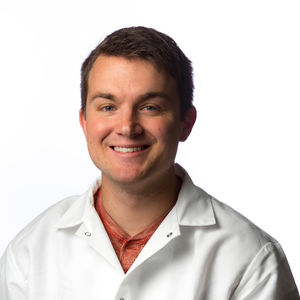
B.S. Biology and Chemistry, 2011, Whitworth University, Spokane, WA
M.S. 2017, Biochemistry, University of Notre Dame, Notre Dame, IN
Discipline: Biochemistry
Mentor: Robert Stahelin
CBBI Fellow: 2015-2016
Current Position: Adjunt Professor, Tacoma Community College, Tacoma, WA
Research Project:
Cary ‘s research on viral matrix protein 40 (VP40) of the Ebola Virus (EBOV). It remains unknown how and when VP40 interacts with these host cell factors, which is key to understanding how EBOV achieves egress from the cell to infect new cells. Cary’s goal is to elucidate the spatiotemporal nature of VP40 interactions with the host cell as well as the role of specific VP40 conformations in this process.
Honors
- Whitworth University Presidential Scholarship, 2008-2011
- Whitworth University Biology Departmental Scholarship, 2010, 2011
- Whitworth University Biology Talent Award, 2009, 2011
- Whitworth University Chemistry Departmental Scholarship, 2011
Publications:
- Scott, J.L.; Frick, C.T.; Johnson, K.A.; Liu, H.; Yong, S.S.; Varney, A.G.; Wiest, O.; Stahelin, R.V. Molecular Analysis of Membrane Targeting by the C2 Domain of the E3 Ubiquitin Ligase Smurf1.Biomolecules. 2020, Feb 4;10(2). pii: E229. doi: 10.3390/biom10020229. PMID: 32033048 PMCID: PMC7072158.
- Del Vecchio, K.; Frick, C.T.; Gc, J.B.; Oda, S.I.; Gerstman, B.S.; Saphire, E.O.; Chapagain, P.P.; Stahelin, R.V. A cationic, C-terminal patch and structural rearrangements in Ebola virus matrix VP40 protein control its interactions with phosphatidylserine. J Biol Chem. 2018, Mar 2; 293(9):3335-3349. doi: 10.1074/jbc.M117.816280. Epub 2018 Jan 18. PMID: 29348171 PMCID: PMC5836117.
- Gc, J.B.; Johnson, K.A.; Husby, M.L.; Frick, C.T.; Gerstman, B.S.; Stahlelin, R.V.; Chapagain, P.P. Interdomain Salt -bridges in the Ebola Virus Protein VP40 and their Role in Domain Association and Plasma Membrane Localization. Protein Sci. 2016, 25, 1648-1658. PMID: 27328459. PMCID: PMC5338242.
- Stahelin, R.V.; Scott, J.L.; Frick, C.T. Cellular and Molecular Interactions of Phosphoinositides and Peripheral Proteins. Chemistry and Physics of Lipids. 2014, 182, 3-18. doi: 10.1016/j.chemphyslip.2014.02.002. Epub 2014 Feb 17. PMID: 24556335 PMCID: PMC4484752.
Major Gooyit

B.S. Chemistry 2004, University of the Philippines
Ph.D. 2012, Chemistry, University of Notre Dame, Notre Dame, IN
Dissertation: Inhibition as a Therapeutic Approach for Treatment of Diseases of Matrix
Discipline: Organic Chemistry
Mentors: Mayland Chang and Shahriar Mobashery
CBBI Fellow: 2009-2012
Current Position: Associate Director, DMPK, Exscientia, Chicago, IL
Research Project:
Major’s project involves the syntheses and evaluation of variants of SB-3CT, a selective gelatinase inhibitor that shows efficacy in animal models of cancer metastasis and stroke, with higher potency and increased metabolic stability. He uses organic synthesis, enzyme kinetics, MS/MS experiments for identification of metabolites, pharmacokinetics, gelatin zymography, in situ gelatin zymography, and histology. Major conducted a research internship with Prof. Irit Sagi in the Department of Structural Biology, Weizmann Institute of Science, Rehovot, Israel, to crystallize MMP-9 in complex with the inhibitors, as well as overexpress and purify MMP-9 E402A mutant enzyme. He conducted a second research internship with Prof. Zezong Gu in the Department of Pathology and Anatomical Sciences at the University of Missouri-Columbia to assess the in vivo efficacy of the inhibitors in mouse models of stroke and traumatic brain injury.
Internships:
- July 2009 – September 2009, Weizmann Institute of Science, Department of Structural Biology, Rehovot, Israel Mentor: Professor Irit Sagi. Major’s research internship was to crystallize MMP-9 in complex with the inhibitors, as well as overexpress and purify MMP-9 E402A mutant enzyme.
- University of Missouri-Columbia, Department of Pathology and Anatomical Sciences, Columbia, MO Mentor: Professor Zezong Gu. Major’s research internship was to assess the in vivo efficacy of the inhibitors in mouse models of stroke and traumatic brain injury.
Honors:
- B.S. Honors, 2004
- Kaneb Outstanding Teaching Assistant Award, 2008
- 1st Place Presentation, CBBI Retreat, 2009
- Gordon Research Conference on Matrix Metalloproteinases Poster Award, 2011
- Gordon Research Seminar on Matrix Metalloproteinases Discussion Leader, 2011
Publications:
- Marusak, C.; Bayles.; Ma, J.;Gooyit, M.; Gao, M.; Chang, M.; Bedogni, B. The thiirane-based selective MT1-MMP/MMP2 inhibitor ND-322 reduces melanoma tumor growth and delays metastatic dissemination.
Pharmacol Res. 2016 Nov; 113(Pt A):515-520. doi: 10.1016/j.phrs.2016.09.033. Epub 2016 Sep 26. PMID: 27687955 PMCID: PMC5107128. - Gooyit, M.; Peng, Z.; Mobashery, S.; Chang, M. Thiirane class of gelatinase inhibitors as a privileged template that crosses the blood-brain barrier. In Privileged Scaffolds in Medicinal Chemistry: Design, Synthesis, Evaluation. Royal Society of Chemistry, Stefan Bräse, Ed., 2016, Chapter 10, 262-286.
- Gao, M.; Nguyen, T.T.; Suckow, M.A.; Wolter, W.R.; Gooyit, M.; Mobashery, S.; Chang, M. Acceleration of diabetic wound healing using a novel protease-anti-protease combination therapy. Proc Natl Acad Sci U S A.
2015, Dec 8; 112 (49):15226-31. doi: 10.1073/pnas.1517847112. Epub 2015 Nov 23. PMID: 26598687 PMCID: PMC4679041. - Semple, B.D.; Noble-Haeusslein, L.J.; Gooyit, M.; Tercovich, K.G.; Peng, Z.; Nguyen, T.T.; Schroeder, V.A.; Suckow, M.A.; Chang, M.; Raber, J.; Trivedi A. Early Gelatinase Activity Is Not a Determinant of Long-Term Recovery after Traumatic Brain Injury in the Immature Mouse. PLoS One. 2015 Nov 20; 10(11):e0143386. doi: 10.1371/journal.pone.0143386. eCollection 2015.PMID: 26588471.
- Lee, .; Chen, Z.; Tomlinson, B.N.; Gooyit, M.; Hesek, D.; Juárez, M.R.; Nizam, R.; Boggess, B.; Lastochkin, E.; Schroeder, V.A.; Wolter, W.R.; Suckow, M.A.; Cui, J.; Mobashery, S.; Gu, Z.; Chang, M. Water-Soluble MMP-9 Inhibitor Reduces Lesion Volume after Severe Traumatic Brain Injury. ACS Chem Neurosci. 2015 Oct 21; 6(10):1658-64. doi: 10.1021/acschemneuro.5b00140. Epub 2015 Aug 14.PMID: 26241578 PMCID: PMC5800744.
- Hadass, O.; Tomlinson, B.N.; Gooyit, M.; Chen, S.; Purdy, J.J.; Walker, J.M.; Zhang, C.; Giritharan, A.B.; Purnell, W.; Robinson, C.R. 2nd; Shin, D.; Schroeder, V.A.; Suckow, M.A.; Simonyi, A.; Sun, G.Y.; Mobashery, S.; Cui, J.; Chang, M.; Gu, Z. Selective inhibition of matrix metalloproteinase-9 attenuates secondary damage resulting from severe traumatic brain injury. PLoS One. 2013 Oct 23; 8(10):e76904. doi: 10.1371/journal.pone.0076904. eCollection 2013.PMID: 24194849 PMCID: PMC3806745.
- Gooyit, M.; Peng, Z.; Wolter, W.R.; Pi, H.; Ding, D.; Hesek, D.; Lee, M.; Boggess, B.; Champion, M.M.; Suckow, M.A.; Mobashery, S.; Chang, M. A chemical biological strategy to facilitate diabetic wound healing. _ ACS Chem Biol._ 2014 Jan 17;9(1):105-10. doi: 10.1021/cb4005468. Epub 2013 Sep 26.PMID: 24053680 PMCID: PMC3947039.
- Gooyit, M.; Song, W.; Mahasenan, K.V.; Lichtenwalter, K.; Suckow ,M.A.; Schroeder, V.A.; Wolter, W.R.; Mobashery, S.; Chang, M. O-phenyl carbamate and phenyl urea thiiranes as selective matrix metalloproteinase-2 inhibitors that cross the blood-brain barrier. J Med Chem. 2013, Oct 24; 56 (20):8139-50. doi: 10.1021/jm401217d. Epub 2013 Oct 8. PMID: 24028490 PMCID: PMC3880597.
- Song, W.; Peng, Z.; Gooyit, M.;, Suckow, M.A.; Schroeder, V.A.; Wolter, W.R.; Lee, M.; Ikejiri, M.; Cui, J.; Gu, .Z.; Chang, M. Water-soluble mmp-9 inhibitor prodrug generates active metabolites that cross the blood-brain barrier. ACS Chem Neurosci. 2013, Aug 21; 4(8):1168-73. doi: 10.1021/cn400077d. Epub 2013 May 30. PMID: 2368797 PMCID: PMC3750675.
- Gooyit, M.; Suckow, M.A.; Schroeder, V.A.; Wolter, W.R.; Mobashery, S.; Chang, M. Selective gelatinase inhibitor neuroprotective agents cross the blood-brain barrier. ACS Chem Neurosci. 2012 Oct 17; 3 (10):730-6. doi: 10.1021/cn300062w. Epub 2012 Jul 30. PMID: 23077716 PMCID: PMC3474282.
- Gooyit, M.; Lee, M.; Schroeder, V. A.; Ikeji, M.; Suckow, M.; Mobashery, S.; Chang, M. Selective water-soluble gelatinase inhibitor prodrugs. J. Med. Chem., 2011, 54, 6676-6690.doi: 10.1021/jm200566e. Epub 2011 Sep 6.PMID: 21866961 PMCID: PMC3190643.
- Gooyit, M.; Lee, M.; Hesek, D.; Boggess, B.; Oliver, A.; Fridman, R.; Mobashery, S.; Chang, M. Synthesis, kinetic characterization and metabolism of diastereomeric 2-(1-(4-phenoxyphenylsulfonyl)ethyl)thiiranes as potent gelatinase inhibitors. Chem Biol Drug Design, 2009, 74, 535-546. doi: 10.1111/j.1747-0285.2009.00898.×. Epub 2009 Oct 12. PMID: 19824893 PMCID: PMC2901852
Eve Granatosky

B.S. 2008, Biochemistry and Dance, Stonehill College, Easton, MA
Ph.D. 2018, Biochemistry, University of Notre Dame, Notre Dame, IN
Dissertation: Biosynthetic Access to the Gex1A Scaffold: A Novel Therapeutic Approach for Neimann-Pick Type C Disease
Discipline: Biochemistry
Mentor: Richard Taylor
CBBI Fellow:2013-2015
Current Position: Senior Associate, Lewis Burke Assoc. LLC, Washington, DC
Research Project:
Eve’s project is concerned with investigating the polyketide natural product herboxidiene (GEX1A), including biosynthesis and therapeutic potential in the context of the lysosomal storage disorder Niemann-Pick Type C (NPC) disease.
Internship
January 2014 – April 2014 Department of Chemistry and Biochemistry and Skaggs School of Pharmacy and Pharmaceutical Sciences, University of California San Diego, LaJolla, CA, Mentor: Pieter C. Dorrestein.
Eve’s focus during her project was to develop elementary mass spectrometry skills by collecting and analyzing spectra for a known compound (GEX1A or another standard). Additionally to apply the Dorrestein group’s ambient electrospray ionization flow-probe methodology to living S. chromofuscus colonies on Petri dishes and observe the organism’s metabolic output. Analyze both the bald and sporulating S. chromofuscus phenotypes, as well as co-cultures of S. Chromofuscus with other studied streptomycetes, to identify differences in metabolite production.
Honors
- John J. Reilley Center for Science, Technology, and Values Mini-Grant, support for the Science Policy Initiative at Notre Dame, 2015
- ASBMB Graduate Travel Award, ASBMB 2015 Annual Meeting, American Society for Biochemistry and Molecular Biology, 2015
- Capitol Hill Invitee, Public Affairs Advisory Committee, American Society for Biochemistry and Molecular Biology, Washington DC, 2014
- Sigma Zeta National Science and Mathematics Honor Society Inductee, 2012
- William C. LaPlante Memorial Scholarship, Stonehill College, North Easton, MA, 2012
- Travel Grant-in-Aid, Northeastern Section of the American Chemical Society, 2012
- Moreau honors Scholarship, Stonehill College, North Easton, MA, 2008-2012
Publications:
- Granatosky, E.A.; DiPrimio, N.; Pickering, J.R.E.; Stevens, D.C.; Perlstein, E.O.; Taylor, R.E. GEX1A, a Polyketide from Streptomyces chromofuscus, Corrects the Cellular Defects Associated with Niemann-Pick Type C1 in Human Fibroblasts. J Nat Prod. 2018, Sep 28; 81(9):2018-2025. doi: 10.1021/acs.jnatprod.8b00314. Epub 2018 Sep 6. PMID: 30188717 PMCID: PMC6868502.
- Wang, M.; Carver, J.J.; Phelan, V.V.; Sanchez, L.M.; Garg, N.; Peng, Y.; Nguyen, D.D.; Watrous, J.; Kapono, C.A.; Luzzatto-Knaan, T.; Porto, C.; Bouslimani, A.; Melnik, A.V.; Meehan, M.J.; Liu, W.T.; Crüsemann, M.; Boudreau, P.D.; Esquenazi, E.; Sandoval-Calderón, M.; Kersten, R.D.; Pace, L.A.; Quinn, R.A.; Duncan, K.R.; Hsu, C.C.; Floros, D.J.; Gavilan, R.G.; Kleigrewe, K.; Northen, T.; Dutton, R.J.; Parrot, D.; Carlson, E.E.; Aigle, B.; Michelsen, C.F.; Jelsbak, L.; Sohlenkamp, C.; Pevzner, P.; Edlund, A.; McLean, J.; Piel, J.; Murphy, B.T.; Gerwick, L.; Liaw, C.C.; Yang, Y.L.; Humpf, H.U.; Maansson, M.; Keyzers, R.A.; Sims, A.C.; Johnson, A.R.; Sidebottom, A.M.; Sedio, B.E.; Klitgaard, A.; Larson, C.B.; P, C.A.B.; Torres-Mendoza, D.; Gonzalez, D.J.; Silva, D.B.; Marques, L.M.; Demarque, D.P.; Pociute, E.; O’Neill, E.C.; Briand, E.; Helfrich, E.J.N.; Granatosky, E.A.; Glukhov, E.; Ryffel, F.; Houson, H., Mohimani, H.; Kharbush, J.J.; Zeng, Y.; Vorholt, J.A.; Kurita, K.L.; Charusanti, P.; McPhail, K.L.; Nielsen, K.F.; Vuong, L.; Elfeki, M.; Traxler, M.F.; Engene, N.; Koyama, N.; Vining, O.B.; Baric, R.; Silva, R.R.; Mascuch, S.J.; Tomasi, S.; Jenkins, S.; Macherla, V., Hoffman T, Agarwal, V.; Williams, P.G.; Dai, J.; Neupane, R.; Gurr, J.; Rodríguez, A.M.C.; Lamsa, A.; Zhang, C.; Dorrestein, K.; Duggan, B.M.; Almaliti, J.; Allard, P.M.; Phapale,P.; Nothias, L.F.; Alexandrov, T.; Litaudon, M.; Wolfender, J.L.; Kyle, J.E.; Metz, T.O.; Peryea. T.; Nguyen, D.T.; VanLeer, D.; Shinn, P.; Jadhav, A.; Müller, R.; Waters, K.M.; Shi, W.; Liu, X.; Zhang, L.; Knight, R.; Jensen, P.R.; Palsson, B.O.; Pogliano, K.; Linington, R.G.; Gutiérrez, M.; Lopes, N.P.; Gerwick, W.H.; Moore, B.S.; Dorrestein, P.C.; Bandeira, N. Sharing and Community Curation of Mass Spectrometry Data with Global Natural Products Social Molecular Networking. Nat Biotechnol. 2016, Aug 9; 34(8), 828-837. doi: 10.1038/nbt.3597. PMID: 27504778. PMCID: PMC5321674.
Brandon Haines
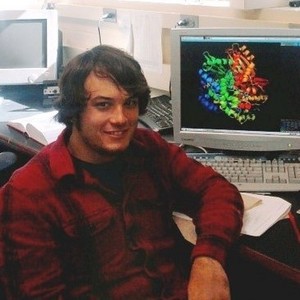
B.S. Chemistry 2009, Grand Valley State University
Ph.D. 2014, Chemistry, University of Notre Dame, Notre Dame, IN
Dissertation: Computational Studies on the Mechanism of HMG-COA Reductase and the Grignard SRN1 Reaction
Discipline: Organic Chemistry
Mentor: Olaf Wiest
CBBI Fellows: 2010-2012
Current Position: Assistant Professor, Westmont College, Santa Barbara, CA
Research Project:
Brandon is studying the mechanism of HMG-CoA reductase, an enzyme in the mevalonate pathway that produces cholesterol and other isoprenoids and the target of the cholesterol-lowering drugs statins. He uses Laue crystallography, organic chemistry, biophysics, and computational chemistry. He is currently conducting a research internship with Prof. Cynthia Stauffacher in the Department of Biological Sciences at Purdue University in structural biology. He uses site-directed mutagenesis and PCR to design and express a mutant form of HMG-CoA reductase, and then generate and resolve the crystal structure of the enzyme.
Internship:
Purdue University, Department of Biological Sciences, West Lafayette, IN Mentor: Professor Cynthia Stauffacher. Brandon’s research internship was in structural biology. He used site-directed mutagenesis and PCR to design and express a mutant form of HMG-CoA reductase, and then generate and resolve the crystal structure of the enzyme.
Honors:
- Grand Valley State University Sophmore Chemistry Award, 2006
- I Am Grand Valley Award, 2008
Publications:
- Clausen, D.J.; Smith, W.B.; Haines, B.E.; Wiest, O.; Bradner, J.E.; Williams, R.M. Modular synthesis and biological activity of pyridyl-based analogs of the potent Class I Histone Deacetylase Inhibitor Largazole. Bioorg Med Chem. 2015, Aug 1; 23(15):5061-74. doi: 10.1016/j.bmc.2015.03.063. Epub 2015 Mar 31. PMID: 26054247 PMCID: PMC4626217.
- Decroos, C.; Clausen, D.J.; Haines, B.E.; Wiest, O.; Williams, R.M.; Christianson, D.W. Variable active site loop conformations accommodate the binding of macrocyclic largazole analogues to HDAC8. Biochemistry. 2015, Mar 31;54(12):2126-35. doi: 10.1021/acs.biochem.5b00010. Epub 2015 Mar 20. PMID: 25793284 PMCID: PMC4382410.
- Haines, B.E.; Wiest, O. SET-induced biaryl cross-coupling: an S(RN)1 reaction. J Org Chem. 2014, Mar 21;79(6):2771-4. doi: 10.1021/jo500222d. Epub 2014 Mar 6. PMID: 24564385 PMCID: PMC3985438.
- Haines, B.E.; Wiest, O.; Stauffacher, C.V. The increasingly complex mechanism of HMG-CoA reductase. Acc Chem Res. 2013, Nov 19;46(11):2416-26. doi: 10.1021/ar3003267. Epub 2013 Jul 30. Review. PMID: 23898905 PMCID: PMC4118817.
- Haines, B.E.; Steussy, C.N.; Stauffacher, C.V.; Wiest, O. Molecular modeling of the reaction pathway and hydride transfer reactions of HMG-CoA reductase. Biochemistry. 2012, Oct 9;51(40):7983-95. doi: 10.1021/bi3008593. Epub 2012 Sep 25. PMID: 22971202 PMCID: PMC3522576.
Elizabeth Harper
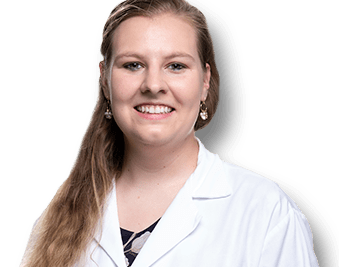
B.A. 2015, Earlham College, Richmond, IN
Ph.D. 2022, Biochemistry, University of Notre Dame, Notre Dame, IN
Dissertation: Integrative Analysis of the Aging Peritoneum in Metastatic Receptivity
Discipline: Biochemistry
Mentor: Sharon Stack
CBBI Fellow: 2019-2020
Current Position: Postdoc, Johns Hopkins, Baltimore, MD
Research Project:
Elizabeth's project involves working on how aging affects ovarian cancer metastatic success. Elizabeth will assess age-related changes to metastatic sites using a variety of imagining and biochemical techniques with in vivo, ex vivo, and in vitro models.
Internship:
Elizabeth will be interning the summer of 2020 working with Dr. Amanda Hummon at Ohio State University, an expert in mass spectrometry-based proteomics.
Honors:
- NIH F99 Predoc to Postdoc Transition Award(2020)
- Integrated Biomedical Sciences Program Recruitment Committee Member (2019)
- Interdisciplinary Interface Training Program(IITP) Grant, Harper Cancer Research Institute, University of Notre Dame (2018)
- Integrated Biomedical Sciences program GSU Representative, University of Notre Dame (2018)
- Integrated Biomedical Sciences Program Professional Development Chair, University of Notre Dame (2018)
Publications:
- Carey, P.; Low, E.; Harper, E.; Stack, M.S. Metalloproteinases in Ovarian Cancer. Int J Mol Sci. 2021, 22, 3403. PMID: 33810259.
- Liu,Y.; Yang, J.; Shi, Z.; Tan, X.; Jin, N.; O'Brien, C.; Ott, C.; Grisoli, A.; Lee, E.; Volk, K.; Conroy, M.; Franz, E.; Bryant, A.; Campbell, L.; Crowley, B.; Grisoli, S.; Alexandrou, A.T.; Li, C.; Harper, E.I.; Asem, M.; Johnson, J.; Leonard, A.; Santanello, K.; Klein, A.; Wang, Q.; Zhang, S.; Hilliard, T.S.; Stack M.S. In vivo selection of highly metastatic human ovarian cancer sublines reveals role for AMIGO2 in intra-peritoneal metastatic regulation. Cancer Letter. 2021, 503, 163-173. PMID: 33524500. PMCID: PMC7981259 (available on 2022-04-10).
- Asem. M.; Young, A.M.; Oyama, C.; Claure De La Zerda, A.; Lui, Y.; Yang, J.; Hilliard, T.S.; Johnson, J.; Harper, E.I.; Guldner, I.; Zhang, S.; Page-Mayberry, T.; Kaliney, W.J.; Stack, M.S. Host Wnt5a Potentiates Microenvironmental Regulation of Ovarian Cancer Metastasis. Cancer Res. 2020, 80(5):1156-1170. doi:10.1158/0008-5472. Can-19-1601. Epub 2020 Jan 13. PMID: 31932454.
- Harper, E.I.; Sheedy, E.F.; Stack, M.S. With Great Age Comes Great Metastatic Ability: Ovarian Cancer and the Appeal of the Aging Peritoneal Microenvironment. Cancers(Basel), 2018, 10, 230. PMID: 29996539, PMCID: PMC6070816.
- Loughran, E.A.; Leonard, A.K.; Hilliard, T.S.; Phan, R.C.; Yemc, M.G.; Harper, E.; Sheedy, E.; Klymenko, Y.; Asem, M.; Liu, Y.; Yang, J.; Johnson, J.; Tarwater, L.; Shi, Z.; Leevy, M.; Ravosa, M.J.; Stack, M.S. Aging Increases Susceptibility to Ovarian Cancer Metastasis in Murine Allograft Models and Alters Immune Composition of Peritoneal Adipose Tissue. Neoplasia. 2018, 20, 621-631. PMID: 29754071.
Jeffrey Henry

B.S. 2015, Louisiana State University, Baton Rouge, LA
Ph.D. 2020 Organic Chemistry, University of Notre Dame, Notre Dame, IN
Dissertation: The Design, Synthesis, and Biological Evaluation of Conformational Analogues of Dactylolide, Zampanolide and Gex1a
Discipline: Organic Chemistry
Mentor: Richard Taylor
CBBI Fellow: 2017-2019
Current Position: Scientist, Eisai, US, Cambridge, MA
Research Project:
Jeff’s research focuses on the synthesis and investigation of the biosynthesis of microtubule stabilizing agent, (-)-zampanolide. He is planning to conduct a research internship in the laboratories of Dr. Dan Sackett at the NIH to assess the biological activity of analogs in cancer cell lines. He also plans a second research internship with Prof. Cole Stevens at the University of Mississippi to learn chemoenymatic systhesis.
Jeff’s project also involves synthesis, conformational preferences, and biological activity of conformational analogues of the microtuble-stabilizing agents, (-)-Zampanolide and (-)-Dactyolide.
Internship
University of Mississippi. Oxford, MS. Mentor: Dr. Cole Stevens. Jeff’s internship provided experience in protein expression, isolation, purification and the development of cells, cell lysate, and isolated protein-based oxidation reactions for studies in the transformation of ambruticin J to ambruticin F.
Honors:
- NSF-IRES Fellowship (Summer 2016)
- Arthur J. Schmitt Leadership Fellowship in Science and Engineering (2015- present)
- 2019 Medicinal and Bioorganic Chemistry Foundation Scholar (2019)
- 2019 Harper Cancer Research Day Exceptional Trainee: Exceptional Team Science (2019)
- 2019 H.C. Brown Lecture Poster Award: Advances in Organic Synthesis (April 2019)
Publications
- Henry, J.; Wilson, M.; Mulligan, M.; Quinn,T.R.; Sackett, D.E.; Taylor, R.E. Synthesis, Conformational Preferences, and Biological Activity of Conformational Analogues of the Microtubule- Stabilizing Agents, (-)-Zampanolide and (-)-Dactylolide. MedChemComm, 2019, DOI: 10.1039/C9MD00164F. PMID: 31191870, PMCID: PMC6540953.
- Henry, J.; Posevins, D.; Yang,B.; Qiu, Y.; Bläckvall, J.E. Highly Selective Olefin-Assisted Pd(II)-Catalyzed Oxidative Alkynylation of Enallenes. Chem Eur J, 2017, 23, 7896-7899. PMID: 28440882
Jessica Hornick
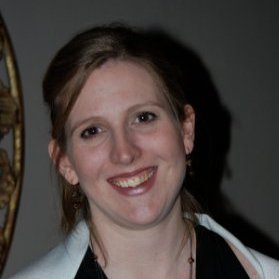
B.S. Biology 2001, University of Illinois, Chicago, IL
Ph.D. Biological Sciences 2009, University of Notre Dame
Dissertation: Mitotic Spindle Assembly: Microtubules and the Role of Centrosome
Discipline: Biology
Mentor: Edward Hinchcliffe
CBBI Fellow: 2008-2009
Current Position: Clinical Genomics Scientist, Myriad Genetics, Salt Lake City, UT
Research Project:
Jessica’s project focused on analyzing mitotic spindle formation and the role of centrosomes. She used microsurgery, biophysical techniques, and chemical biology to analyze spindle assembly.
Honors:
- Fisher Fellowship, 2004
- Pollard Fellowship, 2007
Publications
- Colliins, E. S.; Hornick, J. E.; Durcan, T. M.; Collins, N. S.; Archer, W.; Karanjeet, K. B.; Vaughan, K. T.; Hinchcliffe, E. H. Centrosome biogenesis continues in the absence of microtubules during prolonged S-phase arrest. J. Cell Physiol. 2010 May 10 {Epub ahead of print} PMID 20458743.
- Hornick, J. E.; Karanjeet, K.; Collins, E. S.; Hinchcliffe, E. H. Kinesins to the core: The role of microtubule-based motor proteins in building the mitotic spindle midzone. Semin. Cell Dev. Biol. 2010, 21, 290-299.
- Hornick, J.; Bader, J. R.; Tribble, E. K.; Breunig, J. S.; Halpin, E. S.; Vaughan, K. T.; Hinchcliffe, E. H. Live-cell analysis of mitotic spindle formation in taxol-treated cells. Cell Motil Cytoskeleton. 2008, 65, 595-613.
- Durcan, T. M.; Halpin, E. S.; Rao, T.; Collins, N. S, Tribble, E. K.; Hornick, J. E.; Hinchcliffe, E. H. Tektin 2 is required for central spindle microtubule organization and the completion of cytokinesis. J. Cell Biol. 2008, 181, 595-603.
- Walker, M.; Hjort, E.; Smith, S.; Hornick, J. E.; Hinchcliffe, E. H.; Hager, K. Toxoplasma gondi actively remodels the microtubule network in host cells. Microbes Infect. 2008, 10, 1440-1449.
- Whyte, J.; Bader, J. R.; Tauhata, S.; Raycroft, M.; Hornick, J. E.; Pfister, K.K.; Lane, W. S.; Chang, G. K.; Hinchcliffe, E. H.; Vaughan, P. S.; Vaughan, K. T. Phosphorylation regulates targeting of cytoplasmic dynein to kinetochores during mitosis. J. Cell Biol. 2008, 183, 819-834.
Monica Husby

BA 2010, Biology, Albion College, Albion, MI
MS 2017, Biological Sciences, University of Notre Dame, Notre Dame, IN
Discipline: Biological Sciences
Mentor: Robert Stahelin
CBBI Fellow: 2016-2017
Current Position: Medical Writer, Meditech Media
Research Project:
Monica’s project focused on the mechanisms of production of EBola virus-like particles. She plans to conduct a research internship in the laboratory of Prof. Shawn Campagna at the University of Tenessee to screen her compounds for in vitro activity against cancer cell lines and mouse cancer models.
Publications:
- Kilili, G.K.; Shakya, B.; Dolan, P.T.; Wang, L.; Husby, M.L.; Stahelin, R.V.; Nakayasu, E.S.; LaCount, D.J. The Plasmodium Falciparum MESA Erythrocyte Cytoskeleton-Binding (MEC) Motif Binds to Erythrocyte Ankyrin. Mol Biochem Parasitol. 2019, Jul; 231:111189. doi: 10.1016/j.molbiopara.2019.111189. Epub 2019 May 21. PMID: 31125575. PMCID: PMC7020240.
- Gc, J.B., Johnson, K.A., Husby, M.L., Frick, CT, Gerstman, B.S., Stahelin, R.V., Chapagain, P.P. Interdomain salt-bridges in the Ebola virus protein VP40 and their role in domain association and plasma membrane localization. Protein Sci. 2016 25, 1648-1658. PMCID: PMC55338242.
Francis Insaidoo

B.A. Biology and Chemistry 1999, St. John’s University, Collegeville, MN
M.S. Bioinformatics 2003, Georgia Institute of Technology, Atlanta, GA
Ph.D. Biochemistry 2010, University of Notre Dame
Dissertation: Dynamics of peptides bound to class I MHC proteins: Implications for T-cell receptor recognition in the immune response
Discipline: Biochemistry
Mentor: Brian Baker
CBBI Fellow: 2007-2009
Current Position: Associate Principal Scientist, Merck, Inc., New York, NY
Research Project:
Francis studied the influence of peptide dynamics on T cell receptor recognition, the type of immune response generated, and why certain peptide substitutions improve, while others abolish antigen specific recognition. He used NMR and molecular dynamics simulations to obtain atomic level information on the types of motion available to different peptides presented by class I MHC molecules. In addition, he developed a biosynthetic approach for the synthesis of isotopically labeled peptides and class I MHC proteins. Francis carried out an internship with Prof. David Kranz at the University of Illinois, Urbana-Champaign, conducting cellular and molecular experiments using yeast display, flow cytometry, PCR, and immunohistochemistry to address how dynamics in the T-cell receptor influence recognition of antigen.
Internship: University of Illinois, Urbana-Champaign, Champaign, IL Mentor: Professor David Kranz. Francis’s research internship was conducting cellular and molecular experiments using yeast display, flow cytometry, PCR, and immunohistochemistry to address how dynamics in the T-cell receptor influence recognition of antigen.
Honors:
- Newman Scholar, 2003
- Tower Award, 2003
- Gordon Conference Grant Recipient, 2006
Publications
- Davis-Harrison, R. L.; Insaidoo, F. K.; Baker, B. M. T Cell Receptor Binding Transition States and Recognition of Peptide/MHC. Biochemistry 2007, 46, 1840-1850.
- Borbulevych, O.Y.; Insaidoo, F. K.; Baxter, T. K.; Powell, D. J. Jr.; Johnson, L. A.; Restifo, N. P.; Baker, B. M. Structures of MART-1(26/27-35) Peptide/HLA-A2 Complexes Reveal a Remarkable Disconnect between Antigen Structural Homology and T Cell Recognition. J Mol Biol. 2007, 372, 1123-36.
- Armstrong, K. M.; Insaidoo, F. K.; Baker, B. M. Thermodynamics of T-cell receptor-peptide/MHC interactions: progress and opportunities. J Mol Recognit. 2008, 21, 275-287.
- Insaidoo, F. K.; Zajicek, J.; Baker, B. M. A general and effective approach for NMR studies of peptide dynamics in class I MHC peptide binding grooves. Biochemistry 2009, 48, 9708-9710.
- Aggen DH, Chervin AS, Insaidoo FK, Piepenbrink KH, Baker BM, Kranz DM. Identification and engineering of human variable regions that allow expression of stable single-chain T cell receptors. Protein Eng Des Sel. 2011, 24, 361-72.
- Insaidoo FK, Borbulevych OY, Hossain M, Santhanagopolan SM, Baxter TK, Baker BM. Loss of T cell antigen recognition arising from changes in peptide and major histocompatibility complex protein flexibility: implications for vaccine design. J Biol Chem. 2011, 286, 40163-73.
Giselle Jacobson

B.S. 2007, Chemistry, Grand Valley State University, MI
Ph.D. 2017, Biochemistry, University of Notre Dame, Notre Dame, IN
Dissertation: Effects of Translation Rate Changes on Protein Production, Folding and Fragmentation
Discipline: Biochemistry
Mentor: Patricia Clark
CBBI Fellow: 2013-2104
Current Position: Biophysics Facility Scientist, University of Notre Dame
Research Project:
Giselle’s research is to better understand the factors that affect translation rate in the cell and to investigate the conformations of the nascent chain on the ribosome. She looks at hydrogen-deuterium exchange measurements of co-translational protein folding.
Internship
May 2012 – June 2012 Department Chemistry, Indiana University, Bloomington, IN, Mentor: James Reilly
Giselle aimed to utilize H/D exchange to probe the conformations of the nascent GFP polypeptide on the E. coli ribosome. Additionally, her project was to develop a hydrogen-deuterium exchange mass spectometry methodology that can be applied to the ribosome-nascent chain complex. Using the lab’s synthetic skills, he worked to obtain a label that can enter bacterial cells for in vivo labeling and probing nascent chain conformations in the cell.
Honors
- Graduate School Professional Development Award, Notre Dame, 2014
- Transfer Award for Excellence, Grand Valley State University, 2007
- Dean’s List, Grand Valley State University, 2009-2010
- Dean’s List, Northwestern Michigan College, 2006-2007
- Michigan Merit Award, Michigan Education Assessment Program, 2006
Publications:
- Jacobson, G.N., Clark, P. Quality over Quantity: Optimizing Co-translational Protein Folding with Non-“Optimal Synonymous Codons”, Curr. Opin. Struc. Biol. 2016 , 38, 102-110. PMID: 27318814.
Cheng Ji

B.S. Chemistry 2007, Nanjing University, People’s Republic of China
Ph.D. 2012, Chemistry, University of Notre Dame, Notre Dame, IN
Dissertation: Bacterial Iron Acquisition from New Antibiotics to Pathogen Detection Devices
Discipline: Organic Chemistry
Mentor: Marvin Miller
CBBI Fellow: 2010-2011
Current Position: Senior Scientist, Abbvie, Chicago, IL
Research Project:
Cheng is utilizing the “Trojan Horse” approach to synthesize derivatives of phenolic propionic acid as linkers between siderophores (iron-chelating agents) and antibiotics. He is also using different linkers to prepare drug conjugates of the siderophore pyoverdine as novel antipseudomonal agents. He conducted a research internship with Prof. Ian Lamont in the Biochemistry Department at the University of Otago, New Zealand, to carry out biosynthesis of pyoverdines, including bacteria culture, isolation, purification, and characterization of pyoverdine, and bioassays against P. aeruginosa (inhibition assays, MIC, mutants isolation).
Internship:
June 2011 – August 2011 Biochemistry Department, University of Otago, Dunedin, New Zealand Mentor: Professor Ian Lamont. Cheng’s research internship was to carry out biosynthesis of pyoverdines, including bacteria culture, isolation, purification, and characterization of pyoverdine, and bioassays against P. aeruginosa (inhibition assays, MIC, mutants isolation).
Honors:
- Third Prize of People’s Scholarship, 2003
- Second Prize of People’s Scholarship, 2004
- First Prize, Specialty Scholarship, 2005
- Excellent Bachelor Thesis, 2007
Publications:
- Ji, C.; Miller, P.A.; Miller, M.J. Syntheses and Antibacterial Activity of N-Acylated Ciprofloxacin Derivatives Based on the Trimethyl Lock. ACS Med Chem Lett. 2015 May 11; 6(6):707-10. doi: 10.1021/acsmedchemlett.5b00146. eCollection 2015 Jun 11.PMID: 26101578 PMCID: PMC4468398.
- Ji, C.; Miller, M.J. Siderophore-fluoroquinolone conjugates containing potential reduction-triggered linkers for drug release: synthesis and antibacterial activity.Biometals. 2015, Jun; 28(3), 541-551. doi: 10.1007/s10534-015-9830-3. Epub 2015 Feb 8. PMID: 25663417. PMCID: PMC5808879.
- Ji, C.; Miller, P.A.; Miller, M.J. Iron transport-mediated drug delivery: practical syntheses and in vitro antibacterial studies of tris-catecholate siderophore-aminopenicillin conjugates reveals selectively potent antipseudomonal activity. J Am Chem Soc. 2012, Jun 20; 134(24), 9898-9901. doi: 10.1021/ja303446w. Epub 2012 Jun 6. PMID: 22656303. PMCID: PMC3380153.
- Ji, C.; Miller, M.J. Chemical Syntheses and In Vitro Antibacterial Activity of Two Desferrioxamine B-Ciprofloxacin Conjugates With Potential Esterase and Phosphatase Triggered Drug Release Linkers. Bioorg Med Chem. 2012, Jun 15; 20(12), 3828-36. doi: 10.1016/j.bmc.2012.04.034. Epub 2012 May 2. PMID: 22608921. PMCID: PMC3364023.
- Ji, C.; Lin, W.; Moraski, G.C.; Thanassi, J.A.; Pucci, M.J.; Franzblau, S.G.; Möllmann, U.; Miller M.J. Syntheses and Biological Studies of Novel Spiropiperazinyl Oxazolidinone Antibacterial Agents Using a Spirocyclic Diene Derived Acylnitroso Diels-Alder Reaction. Bioorg Med Chem. 2012, Jun 1; 20(11), 3422-3428. doi: 10.1016/j.bmc.2012.04.026. Epub 2012 Apr 18. PMID: 22560837. PMCID: PMC3363956.
- Ji, C.; Juárez-Hernández, R.E.; Miller, M.J. Exploiting Bacterial Iron Acquisition: Siderophore Conjugates. Future Med Chem. 2012, Mar; _ 4_(3), 297-313. doi: 10.4155/fmc.11.191. Review. PMID: 22393938.PMCID: PMC6901097
- Ji, C.; Miller, M.J. Cyclopropanation of Nitroso Diels-Alder Cycloadducts and Application to the Synthesis of a 2’,3’-Methano Carbocyclic Nucleoside. Tet. Lett 2010, Jul 1; 51(8), 3789-3791. PMID: 20607121. PMCID: PMC2894734.
Jeffrey Jones

B.S. 2014, Colorado School of Mines, Golden, CO
M.S. 2019 Analytical Chemistry, University of Notre Dame, Notre Dame, IN
Discipline: Chemistry
Mentor: Mayland Chang
CBBI Fellow: 2017-2019
Current Position:
Research Project:
Jeff’s research focuses on the role of matrix metalloprteinases (MMPs) in pressure ulcers. He is planning to conduct a research internship in the laboratory of Prof. Chris Overall at the University of British Columbia to conduct global proteomic studies on the effect of selective MMP inhibition. Jeff’s project also involves matrix metalloproteases and their roles in chronic wounds.
Honors: GRC Poster Preview Award (2019)
Publications:
-
Nguyen, T.T.; Jones, J.I. ; Wolter, W.R.; Pérez, R.L.; Schroeder, V.A.; Champion, M.M.; Hesek, D.; Lee, M.; Suckow, M.A.; Mobashery, S.; Chang, M. Hyperbaric Oxygen Therapy Accelerates Wound Healing in Diabetic Mice by Decreasing Active Matrix Metalloproteinase-9. Wound Repair Regen. 2020, 28(2):194-201. doi: 10.1111/wrr.12782. Epub 2019 Dec 3. doi:10.3390/ph12020079. Review. PMID: 31121851
-
Jones, J.I.; Nguyen, T.T.; Peng, Z.; Chang, M. Targeting MMP-9 in Diabetic Foot Ulcers. Pharmaceuticals, 2019, 12(2), 79. doi:10.3390/ph12020079.
- Nguyen, T.T.; Ding, D.; Wolter, W.; Pèrez, R.; Champion, M.M.; Mahasenan, K.V.; Hesek, D.; Lee, M.; Schroeder, V.A.; Jones, J.I., Lastochkin, E.; Rose, M.K.; Peterson, C.E.; Suckow, M.A.; Mobasher, S.; Chang, M. Validation of Matric Metalloproteinase-9(MMP-9) as a Novel Target for Treatment of Diabetic Foot Ulcers in Humans and Discovery of a Potent and Selctive Small-Molecule MMP-9 Inhibitor that Accelerates Healing. J. Med. Chem., 2018, 61, 8825-8837.
Trevor Kane

B.S. 2006, Molecular and Cellular Biology, University of Puget Sound, Tacoma, WA
Ph.D 2017, Biological Sciences, University of Notre Dame, Notre Dame, IN
Dissertation: Examination of a new virulence factor in a select strain of methicillin resistant Staphylococcus aureus
Discipline: Biology
Mentor: Shaun Lee
CBBI Fellow: 2013 -2014
Current Position: Patent Examiner, USPTO, Alexandria, VA
Research Project:
Trevor’s focus is on determining the function of a potential new virulence factor, The streptolysin-S associated gene cluster (sag) that has been acquired by specific strains to methicillin resistant Staphylococcus aureus (MRSA).
Honors
- Fellowship, Eck Institute for Global Health, Notre Dame, 2015
- Sprenger Memorial Scholarship in Chemistry for excellent academics and service
- Phi Eta Sigma Honor Society, undergraduate
Publications:
- Kane, T.L.; Carothers, K.E.; Lee, S.W. Virulence Factor Targeting of the Bacterial Pathogen Staphylococcus aureus for Vaccine and Therapeutics. Curr Drug Targets. 2018; 19(2):111-127. doi: 10.2174/1389450117666161128123536. Review. PMID: 27894236 PMCID: PMC5957279.
Kevin Kastner

B.S. 2006, Informatics, Baylor University, Waco, TX
M.S. 2008, Computer Science, Baylor University, Waco, TX
Ph.D. 2016, Computer Science, University of Notre Dame, Notre Dame, IN
Dissertation: Molecular Dynamics and Virtual Screening of the Octopamine Receptor
Discipline: Computer Science
Mentor: Jesus Izaguirre
CBBI Fellow: 2012-2013
Current Position: Software Developer Epic, Verona, WI
Research Project:
Kevin’s project is oriented to the design of new, more efficient and safer insecticides. His focus is on the inhibitions of receptors that are present in mosquitoes but not in humans, as it is the case of the octopamine receptors, classified as a G-Protein Couples Receptor
Internship
August – September 2012 Department of Chemical Biology, University of Michigan, Ann Arbor, MI, Mentor: Roger Sunahara
Kevin’s goal for his internship is to focus on experimental techniques used in the laboratory, such as doing x-ray crystallography, performing binding assays, and executing transfections as well as learning about protein-ligand interactions concerning GPCRs. He will also run and discuss results of simulations and dockings.
Publications:
- Kastner, K.W.; Izaguirre, J.A. Accelerated Molecular Dynamics Simulations of the Octopamine Receptor Using GPUs: Discovery of an Alternate Agonist-binding Position. Proteins 2016, 84(10), 1480-1489. https://doi.org/10.1002/prot.25091. PMID: 27318014 PMCID: PMC6993412.
- Kim, Y.H.; Kastner, K.; Abdul-Wahid, B.; Izaguirre, J.A.. Evaluation of conformational changes in diabetes-associated mutation in insulin a chain: a molecular dynamics study. Proteins. 2015 Apr; 83(4):662-9. doi: 10.1002/prot.24759. Epub 2015 Feb 5. PMID: 25641314 PMCID: PMC4382306.
- Kastner. K.W.; Shoue, D.A.; Estiu, G.L.; Wolford, J.; Fuerst, M.F.; Markley, L.D.; Izaguirre, J.A.; McDowell MA. Characterization of the Anopheles gambiae octopamine receptor and discovery of potential agonists and antagonists using a combined computational-experimental approach. Malar J. 2014, Nov 18; 13:434. doi: 10.1186/1475-2875-13-434. PMID: 25407998 PMCID: PMC4253978.
Bradley M. Keegan

B.S. 2013, Wake Forest University, Winston-Salem, NC
PhD. 2022, University of Notre Dame, Notre Dame, IN
Dissertation: Small Molecule Modulation of the Hsp90 Proteostatis Network for Neuropathic Protection
Discipline: Chemistry
Mentor: Brian S.J. Blagg
CBBI Fellow: 2018-2020
Current Position: Postdoctoral Fellow, NIH, Washington, DC
Research Project:
Brad’s research focuses on the design, synthesis, and evaluation of novel AHA1/Hsp90 inhibitors for reduction of tau aggregation in Alzheimer’s disease.. He is planning to conduct a research internship in the laboratory of Prof. Ionnis Gellis at the University of South Florida to conduct NMR CSP docking experiments to evaluate their binding to AHA1.
Internship:
March 2019- May 2019 -CNR, Milan, Italy. Mentor: Dr. Giorgio Colombo. Brad’s internship provided experience in computational modeling, ligand docking, and dynamic simulation experiments to discover novel binding pockets and mechanisms for Aha1/Hsp90 disruption.
Honors:
- Co-winner(EncepHeal Therapeutics), The Neuro Startup Challenge – National Institutes of Health (NIH) (2015)
- Graduate Student Travel Award, Experimental Biology – The American Society for Pharmacology & Experimental Therapeutics (ASPET) (2014)
- Certificate of Professional Education in Chemistry, The Committee on Professional Training – The American Chemical Society (ACS)
Publications:
- Merfeld, T.; Peng, S.; Keegan, B.M. (co-first author); Crowley, V.M.; Brackett, C.M.; McCann, N.R.; Reynolds, T.S., Rhodes, M.C.; Byrd, K.M.; Deng, J.; Matts, R.L.; Blagg, B.S.J. Elucidation of novel TRAP1-selective inhibitors that directly regulate mitrochondrial proceses with molecular precision, Nature Communications. 2022. submitted.
- Keegan, B.M.; Catalafano, K.C.; Banerjee, M.; Blagg, B.S.J. Synthesis and Evaluation of Small Molecule Disruptors of the Aha1/Hsp90 Complex for the Reduction of Tau Aggregation, ACS Med Chem Lett. 2022, 13, 827-832, PMID: 35586436. PMCID: Pmc9109267 (available on 2023-05012). DOI: 10.1021/acsmedchemlett.2c00064.
- Banerjee, M.; Hatial, I.; Keegan, B.M.; Blagg, B.S.J. Assay design and development strategies for finding Hsp90 inhibitors and their role in human diseases. Pharmacol Ther. 2021, 221,107747. PMID: 33245994.
- Tomašič, T.; Durcik, M.; Keegan, B. M.; Skledar, D. G.; Zajec, Ž.; Blagg, B.S.J.; Bryant, S. D. Discovery of Novel Hsp90 C-Terminal Inhibitors Using 3D-Pharmacophores Derived from Molecular Dynamics Simulations. Int. J. Mol. Sci. 2020, 21(18):E6898. doi; 10.3390/ijms2118688. PMID: 32962253.
- Chaudhury, S.; Keegan, B. M.; Blagg, B.S.J. The Role and Therapeutic Potential of Hsp90, Hsp70, and Smaller Heat Shock Proteins in Peripheral and Central Neuropathies. Med Res Rev. 2020, Aug 25. doi: 10.1002/med.21729. Online ahead of print. PMID: 32844464.
- Shi,T.; Wijeratne, E.M.K.; Solano, C.; Ambrose, A.J.; Ross, A.B.: Norwood, C.; Orido, C.K.; Grigoryan, T.; Tillotson, J.; Kang, M.; Luo, G.; Keegan, B.M.; Hu, W.; Blagg, B.S.J.; Zhang, D.D.; Guatilaka, A.A.L.; Chapman, E. An Isoform-Selective PTP1B Inhibitor Derived from Nitrogen-Atom Augmentation of Radicol. Biochemistry, 2019, 58, 3225-3231. doi: 10.1021/acs.biochem.9600499. PMID: 31298844.
Caitlin Kent

BS 2013, Chemistry and Biology, University of Saint Joseph University, Hartford, CT
Universtiy of Notre Dame, 2018-2019
Mentor: Brian Blagg
CBBI Fellow: 2018-2019
Current Position: Principal Scientist, Maplight Therapeutics, Palto Alto, CA
Research Project:
Caitlin’s Research focuses on the design, synthesis, and evaluation of second generation Hsp90 inhibitors. She is planning to conduct a research internship in the laboratory of Prof. Chrisostomos Prodromou at the University of Sussez to conduct co-crystallization studies of her compounds bound to Hsp90 isoforms.
Publications:
-
Mishra, S.; Liu, W.; Beebe, K.; Banerjee, M., Kent, C.N.; Munthali, V.; Koren, J.; Taylor, J.A.; Neckers, L.M.; Holzbeierlein, J.; Blagg, B.S.J. The Development of Hsp90β-Selective Inhibitors to Overcome Detriments Associated with pan-Hsp90 Inhibition. J. Med. Chem. 2021, 64, 1545-1557. PMID: 33428418.
-
Que, N.L.S.; Crowley, V.M.; Duerfeldt, A.S.; Zhao, J.; Kent, C.N.; Blagg, B.S.J.; Gewirth, D.T. Structure Based Design of a Grp94-Selective Inhibitor: Exploiting a Key Residue in GRP-94 to Optimize Paralog-Selective Binding. J Med Chem. 2018, 61, 2793-2805. PMCID: PMC5897183.
-
Knandelwal, A.; Kent, C.N.; Blach, M.; Peng, S.; Mishra, S.J.; Deng, J.; Day, V.W.; Liu, W.; Subramanian, C.; Cohen, M.; Holzbeierlein, J.M.; Matts, R.; Blagg, B.S.J. Structure-guided design of an Hsp90β N-terminal isoform-selective inhibitor. Nat Commun. 2018, 9, 425. PMCID: PMC5789826.
- Byrd, K.M.; Kent, C.N.; Blagg, B.S.J. Synthesis and Biological Evaluation of Stibene Analogues as Hsp90 C-Terminal Inhibitors. ChemMedChem. 2017, 12 2022-2029. PMCID: PMC5892432.
Charlotte Kunkler

B.A. 2016, Biochemistry, Ave Maria University, Ave Maria, FL
Ph.D. 2022 Biochemistry University of Notre Dame, Notre Dame, IN
Dissertation: Understanding the structural proprieties of triple helices and a triple-stranded RNA-binding protein
Discipline: Biochemistry
Mentor: Jessica A. Brown
CBBI Fellow: 2019-2020
Current Position: Scientist, Proliant Health and Biologicals, Ankeny, IA
Research Project:
Charlotte’s project involves understanding the structural properties of triple helices and a triple-stranded RNA-binding protein.
Internship:
September 13, 2021 - November 14, 2021. Max Planck Institute for Biophysical Chemistry, Göttingen, Germany. Mentor: Professor Henning Urlaub. Charlotte's internship involved sample preparation, hands-on training on using a mass spectrometer and how to analyze mass spectra of peptides containing cross linked nucleotides.
Honors
- NIH Ruth L. Kirschstein National Research Service Award Individual Predoctoral F31 Fellowship(2020)
- Ewha-Luce Internation Seminar (ELIS) Participant, Ewha Woman’s University, Seoul, South Korea (2018)
- Roger K. Bretthauer Graduate Teaching Award, University of Notre Dame (2017-2018)
Publications:
- Kunkler, C.N.; Schiefelbein, G.E.; O'Leary, N.J.; McCown, P.J.; Brown, J.A. A single RNA modification destabilizes an RNA•DNA-DNA triple helix. RNA. 2022. doi: 10.1261/rna.079244.122.
- McCown, P.J.; Ruszkowska, A.; Kunkler, C.N.; Breger, K.; Hulewicz, J.P; Wang, M.C.; Springer, N.A.; Brown, J.A. Naturally Occurring Modified Ribonucleosides. Wiley Interdiscip Rev RNA. 2020, e1595, doi: 10.1002wrna.1595. [online ahead of print]PMID: 32301288.
- Kunkler, C. N.; Hulewicz, J. P.; Hickman, S. C.; Wang, M. C.; McCown, P. J.; Brown, J. A. Stability of an RNA•DNA–DNA triple helix depends on base triplet composition and length of the RNA third strand. Nucleic Acids Res. 2019, 47 (14), 7213–7222.
Richard Kurker
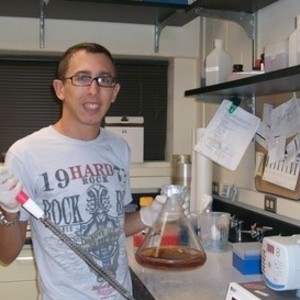
B.S. 2009, Providence College, Providence, RI
Ph.D 2013 Biochemistry, University of Notre Dame, Notre Dame, IN
Dissertation: Beyond 02: Biochemistry of Chlorite Dismutases from Klebsiella and Staphylococcus
Discipline: Biochemistry
Mentor: Jennifer Dubois
CBBI Fellow: 2011-2012
Current Position: Faculty, Bard High School Early College, Hartford, CT
Research Project:
Richard’s research focuses on HemQ, a protein in the CDE superfamily that is phylogenetically related to the well-characterized chlorite dismutase protein that converts chlorite to chloride and oxygen. HemQ is found exclusively in Gram-positive bacteria but does not respire chlorite, so the project is geared toward determining the function of the uncharacterized HemQ protein using techniques in biochemistry, molecular biology, and bioinformatics. Richard conducted a research internship in the laboratory of Prof. Eric Skaar at Vanderbilt University Medical Center in Nashville, TN, to gain experience with growing Staphylococcus aureus, produce genetic complementations for phenotype restoration, and prepare FLAG-tagged protein for use in in vivo immunoprecipitation.
Internship: Vanderbilt Unversity Medical Center, Nashville, TN. Mentor: Professor Eric Skaar. Richard’s research internship was conducted to gain experience with growing Staphylococcus aureus, produce genetic complementations for phenotype restoration, and prepare FLAG-tagged protein for use in in vivo immunoprecipitation.
Honors:
- Genomics and Bioinformatics Fellowship (University of Notre Dame Eck Institute of Global Health) (2010)
- Graduated with summa cum laude honors, Liberal Arts Honors Program, and Award for Highest GPA in Biochemistry (Providence College, 2009)
- Rev. Frederick C. Hickey, O.P. Science Award for academic excellence in chemistry/biochemistry (Providence College, 2009)
- First place poster prize at the MRSEC Summer Undergraduate Research Expo (University of Minnesota, 2008)
Publications:
- Celis, A.I.; Geeraerts, Z.; Ngmenterebo, D.; Machovina, M.M.; Kurker, R.C.; Rajakumar, K.; Ivancich, A.; Rodgers, K.R.; Lukat-Rodgers, G.S.; DuBois, J.L. A Dimeric Chlorite Dismutase Exhibits O2-Generating Activity and Acts as a Chlorite Antioxidant in Klebsiella pneumoniae MGH 78578. Biochemistry. 2015, Jan 20; 54(2), 434-446. doi: 10.1021/bi501184c. Epub 2014 Dec 19. PMID: 25437493. PMCID: PMC4303309.
- Mayfield, J.A.; Hammer, N.D.; Kurker, R.C.; Chen, T.K.; Ojha, S.; Skaar, E.P.; DuBois, J.L. The Chlorite Dismutase (HemQ) from Staphylococcus Aureus Has a Redox-Sensitive Heme and is Associated With the Small Colony Variant Phenotype. J Biol Chem. 2013, Aug 9; 288(32), 23488-23504. doi: 10.1074/jbc.M112.442335. Epub 2013 Jun 4. PMID: 23737523. PMCID: PMC5395028.
- Goblirsch, B.; Kurker, R.C.; Streit, B.R.; Wilmot, C.M.; DuBois, J.L. Chlorite Dismutases, DyPs, and EfeB: 3 Microbial Heme Enzyme Families Comprise the CDE Structural Superfamily. J Mol Biol. 2011, May 6; 408(3), 379-98. doi: 10.1016/j.jmb.2011.02.047. Epub 2011 Feb 25. PMID: 21354424. PMCID: PMC3075325.
Joshua Lee

B.S. Chemistry 2008, University of Minnesota, Twin Cities
Ph.D. 2014, Chemistry, University of Notre Dame, Notre Dame, IN
Dissertation: Computational Studies on the Mechanism and Stereochemistry of Lewis Acid-Catalyzed Aldol Condensations and Other Molecular Modeling Studies
Discipline: Organic Chemistry
Mentor: Paul Helquist and Olaf Wiest
CBBI Fellow: 2010-2011
Current Position: Intellectual Property Lawyer, Barnes & Thornburg LLP, Chicago, IL
Research Project:
Joshua’s project involves the syntheses of derivatives of archazolids and iejimalides, potent inhibitors of vacuolar ATPase, which cause death in cancer cells. He uses computational methods to screen libraries of chiral catalysts for vinologous Mukaiyama aldol reactions and select selective asymmetric catalysts. He will then conduct a QSAR study to screen inhibitors; selective inhibitors will be synthesized and tested for biological activity in vitro. He conducted a research internship with Prof. V. Jo Davisson in the Department of Medicinal Chemistry and Molecular Pharmacology at Purdue University to learn and develop biochemical and cell biology techniques to test the iejimalides and other ATPase inhibitors for biological activity in yeast, human cancer cell lines, and xenograft models.
Internship:
Purdue University, Department of Medicinal Chemistry and Molecular Pharmacology, W. Lafayette, IN Mentor: Professor V. Jo Davisson. Joshua’s research internship was to learn and develop biochemical and cell biology techniques to test the iejimalides and other ATPase inhibitors for biological activity in yeast, human cancer cell lines, and xenograft models.
Honors:
- Institute of Technology Honors Program
- Heisig/Gleysteen Chemistry Summer Fellowship Program
- Maroon Scholarship
Publications:
- Lee, J.M.; Zhang, X.; Norrby, P.O.; Helquist, P.; Wiest, O. Stereoselectivity in (Acyloxy)Borane-Catalyzed Mukaiyama Aldol Reactions. J Org Chem. 2016, Jul 1; 81(13), 5314-5321. doi: 10.1021/acs.joc.6b00594. Epub 2016 Jun 13. PMID: 27247023.
- Collins, C.G.; Lee, J.M.; Oliver, A.G.; Wiest, O.; Smith, B.D. Internal and External Stereoisomers of Squaraine Rotaxane Endoperoxide: Synthesis, Chemical Differences, and Structural Revision. J Org Chem. 2014, Feb 7; 79(3), 1120-1130. PMID: 24428682.
- Lee, J.M.; Helquist, P.; Wiest, O. Diastereoselectivity in Lewis-Acid-Catalyzed Mukaiyama Aldol Reactions: a DFT Study. J Am Chem Soc. 2012, Sep 12; 134(36), 14973-14981. doi: 10.1021/ja3052975. Epub 2012 Aug 31. PMID: 22891640. PMCID: PMC3465709.
Xin Liu

BS, Biological Sciences, 2007, Nankai University, People’s Republic of China
Ph.D. 2017, Biochemistry, University of Notre Dame, Notre Dame, IN
Dissertation: Evaluation of Therapeutics in Three Dimensional Cell Culture Systems Using Mass Spectrometry
Discipline: Biochemistry
Mentor: Amanda B. Hummon
CBBI Fellow: 2013-2014
Current Position: Principal Scientist, Novartis Institutes for Biomedical Research, Cambridge, MA
Research Project:
Xin’s research uses a 3D culture MALDI imaging system and serial trypsinization nLD-MS/MS approach to evaluate if a drug, with certain chemical features, can efficiently penetrate into a solid tumor. Moreover, by performing dynamic dosing of spheroids to mimic clinical PK curves of drugs, the properties of therapeutics can be more accurately evaluated.
Internship
April 2014 – May 2014 Department of Chemistry, Michigan State University, East Lansing, MI. Mentor: Dana M. Spence
Xin’s project used microfluidic-based systems combined with mass spectrometry techniques in three-dimensional (3D) multicellular spheroids model to study pharmacokinetics (PK) and pharmacodynamics (PD) properties of drugs. In collaboration with Dr. Spence’s lab, Xin optimized the membrane based fluidic device for drug loading and clearance in dosing the 3D cell culture systems to simulate simplified chemotherapy treatment regimes on the in vitro system. Xin learned to use quantification analytical method to control the drug concentrations in the dynamic system and analyze drug distribution in the spheroids model. Proteomic analysis in spheroids was then performed to evaluate the changes in protein level caused by drug treatment.
Honors:
- Tian Jin College of Life Science Basic Experimental Skills Contest, 2nd prize, 2009
- 1st Class School Scholarship, 2010
- “3-Good Student” (with good morality, a good intelligence, and good health) of Nankai University, 2010
- American Society for Mass Spectrometry Graduate Student Award, 2015
Publications
- Liu, X.; Lukowski, J.K.; Flinders, C.; Kim, S.; Georgiadis, R.A.; Mumenthaler, S.M.; Hummon A.B. MALDI-MSI of Immunotherapy: Mapping the EGFR-Targeting Antibody Cetuximab in 3D Colon-Cancer Cell Cultures. Anal Chem. * 2018*, Dec 18; 90(24), 14156-14164. doi: 10.1021/acs.analchem.8b02151. Epub 2018 Dec 7. PMID: 30479121.
- Liu, X.; Flinders, C.; Mumenthaler, S.M.; Hummon, A.B. MALDI Mass Spectrometry Imaging for Evaluation of Therapeutics in Colorectal Tumor Organoids. J Am Soc Mass Spectrom. 2018, Mar; 29(3), 516-526. doi: 10.1007/s13361-017-1851-4. Epub 2017 Dec 5. PMID: 29209911. PMCID: PMC5839975.
- Feist,P.E.; Sidoli, S.; Liu, X.; Schroll, M.M.; Rahmy, S.; Fujiwara, R.; Garcia, B.A.; Hummon, A.B. Multicellular Tumor Spheroids Combined with Mass Spectrometric Histone Analysis to Evaluate Epigenetic Drugs. Anal Chem. 2017, Mar 7; 89(5), 2773-2781. doi: 10.1021/acs.analchem.6b03602. Epub 2017 Feb 21. PMID: 28194967. PMCID: PMC5371507.
- Liu, X.; Hummon, A.B. Chemical Imaging of Platinum-Based Drugs and Their Metabolites. Sci Rep. 2016, Dec 5; 6, 38507. doi: 10.1038/srep38507. PMID: 27917942. PMCID: PMC5137023.
- Schroll, M.M.; Liu, X.; Herzog, S.K.; Skube, S.B.; Hummon, A.B. Nutrient Restriction of Glucose or Serum Results in Similar Proteomic Expression Changes in 3D Colon Cancer Cell Cultures. Nutr Res. 2016, Oct; 36(10), 1068-1080. doi: 10.1016/j.nutres.2016.08.002. Epub 2016 Aug 14. PMID: 27865348. PMCID: PMC5119765.
- Feist, P.E.; Sun, L.; Liu, X.; Dovichi, N.J.; Hummon, A.B. Bottom-Up Proteomic Analysis of Single HCT 116 Colon Carcinoma Multicellular Spheroids. Rapid Commun Mass Spectrom. 2015, Apr 15; 29(7), 654-8. doi: 10.1002/rcm.7150. PMID: 26212283. PMCID: PMC4763982.
- Liu, X.; Hummon, A.B. Mass Spectrometry Imaging of Therapeutics from Animal Models to Three-Dimensional Cell Cultures. Anal Chem. 2015, Oct 6; 87(19), 9508-9519. doi: 10.1021/acs.analchem.5b00419. Epub 2015 Jul 2. Review. PMID: 26084404. PMCID: PMC4766864.
- Liu, X.; Hummon, A.B. Quantitative determination of irinotecan and the metabolite SN-38 by nanoflow liquid chromatography-tandem mass spectrometry in different regions of multicellular tumor spheroids. J Am Soc Mass Spectrom. 2015, Apr; 26(4), 577-586. doi: 10.1007/s13361-014-1071-0. Epub 2015 Jan 21. PMID: 25604392. PMCID: PMC4361235.
- Ahlf Wheatcraft, D.R., Liu, X.; Hummon, A.B. Sample preparation strategies for mass spectrometry imaging of 3D cell culture models. J Vis Exp. 2014, Dec 5; 94. doi: 10.3791/52313. PMID: 25549242. PMCID: PMC4396945.
- Liu, X.; Weaver, E.M.; Hummon, A.B. Evaluation of therapeutics in three-dimensional cell culture systems by MALDI imaging mass spectrometry. Anal Chem. 2013, Jul 2; 85(13), 6295-6302. doi: 10.1021/ac400519c. Epub 2013 Jun 11. PMID: 23724927. PMCID: PMC4118837.
Brendan Mahoney
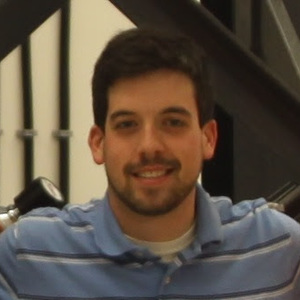
B.S. in Biochemistry and Molecular Biology, 2009, Boston University, Boston, MA
Ph.D. 2018, Biochemistry, University of Notre Dame, Notre Dame, IN
Dissertation: Understanding Atomic Mechanisms of Post-Translational Phosphorylation in Cell Signaling Proteins
Discipline: Biochemistry
Mentor: Jeffrey W. Peng
CBBI Fellow: 2014-2016
Current Position: Postdoctoral Fellow, University of California, Los Angles, CA
Research Project:
Brendan’s project is focused on the effects of post-translational modifications on the modular protein function.
Internship
January – March 2016 The Scripps Research Institute, Department of Chemistry, La Jolla, CA: Mentor: Peter G. Shultz. The goal of Brendan’s internship is to learn the chemical synthesis of the analog, p-Carboxymethyl-L-phenylalanine, which requires 4 steps from the commercially available 4(Bromomethyl)phenylacetic acid. Additionally, would receive training on the incorporation of this unnatural amino acid into E. coli and the Pin1 protein by means of the modified codon system.
Honors:
- Roger K. Bretthauer Graduate Teaching Award (2015)
- Kaneb Center Outstanding Graduate Student Teaching Award (2013)
Publications:
- Mahoney, B.J.; Zhang, M.; Zintsmaster, J.S.; Peng, J.W. Extended Impact of Pin1 Catalytic Loop Phosphorylation Revealed by S71E Phosphomimetic. J Mol Biol. 2018, Mar 2; 430(5), 710-721. doi: 10.1016/j.jmb.2017.12.021. Epub 2018 Jan 6. PMID: 29317221.
- Wang, X.; Zintsmaster, J.S.; Mahoney B.J.; Zhang, M.; Peng, J.W.; Negative Regulation of Peptidyl-Prolyl Isomerase Activity by Interdomain Contact in Human Pin1_. Structure 2015 Dec 1; 23(12):2224-2233. doi: 10.1016/j.str.2015.08.019. Epub 2015 Oct 22. PMID: 26602185 PMCID: PMC4670574.
- Mercedes-Camacho. A.Y.; Mullins, A.B.; Mason, M.D.; Xu, G.G.; Mahoney, B.J.; Wang, X.; Peng, J.W.; Etzkorn. F.A. Kinetic Isotope Effects Support the Twisted Amide Mechanism of Pin1 Peptidyl-Prolyl Isomerase. Biochemistry. 2013, Nov 5, 52(44):7707-13. doi: 10.1021/bi400700b. Epub 2013 Oct 24. PMID: 24116866 PMCID: PMC3891376
Maria Cristina Miranda Vergara

Degree: M.S. 2007, Instituto de Biotechnologia, Cuernavaca, Morelos, Mexico
Ph.D. 2022, Biochemistry, University of Notre Dame, Notre Dame, IN
Dissertation: Microenvironmental Changes by Stromal MMP3 Regulate Primary Tumor Growth and Lung Metastasis in Breast Cancer
Discipline: Biochemistry
Mentor: Laurie E. Littlepage
CBBI Fellow: 2017- 2019
Current Position: Professor/Researcher Biotechnology Department, UPAEP University, Puebla State, Mexico
Research Project:
Maria Cristina's research focuses on investigating the tumor and microenvironment roles of matrix metalloproteinase-3(MMP-3) during breast cancer. She has identified antagonistic roles for MMP-3 when produced by the stromal tissue comparted to the epithelial cells.
Internship:
Technical University of Denmark, Kongens Lyngby, Denmark. Mentor: Dr. Ulrich Auf dem Keller. She identified in vivo substrates and or/binding partners of MMP-3 by mass spectrometry.
Honors
- 2019 AAUW International Doctoral Fellowship
- 2019 Harper Cancer Research Institute, Research Day, Exceptional Team Science Award
- 2018 Sigma-Xi Grant-in-Aid of Research Program Awardee
- 2018 Exceptional Patient Advocacy Award. Harper Cancer Research Institute, University of Notre
Publications:
- Dai, C.; Charlestin, V.; Wang, M.; Walker, Z.T.; Miranda-Vergara, M.C.; Facchine, B.A.; Wu, J.; Kaliney, W.J.; Dovichi, N.J.; Li, J.; Littlepage, L.E. Aquaporin-7 Regulates the Response to Cellular Stress in Breast Cancer.Cancer Res. 2020, 80(19):4071-4086. doi: 10.1158/0008-5472. Can-19-2269. Epub 2020 Jul 6. PMID: 32631905.
-
Romero-Moreno, R.; Curtis, K. J.; Coughlin, T. R.; Miranda-Vergara, M.C.; Dutta, S.; Natarajan, A.; Facchine, B.A.; Jackson, K.M.; Nystrom, L.; Li, J.; Kaliney, W.; Niebur, G.L.; Littlepage, L.E. The CXCL5/CXCR2 Axis is Sufficient to Promote Breast Cancer Colonization During Bone Metastasis. Nature Communications. 2019, doi.org/10.1038/s41467-019-12108-6.
Christine Monteleon
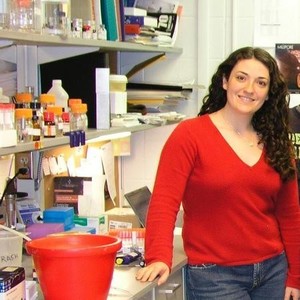
B.S. Biology 2005, University of Michigan, Ann Arbor, MI
Ph.D. Biology 2011, University of Notre Dame, Notre Dame, IN
Dissertation: Investigating ARF6 depletion in glandular organization and matrix remodeling
Discipline: Biology
Mentor: Crislyn D’Souza-Schorey
CBBI Fellow: 2008-2010
Current Position: Senior Scientist, Turn Biotechnologies, Mountain View, CA
Research Project:
Christine studied the mechanisms of epithelial gland development and its altered regulation during tumor progression. She began interdisciplinary investigations into the properties of the basement membrane with the University of Notre Dame Aerospace & Mechanical Engineering Department. She conducted a research internship with Prof. Sherry Voytik-Harbin in the Department of Biomechanical Engineering at Purdue University examining the physical and mechanical properties of extracellular matrix in response to epithelial morphogenesis.
Internship:
Purdue University, Department of Biomechanical Engineering, W. Lafayette, IN Mentor: Professor Sherry Voytik-Harbin. Christine’s research internship was examining the physical and mechanical properties of the extracellular matrix in response to epithelial morphogenesis.
Honors:
- UMBS Scholarship, 2004
- Reilly Fellowship, 2005
- Reilly Fellowship, 2006
- Warner-Lambert Fellowship, 2007
Publications
- Monteleon, C.L.; Sedgwick, A.; Hartsell, A.; Dai, M.; Whittington, C.; Voytik-Harbin, S.; D’Souza-Schorey C. Establishing Epithelial Glandular Polarity: Interlinked Roles for ARF6, Rac1, and the Matrix Microenvironment. Mol Biol Cell. 2012, Dec; 23(23), 4495-505. doi: 10.1091/mbc.E12-03-0246. Epub 2012 Oct 10. PMID: 23051733. PMCID: PMC3510012.
- Monteleon, C.L.; D’Souza-Schorey, C. Modeling Disease Using Three Dimensional Cell Culture: Multi-Lumen and Inverted Cyst Phenotypes. Front Biosci (Elite Ed). 2012, Jun 1; 4, 2764-71. Review. DOI: 10.2741/e590 PMID: 22652685.
Janeala Morsby

B.S.2018, Claflin University, Orangeburg, South Carolina
PhD.2023, Biochemistry, University of Notre Dame, Notre Dame, IN
Disseration: Enzyme Responsive Molecular Probes for biomedical Optical Diagnostics and Imaginig
Discipline: Biochemistry
Mentor: Bradley Smith
CBBI Fellow: 2020-2022
Current Position: Postdoc, St. Jude Children's Hospital, Memphis, TN
Research Project:
Janeala's research project focuses on developing an Affordable, Sensitive, Specific, User-friendly, Rapid, and robust, Equipment-free, and Deliverable (ASSURED) method for the early detection of chronic kidney disease. More specifically, she will design test strips that provide a colorimetric response in the presence of the NAG enzyme (a biomarker for kidney damage). In another aspect of her project, Janeala will utilize a standard glucose meter for a new NAG enzyme detection application using a novel NAG-Paracetamol probe.
Internship:
May 1, 2021 - July 10, 2021, University of Notre Dame, Notre Dame, IN. Mentor: Professor Jon Camden. Janeala's internship involved studying and quantifying enzyme levels using Surface Enhanced Raman spectroscopy (SERS), perform nanoparticle substrate synthesis and evaluate the stability of mercaptopyridine nitrile in competitive solvents.
Publications:
- Atkinson, K.M.; Morsby,J.J.; Kommidi,S.S.R.; Smith, B.D.;Generalizable synthesis of bioresponsive near-infrared fluorescent probes: sulfonated heptamethine cyanine prototype for imaging cell hypoxia. Org.BiomolChem, 2021.doi.org/10.1039/D1OB00426C" Advance Article.
- Morsby, J.; Dharmarwardana, M.; McGarraugh, H.; Smith, B. D. Supramolecular optimization of the visual contrast for colorimetric indicator assays that release resorufin dye. Chem Commun, 2020. doi.org/10.1039/D0CC03551C.
- Padilla-Coley, S.; Xu, H.; Morsby, J.; Gao, H.; Smith, B. D. Supramolecular Loading of a Broad Spectrum of Molecular Guests Inside Hyperbranched Polytriazole Nanoparticles with Cores Containing Multiple Functional Groups. Biomacromolecules, 2020, 21(6):2165-2175. Epub 2020 Apr 10. Doi: 10.1021/acs.biomac.0c00151. PMID:32227988.
Trung Nguyen

B.A. 2006, Biochemistry, California Lutheran University
Ph.D. 2018, Biochemistry, University of Notre Dame, Notre Dame, IN
Dissertation: Roles of MMPs in wound healing
Discipline: Biochemistry
Mentor: Shahriar Mobashery and Mayland Chang
CBBI Fellow: 2015-2017
Current Position: Business Development Manager, SRI, Menlo, CA
Research Project:
Trung’s research investigates and elucidates the roles of matrix metalloproteinases (MMPs) in wound healing. He uses the novel inhibitor-tethered resin technology from the lab to identify specific and active MMPs that are involved in human chronic wounds, as has been accomplished with the mouse model. Profiling MMPs from chronic wounds will open the doors for pharmacological intervention in this disease for which there is no approved drug.
Honors
- Dean’s List, California Lutheran University, 2008-2010
- Swenson’s Scholar of Research Recipient, California Lutheran University, 2009
- Cum Laude and Departmental Research Honor, California Lutheran University, 2010
- Research Honors Award, California Lutheran University, 2008-2010
Publications:
- Gabriel, C.E.R.; Nguyen, T.T.; Gargano, E.M.; Fisher, J.F.; Chang, M.; Mobashery S. Metabolism of the Selective Matrix Metalloproteinase-9 Inhibitor ( R)-ND-336. ACS Pharmacol Transl Sci. 2021, 4,1204-1213. PMID: 34151210.
- Chang, M.; Nguyen, T.T. Strategy for Treatment of Infected Diabetic Foot Ulcers. Acc Chem Res. 2021, 54, 1080-1093. PMID: 33596041.
- Nguyen, T.T.; Wolter, W.R.; Anderson, B.; Schroeder, V.A.; Gao, M.; Gooyit, M.; Suckow, M.A.; Chang, M. Limitations of Knockout Mice and Other Tools in Assessment of the Involvement of Matrix Metalloproteinases in Wound Healing and the Means to Overcome Them. ACS Pharmacol Transl Sci. 2020, 3, 489-495. PMID: 32566914.
- Nguyen, T.T.; Jones, J.I.; Wolter, W.R.; Pérez, R.L.; Schroeder, V.A.; Champion, M.M.; Hesek, D.; Lee. M.; Suckow. M.A.; Mobashery, S.; Chang, M. Hyperbaric oxygen therapy accelerates wound healing in diabetic mice by decreasing active matrix metalloproteinase-9. Wound Repair Regen. 2020 Mar; 28(2):194-201. doi: 10.1111/wrr.12782. Epub 2019 Dec 3.PMID: 31736209.
- Jones, J.I.; Nguyen, T.T.; Peng, Z.; Chang, M. Targeting MMP-9 in Diabetic Foot Ulcers. Pharmaceuticals (Basel). 2019, May 22; 12(2). pii: E79. doi: 10.3390/ph12020079. Review. PMID: 31121851.
- Nguyen, T.T.; Ding, D.; Wolter, W.R.; Pérez, R.L.; Champion, M.M.; Mahasenan, K.V.; Hesek, D.; Lee, M.; Schroeder, V.A.; Jones, J.I.; Lastochkin, E.; Rose, M.K.; Peterson, C.E.; Suckow, M.A.; Mobashery, S.; Chang, M. Validation of Matrix Metalloproteinase-9 (MMP-9) as a Novel Target for Treatment of Diabetic Foot Ulcers in Humans and Discovery of a Potent and Selective Small-Molecule MMP-9 Inhibitor That Accelerates Healing. J Med Chem. 2018, Oct 11; 61(19), 8825-8837. doi: 10.1021/acs.jmedchem.8b01005. Epub 2018 Sep 27. PMID: 30212201. PMCID: PMC6630664.
- Mahasenan, K.V.; Ding, D.; Gao, M.; Nguyen, T.T.; Suckow, M.A.; Schroeder, V.A.; Wolter, W.R.; Chang, M.; Mobashery, S. In Search of Selectivity in Inhibition of ADAM10. ACS Med Chem Lett. 2018, Jun 11; 9(7), 708-713. doi: 10.1021/acsmedchemlett.8b00163. eCollection 2018 Jul 12. PMID: 30034605. PMCID: PMC6047167.
- Nguyen, T.T.; Ding, D.; Wolter, W.R.; Champion, M.M.; Hesek, D.; Lee, M.; Pérez, R.L.; Schroeder, V.A.; Suckow, M.A.; Mobashery, S.; Chang M. Expression of Active Matrix Metalloproteinase-9 as a Likely Contributor to the Clinical Failure of Aclerastide in Treatment of Diabetic Foot Ulcers. Eur J Pharmacol. 2018, Sep 5; 834, 77-83. doi: 10.1016/j.ejphar.2018.07.014. Epub 2018 Jul 19. PMID: 30012502. PMCID: PMC6205151.
- Nguyen, T. T.; Mobashery, S.; Chang, M. Roles of Matrix Metalloproteinases in Cutaneous Wound Healing. In “Wound Healing: New Insights into Ancient Challenges”, Alexandrescu, V. A. (Editor), 2016, Chapter 3, p. 37-71, http://dx.doi.org/10.5772/64611. InTech Publisher, ISBN 978-953-51-2679-9.
- Gao, M.; Nguyen, T.T.; Suckow, M.A.; Wolter, W.R.; Gooyit, M.; Mobashery, S.; Chang, M. Acceleration of diabetic wound healing using a novel protease-anti-protease combination therapy. Proc Natl Acad Sci U S A. 2015, Dec 8; 112(49), 15226-15231. doi: 10.1073/pnas.1517847112. Epub 2015 Nov 23. PMID: 26598687. PMCID: PMC4679041.
- Semple, B.D.; Noble-Haeusslein, L.J.; Gooyit, M.; Tercovich, K.G.; Peng, Z.; Nguyen, T.T.; Schroeder, V.A.; Suckow, M.A.; Chang, M.; Raber, J.; Trivedi A. Early Gelatinase Activity Is Not a Determinant of Long-Term Recovery After Traumatic Brain Injury in the Immature Mouse. PLoS One. 2015, Nov 20; 10(11):e0143386. doi: 10.1371/journal.pone.0143386. eCollection 2015. PMID: 26588471. PMCID: PMC4654502.
Apryle O’Farrell

B.S. Chemistry, Mathematics and Biology 2007, Waynesburg College, Waynesburg, PA
M.S. Chemistry 2011, University of Notre Dame, Notre Dame, IN
Discipline: Organic Chemistry
Mentor: Shahriar Mobashery
CBBI Fellow: 2009-2011
Current Position: Faculty Nichols School, Buffalo, NY
Research Project:
Apryle’s project focused on the design and synthesis of a new class of covalent inhibitors of bacterial DD-transpeptidases and DD-carboxypeptidases based upon an L-Ser-D-Ala dipeptide. Her studies involved computational chemistry to rank in silico a virtual library using QM/MM analysis of the active site, syntheses of a focused series of target compounds, evaluation of the microbiological activity, and enzyme kinetics with E. coli penicillin-binding proteins (PBPs).
Honors:
- Eastern Analytical Symposium Undergraduate Research Award, 2006
- American Chemical Society Analytical Chemistry Undergraduate Research Award, 2006
- Indiana Clinical and Translational Science Institute Predoctoral Fellowship, 2010
Himani Patel

B.S. 2018, Mckendree University, Lebanon, IL
PhD. 2023, Chemistry, University of Notre Dame, Notre Dame, IN
Dissertation: Computational Studies on HMG-COA Reductases and other biomolecular Systems
Discipline: Chemistry
Mentor: Olaf Wiest and Paul Helquist
CBBI Fellow: 2020-2022
Current Position:
Research Project:
Himani's research project focuses on mechanistic study of HMG-CoA reductase from Pseudomonas mevalonii using computational methods such as density functional theory (DFT), quantum mechanics/ molecular mechanics (QM/MM), transition state force fields (TSFF), and long timescale molecular dynamics simulation.
Internship:
November 8, 2021 - December 15, 2021 & May 11 - June 15, 2022. Purdue University, West Lafayette, IN. Mentor: Professor Cynthia Stauffacher. Department of Biological Sciences. Himani's research focused on the expression, purification, and crystallization of HMG CoA reductase (HMGR). Himani trained in a range of experimental biological methods including protein expression in Pseudomonas mevalonii, protein purification, mutation, crystallization, and kinetic studies of the HMG-CoA reductase mutants and wild type.
Julia Philip
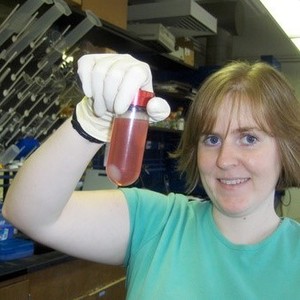
B.S. Chemical Engineering 2006, Princeton University, Princeton, NJ
M.S. Chemical Engineering 2007, Carnegie Mellon University, Pittsburgh, PA
Ph.D. 2013, Chemistry, University of Notre Dame, Notre Dame, IN
Dissertation: Development of a yeast-based sensor for environmental monitoring
Discipline: Physical Chemistry
Mentor: Holly Goodson
CBBI Fellow: 2008-2010
Current Position: Innovation Officer, Glaxo Smith Kline, Rixensart, Belgium
Research Project:
Julia’s research focuses on microtubule dynamics and the effect of plus end tracking proteins on tubulin polymerization. She uses cell biology, biophysics, light microscopy, fluorescence correlation spectroscopy, protein binding assay, and computational modeling. She completed a research internship in the Department of Biochemistry and Molecular Biology at Oklahoma State University learning yeast genetic manipulation.
Internship:
Oklahoma State University, Department of Biochemistry and Molecular Biology, Stillwater, OK. Mentor:
Honors:
- Sigma Xi, 2006
- Nieuwland Fellowship, 2008
Publications
- Philip, J.T.; Duan, A.R.; Alberico, E.O.; Goodson, H.V. Using MTBindingSim as a Tool for Experimental Planning and Interpretation. Methods Cell Biol. 2013, 115, 375-384. doi: 10.1016/B978-0-12-407757-7.00023-2. PMID: 23973084. PMCID: PMC6938681
- Alberico, E.O.; Lyons, D.F.; Murphy, R.J.; Philip, J.T.; Duan, A.R.; Correia, J,J.; Goodson H.V. Biochemical Evidence that Human EB1 Does Not Bind Preferentially to the Microtubule Seam. Cytoskeleton (Hoboken). 2013, Jun; 70(6), 317-27. doi: 10.1002/cm.21108. Epub 2013 Apr 23. PMID: 23864329. PMCID: PMC4070737.
- Philip, J.T.; Pence, C.H.; Goodson, H.V.. MTBindingSim: simulate protein binding to microtubules. Bioinformatics. 2012, Feb 1; 28 (3), 441-443. doi: 10.1093/bioinformatics/btr684. Epub 2011 Dec 14. PMID: 22171336. PMCID: PMC3268247.
Kurt Piepenbrink
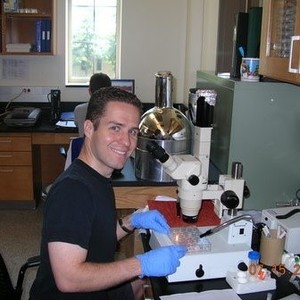
B.A. Chemistry and German Literature 2005, Johns Hopkins University, Baltimore, MD
Ph.D. 2011, Biochemistry, University of Notre Dame, Notre Dame, IN
Dissertation: Understanding the energetic basis for T-cell receptor recognition
Discipline: Biochemistry
Mentor: Brian Baker
CBBI Fellow: 2008-2010
Current Position: Assistant Professor University of Nebraska, Lincoln, NE
Research Project:
Kurt studies the structural and energetic basis for T-cell receptor with the complex of an antigen presenting molecule. He uses non-natural amino acids to test specific patterns of recognition, as well as double mutant cycles to probe the importance of specific side-chain interactions. Kurt conducted a research internship at the University of Cardiff to explore T-cell recognition of antigens through immunological assays and combinatorial peptide libraries with the aim of characterizing superagonist peptides to the A6 TCR and correlating their binding parameters with their immunological potency.
Internship:
April 2009 University of Cardiff, Molecular Biology, Wales, United Kingdom. Mentor: Professor Andrew Sewell. Kurt’s research internship was to explore T-cell recognition of antigens through immunological assays and combinatorial peptide libraries with the aim of characterizing superagonist peptides to the A6 TCR and correlating their binding parameters with their immunological potency.
Honors:
- Gordon Conference Grant Award 2007, 2008
Publications
- Wang, Y.; Singh, N.K.; Spear, T.T.; Hellman, L.M.; Piepenbrink, K.H.; McMahan, R.H.; Rosen, H.R.; Vander Kooi, C.W.; Nishimura, M.I.; Baker, B.M.. How an Alloreactive T-Cell Receptor Achieves Peptide and MHC Specificity. Proc Natl Acad Sci U S A. 2017, Jun 13; 114(24), E4792-E4801. doi: 10.1073/pnas.1700459114. Epub 2017 Jun 1.PMID: 28572406. PMCID: PMC5474831.
- Riley, T.P.; Ayres, C.M.; Hellman, L.M.; Singh, N.K.; Cosiano, M.; Cimons, J.M.; Anderson, M.J.; Piepenbrink, K.H.; Pierce, B.G.; Weng, Z.; Baker, B.M. A Generalized Framework for Computational Design and Mutational Scanning of T-Cell Receptor Binding Interfaces. Protein Eng Des Sel. 2016, Dec; 29(12), 595-606. Epub 2016 Sep 13. PMID: 27624308. PMCID: PMC5181382.
- Smith, S.N.; Sommermeyer, D.; Piepenbrink, K.H.; Blevins, S.J.; Bernhard, H.; Uckert, W.; Baker, B.M.; Kranz, D.M. Plasticity in the contribution of T cell receptor variable region residues to binding of peptide-HLA-A2 complexes J Mol Biol. 2013, 425,4496-507. PMID: 23954306.
- Piepenbrink, K.H.; Blevins, S.J.; Scott, D.R.; Baker, B.M. The Basis for Limited Specificity and MHC Restriction in a T Cell Receptor Interface. Nat Commun. 2013, 4:1948. doi: 10.1038/ncomms2948. PMID: 23736024. PMCID: PMC3708045.
- Scott, D.R.; Borbulevych, O.Y.; Piepenbrink, K.H.; Corcelli, S.A.; Baker, B.M. Disparate Degrees of Hypervariable Loop Flexibility Control T-Cell Receptor Cross-Reactivity, Specificity, and Binding Mechanism. J Mol Biol. 2011, Dec 2; 414(3), 385-400. doi: 10.1016/j.jmb.2011.10.006. Epub 2011 Oct 12. PMID: 22019736. PMCID: PMC3230710.
- Borbulevych, O.Y.; Piepenbrink, K.H.; Baker,B.M. Conformational Melding Permits a Conserved Binding Geometry in TCR Recognition of Foreign and Self Molecular Mimics. J Immunol. 2011, Mar 1; 186(5), 2950-2958. doi: 10.4049/jimmunol.1003150. Epub 2011 Jan 31. PMID: 21282516. PMCID: PMC3076315.
- Aggen, D.H.; Chervin, A.S.; Insaidoo, F.K.; Piepenbrink, K.H.; Baker, B.M., Kranz, D.M. Identification and Engineering of Human Variable Regions that Allow Expression of Stable Single-Chain T cell Receptors. Protein Eng Des Sel. 2011, Apr;_ 24_(4), 361-372. doi: 10.1093/protein/gzq113. Epub 2010 Dec 14. PMID: 21159619. PMCID: PMC3049343.
- Borbulevych, O.Y.; Piepenbrink, K.H.; Gloor, B.E.; Scott, D.R.; Sommese, R.F.; Cole, D.K.; Sewell, A.K.; Baker, B.M. T Cell Receptor Cross-Reactivity Directed by antigen-Dependent Tuning of Peptide-MHC Molecular Flexibility. Immunity. 2009, Dec 18; 31(6), 885-896. doi: 10.1016/j.immuni.2009.11.003. PMID: 20064447. PMCID: PMC3248800.
- Piepenbrink, K.H.; Borbulevych, O.Y.; Sommese, R.F.; Clemens, J.; Armstrong, K.M.; Desmond, C.; Do, P.; Baker, B.M. Fluorine Substitutions in an Antigenic Peptide Selectively Modulate T-cell Receptor Binding in a Minimally Perturbing Manner. Biochem J. 2009, Oct 12; 423(3), 353-61. doi: 10.1042/BJ20090732. PMID: 19698083. PMCID: PMC3014826.
- Piepenbrink, K.H.; Gloor, B.E.; Armstrong, K.M.; Baker, B.M. Methods for quantifying T cell receptor binding affinities and thermodynamics. Methods Enzymol. 2009, 466, 359-81. doi: 10.1016/S0076-6879(09)66015-8. Epub 2009 Nov 13. PMID: 21609868. PMCID: PMC3686473.
- Armstrong, K. M.; Piepenbrink, K. H.; Baker, B. M. Conformational Changes and Flexibility in T Cell Receptor Recognition of Peptide/MHC. Biochem. J., 2008, 415, 183-196.
Richard Pinapati

BSc, Biotechnology, 2004, Osmania University, Hyderabad, India
MSc, Biotechnology, 2006, Bangalore University, Bangalore, India
Post-Graduate Diploma, Intellectual Property Rights, 2007, Osmania University, Hyderabad, India
MS, Bioinformatics, 2010, Indiana University, Bloomington
Ph.D. 2018, Biological Sciences, University of Notre Dame, Notre Dame, IN
Dissertation: Understanding drug resistance in Plasmodium falciparum through genetic crosses and global metabolomics
Discipline: Biology
Mentor: Michael T. Ferdig
CBBI Fellow: 2012-2014
Current Position: Senior Bioinformatics Scientist, Nimble Therapeutics, Madison, WI
Research Project:
Richard’s research focuses on understanding the genetics of drug resistance in the human malaria parasite, Plasmodium falciparum. He studies the global metabolite regulation in the parasites using mass spectrometry and employs experimental genetic crosses, linkage analyses, quantitative trait loci mapping and network theory to address questions regarding the evolution and strategies to circumvent antimalarial resistance.
Internship
January 2014 Department of Biochemistry and Molecular Biology, The Pennsylvania State University, University Park, PA. Mentor: Manuel Llinas. Richard’s internship project focused on the global metabolomics of Plasmodium falciparum using quantitative trait loci (QTL) mapping and analysis of the metabolites by LC-MS mass spectrometry. During his internship, he learned to improve extraction methodology for metabolites from the malaria parasite and mass spectrometry protocols for their analysis.
Honors:
- Best performer at the DREAM6 Systems Biology Challenge for Gene Expression Prediction, 2012
- 17th Annual Summer Institute in Statistical Genetics (SISG) Travel Award, 2012
- Best Poster at CBBI Symposium, 2012 & 2013
Publications
- Siwo,G.; Rider, A.; Tan, A.; Pinapati, R.; Emrich, S.; Chawla, N.; Ferdig, M. Prediction of Fine-Tuned Promoter Activity From DNA Sequence. F1000Res. 2016, Feb 11; 5, 158. doi: 10.12688/f1000research.7485.1. eCollection 2016. PMID: 27347373. PMCID: PMC4916984.
- Vaughan, A.M.; Pinapati, R.S.; Cheeseman, I.H.; Camargo, N.; Fishbaugher, M.; Checkley, L.A.; Nair, S.; Hutyra, C.A.; Nosten, F.H.; Anderson, T.J.; Ferdig, M.T.; Kappe, S.H. Plasmodium Falciparum Genetic Crosses in a Humanized Mouse Model. Nat Methods. 2015, Jul; 12(7), 631-633. doi: 10.1038/nmeth.3432. Epub 2015 Jun 1. PMID: 26030447. PMCID: PMC4547688.
- Siwo, G.H.; Tan, A.; Button-Simons, K.A.; Samarakoon, U.; Checkley, L.A.; Pinapati, R.S.; Ferdig, M.T. Predicting Functional and Regulatory Divergence of a Drug Resistance Transporter Gene in the Human Malaria Parasite. BMC Genomics. 2015, Feb 22; 16, 115. doi: 10.1186/s12864-015-1261-6. PMID: 25765049. PMCID: PMC4352545.
- Rider, A.K.; Milenković, T.; Siwo, G.H.; Pinapati, R.S.; Emrich, S.J.; Ferdig, M.T.; Chawla, N.V. Networks’ Characteristics Matter for Systems Biology. Networks Science (Camb Univ Press). 2014, Aug; 2(2), 139-161. Epub 2014 Sep 3. PMID: 26500772. PMCID: PMC4617311.
- Champion, M.M., Williams, E.A., Pinapati, R.S., Champion, P.A. Correlation of Phenotypic Profiles Using Targeted Proteomics Identifies Mycobacterial esx-1 Substrates. J. Proteome Res. 2014, 13, 5151-5164. PMCID: PMC4227905.
- Meyer, P.; Siwo, G.; Zeevi, D.; Sharon, E.; Norel, R.; Rider, A.K.; Tan, A.; Pinapati, R.S.; Emrich, S.; Chawla, N.; Ferdig, M.T.; Tung, Y.A.; Chen, Y.S.; Chen, M.J.; Chen, C.Y.; Knight, J.M.; Sahraeian, S.M.; Esfahani, M.S.; Dreos, R.; Bucher, P.; Maier, E.; Saeys, Y.; Szczurek, E.; Mysicková, A.; Vingron, M.; Klein, H.; Kielbasa, S.M.; Knisley, J.; Bonnell, J.; Knisley, D.; Kursa, M.B.; Rudnicki, W.R.; Bhattacharjee, M.; Sillanpää, M.J.; Yeung, J.; Meysman, P.; Rodríguez, A.S.; Engelen, K.; Marchal, K.; Huang, Y.; Mordelet, F., Hartemink, A.; Pinello, L.; Yuan, G.C.; Segal, E.; Stolovitzky, G. Inferring Gene Expression from Ribosomal Promoter Sequences, a Crowdsourcing Approach. Genome Research 2013, 23(11), 1928-37. doi:10.1101/gr.157420.113. PMCID: PMC3814892.
Yuanyuan Qian

B.S.2013, Shaanxi University of Science and Technology, Xi’an, China
M.S.2016, Fudan University, Shanghai, China
PhD. 2023, Organic Chemistry, University of Notre Dame, Notre Dame, IN
Dissertation: Design, Synthesis, Evaluation and Mechanistic Elucidation of Antibacterial Agents for Gram-Postiive Bacteria
Discipline: Organic Chemistry
Mentor: Shahriar Mobashery and Mayland Chang
CBBI Fellow: 2018-2020
Current Position: Senior Research Scientist, Wuxi App Tech, Nantong, China
Research Project:
Yuanyuan's research focuses on the structure-activity relationship of quinazolinone class of antibacterials. He plans to conduct a research internship in the laboratory of Prof. Juan Hermoso to crystalize his quinazolinones with penicillin-binding proteins(PBPs) 1 and 2a. Yuanyuan’s project also involves the design, synthesis, biological evaluation, and mechanism elucidation of antibacterial agents against MRSA or C. diff.
Publications:
- Janardhanan, J.; Kim, C.; Qian, Y.; Yang, J.; Meisel, J.E.; Ding, D.; Speri, E.; Schroeder, V.A.; Wolter, W.R.; Oliver, A.G.; Mobashery, S.; Chang, M. A dual-action antibiotic that kills Cloistridiodes difficile vegetative cells and inhibits spore germination. Proc Natl Acad Sci. 2023 (in review).
- Qian, Y.; Allegretta, G.; Janardhanan, J.; Peng, Z.; Mahasenan, K. V.; Lastochkin, E.; Gozun, M. M. N.; Tejera, S.; Schroeder, V. A.; Wolter, W. R.; Feltzer, R.; Mobashery, S.; Chang, M.. Exploration of the structural space in 4(3H)-quinazolinone antibacterials. J. Med. Chem., 2020, 63, 5287–5296.
-
Ceballos, S.; Kim, C.; Qian, Y.; Mobashery, S.; Chang, M.; Torres, C. Susceptibility of Methicillin-resistant Staphylococcus aureus to five quinazolinone antibacterials. Antimicrob. Agents Chemother. 2019, (1):e 01344-19.doi:10.1128/AAC.01344-19. Print 2019 Dec 20. PMID: 31611358. PMCID: PMC7187613.
-
Boudreau, M.A.; Ding, D.; Meisel, J.E.; Janardhanan, J.; Spink, E.; Peng, Z.; Qian, Y.; Yamaguchi, T.; Testero, S.A.; O’Daniel, P.I.; Leemans, E.; Lastochkin, E.; Song, W.; Schroeder, V.a.; Wolter, W.R.; Suckow, M.A.; Mobashery, S.; Chang, M. Structure-Activity Relationship for the Oxadiazole Class of Antibactericals. ACS Med Chem. Lett. 2019, doi.org/10.1021/acsmedchemlett.9b00379 PMCID: PMC7073871.
- Speri, E., Kim, C., De Benedetti, S., Qian, Y., Lastochkin, E., Fishovitz, J., Fisher, J. F., Mobashery, S. Cinnamonitrile Adjuvants Restore Susceptibility to β-Lactams against Methicillin-Resistant Staphylococcus aureus. ACS Med. Chem. Lett. 2019. doi:10.1021/acsmedchemlett.9b00169.
Taylor Quinn
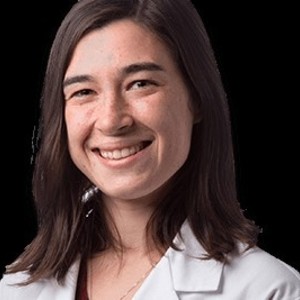
B.A. 2015, Vassar College, Poughkeepsie, NY
Ph.D. 2020 Chemistry, University of Notre Dame, Notre Dame, IN
Dissertation: Microsecond Simulations of the PmHMGR Second Hydride Transfer Transition State and Investigations into Molecule and Enzyme Dynamics
Discipline: Theoretical/Computational Chemistry
Mentor: Olaf Weist and Paul Helquist
CBBI Fellow: 2016-2018
Current Position: Senior Scientist, AstraZeneca, Boston, MA
Research Project:
Taylor’s research focuses on understanding the mechanism of Pseudomonas mevalonii HMG-CoA reductase. By using classical ground-state molecular mechanics as well as Q2MM transition state force fields, the enzyme mechanism is elucidated with atomistic detail across the entire protein.
Internship:
Purdue University, West Lafayette, IN Mentor: Professor Cynthia Stauffacher. While in the lab, she worked to express, purify, and crystallize HMGCoA reductase; she mutated residues outside the active site to determine their effect on the rate of the reaction
Publications:
- Quinn, T.R.; Steussy, C.N.; Haines, B.E.; Lei, J.; Wang, W.; Sheong, F.K.; Stauffacher, C.V.; Huang, X.; Norrby, P.O.; Helquist, P.; Wiest O. Microsecond timescale MD simulations at the transition state of Pm HMGR predict remote allosteric residues. Chem Sci. 2021, 12, 6413-6418. PMID: 34084441.
- Cruz, D.L.; Pipalia, N.; Mao, S.; Gadi, D.; Liu, G.; Grigalunas, M.; O'Neill, M.; Quinn, T.R.; Kipper, A.; Ekebergh, A.; Dimmling, A.; Gartner, C.; Melancon, B.J.; Wagner, F.F.; Holson, E.; Helquist, P.; Wiest, O.; Maxfield, F.R. Inhibition of Histone Deacetylases 1, 2, and 3 Enhances Clearance of Cholesterol Accumulation in Niemann-Pick C1 Fibroblasts. ACS Pharmacol Transl Sci. 2021, 4,1136-1148. PMID: 34151204.
- Gryder, B.E.; Wu, L.; Woldemichael, G.M.; Pomella, S.; Quinn, T.R.; Park, P.M.C.; Cleveland, A.; Stanton, B.Z.; Song, Y.; Rota, R.; Wiest, O.; Yohe, M.E.; Shern, J.F.; Qi.; Khan, J. Chemical genomics reveals histone deacetylases are required for core regulatory transcription Nat Commun. 2019 10, 3004. PMID: 31285436.
- Rosales, A.R.; Quinn, T.R.; Wahlers, J.; Tomberg, A.; Zhang, X.; Helquist, P.; Wiest, O.; Norrby, P.O. Application of Q2MM to Predictions in Steroselective Synthesis. ChemCommun(Camb) 2018, 54, 8294-8311. PMCID: PMC6069518.
- Huang, X.; Quinn, T.R.; Harms, K.; Webster, R.D.; Zhang, I.; Wiest, O.; Meggers, E. Direst Visible -Light-Excited Asymmetric Lewis Acid Catalysis of Intermolecular [2+2] Photocycloadditions. J Am Chem Soc 2017, 139, 9120-9123. PMID:28644024.
Jonathan Renn
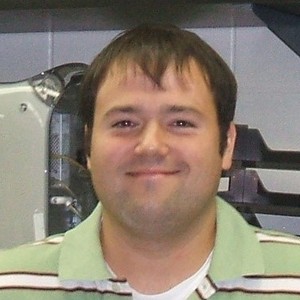
B.S. Biochemistry 2004, Benedictine University, Lisle, IL
Ph.D. Biochemistry 2010, University of Notre Dame
Dissertation: Folding and Secretion of the E. Coli Pet Autotransporte
Discipline: Biochemistry
Mentor: Patricia Clark
CBBI Fellow: 2007-2008
Current Position: Postdoctoral Fellow, NIH, Bethesda, MD
Research Project:
Jonathan studied the folding and secretion of the autotransporter virulence protein Pet. He conducted in vitro folding and stability experiments to understand how Pet folds. In vivo studies of Pet secretion and folding were performed in order to understand the biogenesis of this protein.
Publications:
- Renn. J.P.; Junker, M.; Besingi, R.N.; Braselmann, E.; Clark PL. ATP-Independent Control of Autotransporter Virulence Protein Transport Via the Folding Properties of the Secreted Protein. Chem Biol. 2012, Feb 24; 19(2), 287-296. doi: 10.1016/j.chembiol.2011.11.009. Epub 2011 Dec 29. PMID: 22209629. PMCID: PMC3288764.
- Renn, J.P.; Clark, P.L. Disulfide Bond-Mediated Passenger Domain Stalling as a Structural Probe of Autotransporter Outer Membrane Secretion in Vivo. Methods Enzymol. 2011, 492, 233-351. doi: 10.1016/B978-0-12-381268-1.00030-6. PMID: 21333794.
- Renn, J.P.; Clark, P.L. A Conserved Stable Core Structure in the Passenger Domain Beta-Helix of Autotransporter Virulence Proteins. Biopolymers. 2008, May; 89(5), 420-427. doi: 10.1002/bip.20924.PMID: 18189304.
Douglas Rice
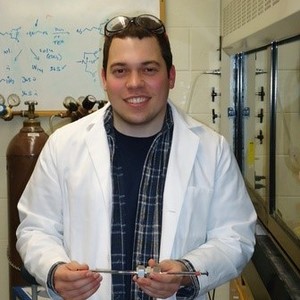
B.A. 2010, Willamette University, Salem, OR
Ph.D. 2015 Biochemistry, University of Notre Dame, Notre Dame, IN
Disertation: Molecular Imaging Using Nanoparticles and Small Molecule
Discipline: Biochemistry
Mentor: Bradley Smith
CBBI Fellow: 2011-2013
Current Position: Internal Medicine, Oregon Health & Science, Portland, OR
Research Project:
Doug’s project involves the fabrication of dye-doped particles for use in the optical imaging of disease. He uses squaraine rotaxane dyes which can emit fluorescent and chemiluminescent light in the near-infrared region. He has recently been exploring a variety of particle platforms including micelles, polystyrene particles and liposomes and their ability to target cell death, cancer and bacterial infection in vivo using mouse models. Doug will conduct internships at the University of Massachusetts Amherst and MIT to study new polymeric systems for in vivo dye delivery and synthetic strategies for adhering targeting groups to the surface of nanoparticles.
Internship:
University of Massachusetts/MIT, Amherst, Massachusetts/Cambridge, Massachusetts. Doug’s research internship was to study new polymeric systems for in vivo dye delivery and synthetic strategies for adhering targeting groups to the surface of nanoparticles.
Honors:
- Kaneb Outstanding Graduate Student Teacher Award, Notre Dame University, 2011
- Lily Grant Recipient, Willamette University, 2009
- Florian Von Eschen Chemistry Scholarship Recipient, Willamette University, 2009
- Paul M Duell Chemistry Scholarship Recipient, Willamette University, 2008
Publications:
- Rice, D.R.; de Lourdes Betancourt Mendiola, M.; Murillo-Solano, C.; Checkley, L.A.; Ferdig, M.T.; Pizarro, J.C.; Smith, B.D. Antiplasmodial Activity of Targeted Zinc(II)-Dipicolylamine Complexes. Bioorg Med Chem. 2017, May 15; 25(10), 2754-2760. doi: 10.1016/j.bmc.2017.03.050. Epub 2017 Mar 27. PMID: 28377170. PMCID: PMC5443346.
- Roland, F.M. Peck, E.M.; Rice, D.R.; Smith, B.D. Preassembled Fluorescent Multivalent Probes for the Imaging of Anionic Membranes. Bioconjug Chem. 2017, Apr 19; 28(4), 1093-1101. doi: 10.1021/acs.bioconjchem.7b00012. Epub 2017 Feb 9. PMID: 28125214. PMCID: PMC5476362.
- Rice, D.R.; Clear, K.J.; Smith, B.D. Imaging and Therapeutic Applications of Zinc(ii)-Dipicolylamine Molecular Probes for Anionic Biomembranes. Chem Commun (Camb). 2016, Jul 7; 52(57), 8787-8701. doi: 10.1039/c6cc03669d. Review. PMID: 27302091. PMCID: PMC4949593.
- Peck, E.M.; Battles, P.M.; Rice, D.R.; Roland, F.M.; Norquest, K.A.; Smith, B.D. Pre-Assembly of Near-Infrared Fluorescent Multivalent Molecular Probes for Biological Imaging. Bioconjug Chem. 2016, May 18; 27(5), 1400-1410. doi: 10.1021/acs.bioconjchem.6b00173. Epub 2016 Apr 27. PMID: 27088305. PMCID: PMC4918808.
- Rice, D.R.; Vacchina, P.; Norris-Mullins, B.; Morales, M.A.; Smith, B.D. Zinc(II)-Dipicolylamine Coordination Complexes as Targeting and Chemotherapeutic Agents for Leishmania Major. Antimicrob Agents Chemother. 2016, Apr 22; 60(5), 2932-2940. doi: 10.1128/AAC.00410-16. Print 2016 May. PMID: 26926632. PMCID: PMC4862449.
- Clear, K.J.; Harmatys, K.M.; Rice, D.R.; Wolter, W.R.; Suckow, M.A.; Wang, Y.; Rusckowski, M.; Smith B.D. Phenoxide-Bridged Zinc(II)-Bis(dipicolylamine) Probes for Molecular Imaging of Cell Death. Bioconjug Chem. 2016, Feb 17; 27(2), 363-375. doi: 10.1021/acs.bioconjchem.5b00447. Epub 2015 Sep 11.PMID: 26334386. PMCID: PMC4917876.
- Rice, D.R.; Gan, H.; Smith, B.D. Bacterial Imaging and Photodynamic Inactivation Using Zinc (II)-Dipicolylamine BODIPY Conjugates. Photochem Photobiol Sci. 2015, Jul; 14(7), 1271-1281. doi: 10.1039/c5pp00100e. PMID: 26063101. PMCID: PMC4490101.
- Rice, D.R.; White, A.G.; Leevy, W.M.; Smith, BD. Fluorescence Imaging of Interscapular Brown Adipose Tissue in Living Mice. J Mater Chem B. 2015, Mar 7; 3(9), 1979-1989. PMID: 26015867. PMCID: PMC4442081.
- Rice, D.R.; Plaunt, A.J.; Turkyilmaz, S.; Smith, M.; Wang, Y.; Rusckowski, M.; Smith, B.D. Evaluation of [¹¹¹In]-Labeled Zinc-Dipicolylamine Tracers for SPECT Imaging of Bacterial Infection. Mol Imaging Biol. 2015, Apr; 17(2), 204-213. doi: 10.1007/s11307-014-0758-8. PMID: 25115869. PMCID: PMC4515950.
- Turkyilmaz, S.; Rice, D.R.; Palumbo, R.; Smith B.D. Selective Recognition of Anionic Cell Membranes Using Targeted Liposomes Coated with Zinc (ii)-Bis (Dipicolylamine) Affinity Units. Org Biomol Chem. 2014, Aug 14; 12(30), 5645-5655. doi: 10.1039/c4ob00924j. Epub 2014 Jun 25. PMID: 24962330. PMCID: PMC4128505.
- Lee, J.J.; White, A.G.; Rice, D.R.; Smith, B.D. In Vivo Imaging Using Polymeric Nanoparticles Stained with Near-Infrared Chemiluminescent and Fluorescent Squaraine Catenane Endoperoxide. Chem Commun (Camb). 2013, Apr 14; 49(29), 3016-3018. doi: 10.1039/c3cc40630j. PMID: 23467338. PMCID: PMC3633569.
Felicia Roland

BS, Chemistry, 2009, Eastern Illinois University, Charleston, IL
Ph.D. 2018 Biochemistry, University of Notre Dame, Notre Dame, IN
Dissertation: Molecular Probes for Cancer Imaging and Therapy
Discipline: Biochemistry
Mentor: Bradley Smith
CBBI Fellow: 2014-2016
Current Position: Account Manager, Leica Microsystems, Chicago, IL
Research Project:
Felicia’s project aims to use molecules and nanoparticles to absorb near-infrared laser light and generate heat that leads to cancer cell death without toxicity to the healthy surrounding tissues. Her goal is to use croconaine dye-labeled molecules and nanoparticles to control the pathway of cell death through photothermal therapy (PTT).
Internship
June 2015 – July 2015 Department of Imaging Physics, MD Anderson Cancer Center, University of Texas, Houston, TX. Mentor: Richard Bouchard
Felicia’s internship measured the photoacoustic properties of a library of dyes developed by the Smith Lab and monitor tumor temperature and volume after photothermal treatment using L/P/CR nanoparticles.
Honors:
- Harris E. Phipps Chemistry Scholarship, Department of Chemistry, Eastern Illinois U., 2012
- Scholars in Undergraduate Research and Eastern Award, Eastern Illinois U., 2012
- Senior Recognition Award, Eastern Illinois U., 2013
- First Place Award at the Graduate Student Union and Office for Postdoctoral Scholars Research Symposium, 2015
Publications
- Jarvis, T.S., Roland, F.M.; Dubiak, K. M.; Huber, P.W.; Smith, B.D. Time-Lapse Imaging of Cell Death in Cell Culture and Whole Living Organisms Using Turn-on Deep-Red Fluorescent Probes.J Mater Chem B. 2018, Aug 14; 6(30), 4963-4971. doi: 10.1039/C8TB01495G. Epub 2018 Jul 10. PMID: 30858977.
- Shaw, S.K.; Liu, W.; Gómez Durán, C.F.A.; Schreiber, C.L.; Betancourt Mendiola, M.L.; Zhai, C.; Roland, F.M.; Padanilam, S.J.; Smith, B.D. Non-Covalently Pre-Assembled High-Performance Near-Infrared Fluorescent Molecular Probes for Cancer Imaging. Chemistry. 2018, Sep 18; 24(52), 13821-13829. doi: 10.1002/chem.201801825. Epub 2018 Aug 19. PMID: 30022552. PMCID: PMC6415912.
- Shaw, S.K.; Schreiber, C.L.; Roland, F.M.; Battles, P.M.; Brennan, S.P.; Padanilam, S.J.; Smith, B.D. High Expression of Integrin αvβ3 Enables Uptake of Targeted Fluorescent Probes into Ovarian Cancer Cells and Tumors. Bioorg Med Chem. 2018, May 1; 26(8), 2085-2091. doi: 10.1016/j.bmc.2018.03.007. Epub 2018 Mar 6. PMID: 29548784. PMCID: PMC5963687.
- Harmatys, K.M.; Battles, P.M.; Peck, E.M.; Spence, G.T.; Roland, F.M.; Smith, B.D. Selective Photothermal Inactivation of Cells Labeled with Near-Infrared Croconaine Dye. Chem Commun (Camb). 2017, Aug 31; 53(71), 9906-9909. doi: 10.1039/c7cc05196d. PMID: 28828431.
- Roland, F.M.; Peck, E.M.; Rice, D.R.; Smith, B.D. Preassembled Fluorescent Multivalent Probes for the Imaging of Anionic Membranes. Bioconjug Chem. 2017, Apr 19; 28(4), 1093-1101. doi: 10.1021/acs.bioconjchem.7b00012. Epub 2017 Feb 9. PMID: 28125214. PMCID: PMC5476362.
- Peck, E.M.; Battles, P.M.; Rice, D.R.; Roland, F.M.; Norquest, K.A.; Smith, B.D. Pre-Assembly of Near-Infrared Fluorescent Multivalent Molecular Probes for Biological Imaging. Bioconjug Chem. 2016, May 18; 27(5), 1400-1410. doi: 10.1021/acs.bioconjchem.6b00173. Epub 2016 Apr 27. PMID: 27088305. PMCID: PMC4918808.
- Guha, S.; Shaw, S.K.; Spence, G.T.; Roland, F.M.; Smith, B.D. Clean Photothermal Heating and Controlled Release from Near-Infrared Dye Doped Nanoparticles without Oxygen Photosensitization. Langmuir. 2015, Jul 21; 31(28), 7826-7834. doi: 10.1021/acs.langmuir.5b01878. Epub 2015 Jul 7.PMID: 26149326. PMCID: PMC4634570.
Danialle Ronnow

BA, Biochemistry, 2007, The Colorado College, Colorado Springs, CO
MS, 2019, Chemistry University of Notre Dame, Notre Dame, IN
Discipline: Chemistry
Mentor: Richard Taylor
CBBI Fellow: 2012-2014
Current Position: Research Associate Covance, Salt Lake City, UT
Research Project:
Danialle’s research focuses on the total synthesis of novel ATPase inhibitors based off of the natural product apoptilidin. In addition to chemical synthesis, she has focused her chemical biology skills on the mutasynthesis for the analogs.
Internship
March 2013 – June 2013 Department of Chemistry, Vanderbilt University, Nashville, TN Mentor: Brian Bachmann and Gary Sulikowski
Danialle’s internship project worked to accomplish the mutasynthesis by generating genetic knockouts of the apoptolidin producer Nocardiopsis fulvus.
Honors:
- Barnes Scholar, The Colorado College, 2007-2011
Publications:
Dodge, G.L.; Ronnow, D.; Taylor, R.E.; Smith, J.L. Molecular Basis for Olefin Rearrangement in the Gephyronic Acid Polyketide Synthase. ACS Chem Biol. 2018, Sep 21; 13(9), 2699-2707. doi: 10.1021/acschembio.8b00645. Epub 2018 Sep 12. PMID: 30179448. PMCID: PMC6233718.
Anthony Rosales

BA 2014, Chemistry, Carroll College, Helena, MT
Ph.D. 2019 Chemistry, University of Notre Dame, Notre Dame, IN
Dissertation: Development of Force Field Parameters for Predictions in Asymmetric Catalysis and a Foray into Mechanism Elucidation
Mentor: Olaf Wiest & Paul Helquist
CBBI Fellow: 2016-2018
Current Position: Medical Strategy Director, 21 Grams, San Francisco, CA
Research Project: Tony’s research focuses on the development and application of the Q2MM method, used to parameterize TSFF’s for studying asymmetric catalysis and enzyme activity. He conducted a research internship in the laboratory of Prof. Cynthia Stauffacher at Purdue University to express, purify and crystallize HMGCoA reductase and perform kinetic studies with various buffers for later time-resolved X-ray studies.
Internship:
Purdue University, West Lafayette, IN Mentor: Professor Cynthia Stauffacher. His research internship included express, purify and crystallize HMGCoA reductase and perform kinetic studies with various buffers for later time-resolved X-ray studies.
Publications:
- Wahlers, J.; Maloney, M.; Salahi, F.; Rosales, A.R.; Helquist, P.; Norrby, P.O.; Wiest, O. Stereoselectivity Predictions for the Pd-Catalyzed 1,4-Conjugate Addition Using Quantum-Guided Molecular Mechanics J Org Chem. 2021 86(8):5660-5667. doi: 10.1021/acs.joc.1c00136. Epub 2021 Mar 26.PMID: 33769065
- Rosales, A; Ross, S.P.; Helquist, P.; Norrby, P.O.; Sigman, M.S.; Wiest O. Transition State Force Field for the Asymmetric Redox Relay Heck Reaction. J Am Chem Soc. 2020 Apr 5. doi: 10.1021/jacs.0c01979 PMID: 32249569.
- Rosales, A.R.; Quinn, T.R.; Wahlers, J.; Tomberg, A.; Zhang, X.; Helquist, P.; Wiest, O.; Norrby, P.O. Application ofQ2MM to Predictions in Stereoselective Synthesis. Chem Commun(Camb). 2018, 54, 8294-8311. PMCID:PMC60669518.
- Ma, J.; Rosales, A.R.; Huang, X.; Harms, K.; Riedel, R.; Wiest, O.; Meggers, E. Visible-Light-Activated Asymmetric β-C-H Functionalization of Acceptor-Substituted Ketones with 1,2-Dicarbonyl Compounds. J. Am. Chem. Soc, 2017 Dec 6; 139(48):17245-17248. doi: 10.1021/jacs.7b09152. Epub 2017 Nov 21. PMID: 29161036.
- Hansen, E.; Rosales, A.R.; Tutkowski, B.; Norrby, P.O.; Wiest, O. Prediction of Sterochemistry using Q2MM. Acc Chem Res. 2016, 49, 996-1005. PMCID: PMC 4879660. PMCID: PMC4879660
Ian Sander

B.S. Biochemistry 2006, Miami University, Oxford, OH
Ph.D. 2012, Biochemistry, University of Notre, Notre Dame, IN
Dissertation: Protein folding in the cell is modulated by the translating ribosome
Discipline: Biochemistry
Mentor: Patricia Clark
CBBI Fellow: 2008-2010
Current Position: Director, Ironwood Pharmaceuticals, Boston, MA
Research Project:
Ian’s research investigates the effect of rare codon clusters on protein folding. He uses computational and bioinformatic methods, biophysics, biochemical assays, and molecular biology. He conducted a research internship at the University of California-San Francisco and learned how to clone synthetic genes into any locus in the bacterial chromosome.
Internship:
May 2009- June 2009, University of California-San Francisco, Cell and Tissue Biology, Microbiology & Immunology, San Francisco, CA. Mentor: Professor Carol Gross. Ian’s research internship was conducted to learn how to clone synthetic genes into any locus in the bacterial chromosome.
Publications
- Sander, I.M.; Chaney, J.L.; Clark, P.L. Expanding Anfinsen’s Principle: Contributions of Synonymous Codon Selection to Rational Protein Design. J Am Chem Soc. 2014, Jan 22; 136(3), 858-61. doi: 10.1021/ja411302m. Epub 2014 Jan 13. PMID: 24392935. PMCID: PMC3959793.
- Evans, M.S.; Sander, I.M.; Clark, P.L. Cotranslational Folding Promotes Beta-Helix Formation and Avoids Aggregation in Vivo. J Mol Biol. 2008, Nov 14; 383(3), 683-692. doi: 10.1016/j.jmb.2008.07.035. Epub 2008 Jul 22. PMID: 18674543. PMCID: PMC2597226.
Cynthia Schreiber

B.S. 2015, University of Wisconsin-Madison, Madison, WI
Ph.D. 2020, Biochemistry, University of Notre Dame, Notre Dame, IN
Discipline: Biochemistry
Mentor: Bradley Smith
CBBi Fellow: 2016-2018
Current Position: Scientist II, BioAgilytix, Durham, NC
Research Project:
Cynthia’s research focuses on fluorescence-guided surgery of ovarian cancer by utilizing fluorescent probes to target overexpressed proteins on the surface of ovarian cancer cells. She also explores multivalency in order to increase probe binding affinity and specificity toward these cancer cells.
Internship:
May 2017 – August 2017 Stockholm University, Stockholm, Sweden. Mentor: Professor Jan-Erling Bläckvall. She evaluated enzyme binding in the active site of lipases for enhanced enantioselectivity. She studied kinetic resolution (KR) and dynamic kinetic resolution (DKR) to create these enantiomerically pure compounds.
Publications:
- Schreiber, C.L.; Li, D.H.; Smith, B.D. High-Performance Near-Infrared Fluorescent Secondary Antibodies for Immunofluorescence Anal Chem. 2021, 93(7):3643-3651. PMID: 33566567.
- Schreiber, C.L. ; Zhai, C.; Smith, B.D. Chiral figure-eight molecular scaffold for fluorescent probe development. Org Biomol Chem. 2021, 19(14):3213-3219.PMID: 33885576.
- Schreiber, C.L.; Zhai, C.; Smith, B.D. Structural Engineering of Fluorescent Self-Threaded Peptide Probes for Targeted Cell Imaging † Photochem Photobiol. 2021 May 2. doi: 10.1111/php.13439. Online ahead of print.PMID: 33934361.
- Li, D.H.; Schreiber, C.L.; Smith, B.D. Sterically Shielded Heptamethine Cyanine Dyes for Bioconjugation and High Performance Near-Infrared Fluorescence Imaging. Angew Chem Int Ed Engl. 2020, 59(29):12154-12161. PMID: 32324959.
- Schreiber, C.L.; Zhai, C.; Dempsey, J.M.; McGarraugh, H.H.; Matthews, B.P.; Christmann, C.R.; Smith, B.D. Paired Agent Fluorescence Imaging of Cancer in a Living Mouse Using Preassembled Squaraine Molecular Probes with Emission Wavelengths of 690 and 830 nm. Bioconjug Chem. 2020, 31(2):214-223. PMID: 31756298.
- Wen ,Y.; McGarraugh, H.H.; Schreiber, C.L.; Smith, B.D. Cell organelle targeting of near-infrared croconaine dye controls photothermal outcome Chem Commun (Camb). 2020, 56(51):6977-6980. PMID: 32436506.
- Zhai, C.; Schreiber, C.L.; Padilla-Coley, S.; Oliver, A.G.; Smith, B.D. Fluorescent Self-Threaded Peptide Probes for Biological Imaging. Angew Chem Int Ed Engl. 2020, 59(52):23740-23747. PMID: 32930474.
- Wen, Y.; Schreiber, C.L.; Smith, B.D. Dual-Targeted Phototherapeutic Agents as Magic Bullets for Cancer Bioconjug Chem. 2020, 31(3):474-482. PMID: 31940166
- Schreiber, C.L.; Smith, B.D. Molecular conjugation using non-convalent click chemistry. Nature Reviews Chemistry. 2019, 3, 393-400.
- Gustafson, K.P.J.; Görbe, T.; de Gonzalo, G.; Yang , N.; Schreiber, C.L. ; Shchukarev, A.; Tai, C.W.; Persson, I.; Zou, X.; Bläckvall, J.-E. Chemoenzymatic dynamic kinetic resolution of primary benzylic amines using Pd(0)-CalB CLEA as a biohybrid catalyst. Chemistry. 2019, 25, 9174-9179.
- Schreiber, C.L.; Smith, B.D. Molecular Imaging of Aminopeptidase N in cancer and Angiogenesis. Contrast Media Mol Imaging. 2018, 5315172. PMCID:PMC6036854.
- Shaw, S.k.; Liu, W.; Gόmez Durán, C.F.A.; Schreiber, C.L.; Betancourt, Mendiola, M.L.; Zhai, C.; Roland, F.M.; Pandanilam, S.J.; Smith, B.D. Non-Covalently Pre-Assembled High Performance Near-Infrared Fluorescent Molecular Probes for Cancer Imaging. Chemistry, 2018, 24, 13821-13829. doi: 10.1002/chem.201801825. Epu 2018 Aug 19.
- Shaw, S.k.; Schreiber, C.L.; Roland, F.M.; Battles, P.M.; Brennan, S.P.; Padanilam, S.J.; Smith, B.D. High expression of integrin αvβ3 enables uptake of targeted fluorescent probes into ovarina cancer. Bioorg Med Chem. 2018, 26(8), 2085-2091. doi:10.1016/j.bmc.2018.03.007. Epub 2018 Mar 6. PMID: 29548784.
Monica Schroll
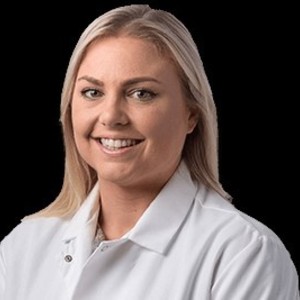
B.S. 2013, Gonzaga University, Spokane, WA
Ph.D. 2018 Biochemistry, University of Notre Dame, Notre Dame, IN
Dissertation: Analysis of Nutrient Based Intervention for Colorectal Cancer Treatment Using Mass Spectrometry
Discipline: Biochemistry
Mentor: Amanda Hummon
CBBI Fellow: 2016-2018
Current Position: Senior Analyst, Health Advances, San Francisco, CA
Research Project:
Monica’s research focuses on the proteomic evaluation of nutritional interventions such as glucose fasting and vitamin supplementation in tandem with chemotherapy treatment in colorectal cancer. She plans to conduct a research internship with Prof. Liangliang Sun at Michigan State University to learn the use of capillary zone electrophoresis for top down proteomics.
Internship:
Michigan State University, East Lansing, MI. Mentor: Professor Liangliang Sun. Monica’s research internship was conducted to learn the use of capillary zone electrophoresis for top-down proteomics.
Publications:
- Schroll, M.M.; Ludwig, K.R.; LaBonia, G.J.; Herring, E.L.; Hummon, A.B. Combined Short-Term Glucose Starvation and Chemotherapy in 3D Colorectal Cancer Cell Culture Decreases 14-3-3 Family Protein Expression and Phenotypic Response to Therapy. J Am Soc Mass Spectrom. 2018, Oct; 29(10), 2012-2022. doi: 10.1007/s13361-018-2013-z. Epub 2018 Jul 17. PMID: 30019162.
- Schroll, M.M.; Hummon, A.B. Employing Proteomics to Understand the Effects of Nutritional Intervention in Cancer Treatment. Anal Bioanal Chem. 2018, Oct; 410(25), 6371-6386. doi: 10.1007/s00216-018-1219-z. Epub 2018 Jul 4. Review. PMID: 29974151.
- Ludwig, K.R.; Schroll, M.M.; Hummon, A.B. Comparison of In-Solution, FASP, and S-Trap Based Digestion Methods for Bottom-Up Proteomic Studies. J Proteome Res. 2018, Jul 6; 17(7), 2480-2490. doi: 10.1021/acs.jproteome.8b00235. Epub 2018 May 24. PMID: 29754492.
- Schroll, M.M.; Ludwig, K.R.; Bauer, K.M.; Hummon, A.B. Calcitriol Supplementation Causes Decreases in Tumorigenic Proteins and Different Proteomic and Metabolomic Signatures in Right Versus Left-Sided Colon Cancer. Metabolites. 2018, Jan 11; 8(1). pii: E5. doi: 10.3390/metabo8010005. PMID: 29324674. PMCID: PMC5875995.
- Schroll , M.M.; LaBonia, G.J.; Ludwig, K.R.; Hummon, A.B. Glucose Restriction Combined with Autophagy Inhibition and Chemotherapy in HCT 116 Spheroids Decreases Cell Clonogenicity and Viability Regulated by Tumor Suppressor Genes. J Proteome Res. 2017, Aug 4; 16(8), 3009-3018. doi: 10.1021/acs.jproteome.7b00293. Epub 2017 Jul 3. PMID: 28650662. PMCID: PMC5371507.
- Feist, P.E.; Sidoli, S.; Liu, X.; Schroll, M.M.; Rahmy, S.; Fujiwara, R.; Garcia, B.A.; Hummon, A.B. Multicellular Tumor Spheroids Combined with Mass Spectrometric Histone Analysis To Evaluate Epigenetic Drugs. Anal Chem. 2017, Mar 7; 89(5), 2773-2781. doi: 10.1021/acs.analchem.6b03602. Epub 2017 Feb 21.PMID: 28194967. PMCID: PMC5371507.
- Schroll, M.M.; Liu, X.; Herzog, S.K.; Skube, S.B.; Hummon, A.B. Nutrient Restriction of Glucose or Serum Results in Similar Proteomic Expression Changes in 3D Colon Cancer Cell Cultures. Nutr Res. 2016, Oct; 36(10), 1068-1080. doi: 10.1016/j.nutres.2016.08.002. Epub 2016 Aug 14.PMID: 27865348. PMCID: PMC5119765.
Naviya Schuster-Little

B.A. 2017, Oberlin College, Oberlin, OH
M.S. 2022, University of Notre Dame, Notre Dame, IN
Discipline: Chemistry
Mentor: Rebecca Whelan
CBBI Fellow: 2020-2022
Current Position: Ph.D. candidate at University of Kansas
Research Project:
Naviya's research project focuses on expressing, characterizing, and selecting aptamers for the ovarian cancer biomarker CA125 (MUC16). She will use bottom-up proteomics to digest MUC16 into peptides and then will design a parallel reaction monitoring (PRM) assay to detect individual peptides that demonstrate potential for quantitation. Her ultimate goal is to develop a diagnostic test to detect the MUC16 protein in early-stage ovarian cancer.
Internship:
September 13, 2021 - October 29, 2021. University of Wisconsin School of Medicine and Public Health, Madison, WI. Mentor: Dr. Manish Patankar, Department of Obstetrics and Gynecology. Naviya's research included learning to isolate and purify MUC16 from OVCAR3 cells, investigating the effect of chemotherapy on the MUC16 proteoform, and learning to perform flow cytometry and FACS.
Honors:
- First Place Poster Prize Harper Cancer Research Day Notre Dame, IN (April 2019)
Publications:
- Schuster-Little, N.; Fritz-Klaus, R.; Etzel, M.; Patankar, N.; Javeri, S.; Patankar, M.; Whelan, R. Affinity-free enrichment and mass spectrometry analysis of the ovarian cancer biomarker CA125 (MUC16) from patient-derived ascites. Analyst, 2020. PMID: 33141132. doi: 10.1039/d0an01701a. Online ahead of print.
- Schuster-Little, N.; Madera, S.; Whelan, R.J. Developing a mass spectrometry-based assay for the ovarian cancer biomarker CA125 (MUC16) using suspension trapping (STrap). AnalBioanalChem, 2020, 12(24): 6361.PMID: 32215689 doi: 10.1007/s00216-020-02586-9 (Online ahead of print).
Daniel Scott
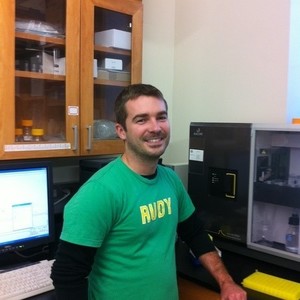
B.S. Chemistry 2002, University of Florida, Gainesville, FL
B.S. M.Ed. 2003, University of Florida, Gainesville, FL
Ph.D. Chemistry, 2012, University of Notre Dame, Notre Dame, IN
Dissertation: The Influences of Conformational Dynamics on T Cell Receptor Specificity and Cross-Reactivity
Discipline: Chemistry
Mentor: Brian M. Baker
CBBI Fellow: 2010-2012
Current Position: Senior Scientist, Novavax, Inc. Gaithersburg, MD
Research Project:
Daniel’s research addresses how conformational dynamics of T-cell receptor (TCR) proteins influence their cross-reactivity to determine the mechanisms that TCRs use to bind their antigenic peptide/MHC complexes. His research may contribute to the optimization of vaccine design for autoimmune diseases and cancer. Daniel uses time-resolved fluorescence anisotropy and molecular dynamics simulations. He is currently conducting a research internship with Prof. Steven Corcelli at the University of Notre Dame in computational chemistry to learn molecular dynamics simulations.
Internship:
University of Notre Dame, Computational Chemistry, Notre Dame, IN. Mentor: Professor Steven Corcelli. Daniel’s research internship was conducted to learn molecular dynamics simulations.
Publications
- Ayres, C.M.; Scott, D.R.; Corcelli, S.A.; Baker, B.M. Differential Utilization of Binding Loop Flexibility in T Cell Receptor Ligand Selection and Cross-Reactivity. Sci Rep. 2016, Apr 27; 6, 25070. doi: 10.1038/srep25070. PMID: 27118724. PMCID: PMC4846865.
- Cole, D.K.; Sami, M.; Scott, D.R.; Rizkallah, P.J.; Borbulevych, O.Y.; Todorov, P.T.; Moysey, R.K.; Jakobsen, B.K.; Boulter, J.M.; Baker, B.M.; Yi, Li. Increased Peptide Contacts Govern High Affinity Binding of a Modified TCR Whilst Maintaining a Native pMHC Docking Mode. Front Immunol. 2013, Jun 26; 4,168. doi: 10.3389/fimmu.2013.00168. eCollection 2013. PMID: 23805144. PMCID: PMC3693486.
- Piepenbrink, K.H.; Blevins, S.J.; Scott, D.R.; Baker, B.M. The Basis for Limited Specificity and MHC Restriction in a T Cell Receptor Interface. Nat Commun. 2013, 4:1948. doi: 10.1038/ncomms2948. PMID: 23736024. PMCID: PMC3708045.
- Scott, D.R.; Vardeman, C.F. 2nd ; Corcelli, S.A.; Baker, B.M. Limitations of Time-Resolved Fluorescence Suggested by Molecular Simulations: Assessing the Dynamics of T Cell Receptor Binding Loops. Biophys J. 2012, Dec 19; 103(12), 2532-40. doi: 10.1016/j.bpj.2012.10.037. Epub 2012 Dec 18. PMID: 23260055. PMCID: PMC3525847.
- Baker, B.M.; Scott, D.R.; Blevins, S.J.; Hawse, W.F. Structural and Dynamic Control of T-Cell Receptor Specificity, Cross-Reactivity, and Binding Mechanism. Immunol Rev. 2012, Nov; 250(1), 10-31. doi: 10.1111/j.1600-065X.2012.01165.×. Review. PMID: 23046120.
- Scott, D.R.; Borbulevych, O.Y.; Piepenbrink, K.H.; Corcelli, S.A.; Baker, B.M. Disparate Degrees of Hypervariable Loop Flexibility Control T-Cell Receptor Cross-Reactivity, Specificity, and Binding Mechanism. J Mol Biol. 2011, Dec 2; 414(3), 385-400. doi: 10.1016/j.jmb.2011.10.006. Epub 2011 Oct 12. PMID: 22019736. PMCID: PMC3230710.
- Borbulevych, O.Y.; Piepenbrink, K.H.; Gloor, B.E.; Scott, D.R.; Sommese, R.F.; Cole, D.K.; Sewell, A.K.; Baker, B.M. T Cell Receptor Cross-Reactivity Directed by Antigen-Dependent Tuning of Peptide-MHC Molecular Flexibility.Immunity. 2009, Dec 18; 31(6), 885-896. doi: 10.1016/j.immuni.2009.11.003.PMID: 20064447. PMCID: PMC3248800.
Jordan Scott

B.Sc. Biology 2002, Calvin College, Grand Rapids, MI
Ph.D. 2014 Biochemistry, University of Notre Dame, Notre Dame, IN.
Dissertation: A Biochemical Investigation of Mechanisms of Peripheral Phosphoinositide-Binding Proteins
Discipline: Biochemistry
Mentor: Robert Stahelin
CBBI Fellow: 2010-2013
Current Position: Internal Medicine, University of Toronto, Toronto, Canada
Research Project:
Jordan’s research focuses on solving the molecular mechanisms of the hijacking of the human Nedd4 family of proteins by an array of viruses. She uses biochemistry, biophysics, cell biology, and computational biology to understand the molecules and mechanisms that control new virion formation from human cells, to provide lipidome and proteome of virions to help identify targets for antiviral therapy. She conducted a research internship with Prof. Sirano Dhe-Paganon in the Structural Genomics Consortium at the University of Toronto to train in structural biology to crystallize the Ebola matrix protein VP40 with host-interacting proteins.
Internship:
University of Toronto, Structural Genomics Consortium, Toronto, Canada. Mentor: Professor Sirano Dhe-Paganon. Jordan’s research internship was conducted to train in structural biology to crystallize the Ebola matrix protein VP40 with host-interacting proteins.
Honors:
- Roger K. Bretthauer Biochemistry Teaching Award, 2010
- MIAA Academic Honor Roll, 2007
- Comenius Scholar/Intern, Cherry Street Health Services
- NCAA Division III Two-Time Academic All American, 2007
- King’s Christian Collegiate Gold Award for Academic Excellence, 2005
Publications
- Shirey, C.M.; Scott, J.L.; Stahelin, R.V. Notes and Tips for Improving Quality of Lipid-Protein Overlay Assays. Anal Biochem. 2017, Jan 1; 516, 9-12. doi: 10.1016/j.ab.2016.10.009. Epub 2016 Oct 11. PMID: 27742211. PMCID: PMC5097677.
- Johnson, K.A.; Taghon, G.J.; Scott, J.L.; Stahelin, R.V. The Ebola Virus Matrix Protein, VP40, Requires Phosphatidylinositol 4,5-Bisphosphate (PIP2) for Extensive Oligomerization at the Plasma Membrane and Viral Egress. Sci Rep. 2016, Jan 12; 6, 19125. doi: 10.1038/srep19125.PMID:26753796. PMCID: PMC4709572.
- Adu-Gyamfi, E.; Johnson, K.A.; Fraser, M.E.; Scott, J.L.; Soni, S.P.; Jones, K.R.; Digman, M.A.; Gratton, E.; Tessier, C.R.; Stahelin, R.V.; Host Cell Plasma Membrane Phosphatidylserine Regulates the Assembly and Budding of Ebola Virus. J Virol. 2015, Sep; 89(18), 9440-53. doi: 10.1128/JVI.01087-15. Epub 2015 Jul 1.PMID:26136573. PMCID: PMC4542376.
- Stahelin, R.V.; Scott, J.L.; Frick, C.T. Cellular and Molecular Interactions of Phosphoinositides and Peripheral Proteins. Chem Phys Lipids. 2014, Sep; 182, 3-18. doi: 10.1016/j.chemphyslip.2014.02.002. Epub 2014 Feb 17. Review. PMID: 24556335. PMCID: PMC4484752.
- Scott, J.L.; Musselman, C.A.; Adu-Gyamfi, E.; Kutateladze, T.G.; Stahelin, R.V. Emerging Methodologies to Investigate Lipid-Protein Interactions. Integr Biol (Camb). 2012, Mar; 4(3), 247-258. doi: 10.1039/c2ib00143h. Epub 2012 Feb 10. Review. PMID: 22327461. PMCID: PMC3722868.
- He, J.; Gajewiak, J.; Scott, J.L.; Gong, D.; Ali, M.; Best, M.D.; Prestwich, G.D.; Stahelin, R.V.; Kutateladze, T.G. Metabolically Stabilized Derivatives of Phosphatidylinositol 4-Phosphate: Synthesis and Applications.
Chem Biol. 2011, Oct 28; 18(10), 1312-9. doi: 10.1016/j.chembiol.2011.07.022. PMID: 22035800. PMCID: PMC3205354. - He, J.; Scott, J.L.; Heroux, A.; Roy, S.; Lenoir, M.; Overduin, M.; Stahelin, R.V.; Kutateladze, T.G.; Molecular Basis of Phosphatidylinositol 4-phosphate and ARF1 GTPase Recognition by the FAPP1 Pleckstrin Homology (PH) Domain. J Biol Chem. 2011, May 27; 286(21), 18650-18657. doi: 10.1074/jbc.M111.233015. Epub 2011 Mar 22. PMID: 21454700. PMCID: PMC3099681. PMCID: PMC3099681.
Scott Shaw

BS, Chemistry, 2006, University of West Florida, Pensacola, FL
Ph.D, 2018 Chemistry, University of Notre Dame, Notre Dame, IN
Dissertation: Near-Infrared Molecular Probes for Biomembrane Recognition
Discipline: Chemistry
Mentor: Bradley Smith
CbbI Fellow: 2014-2016
Current Position: Patent Agent, Stinson LLP, St. Louis, MO
Research Project:
Scott’s research focuses on membrane recognition, nanoscale heating, and membrane manipulation. This is accomplished by using light to activate dye molecules that are endowed with molecular recognition capabilities, and the photophysical response is harnessed to image or manipulate biomembranes.
Internship
May 2015 – June 2015 University of Notre Dame, Department of Biological Sciences, Notre Dame, IN Mentor: Miguel A. Morales. Scott’s research internship was to measure the toxicity of ZnDPA compounds towards Leishmania parasites in culture and within infected macrophages, which are the primary Leishmania replication sites in humans. He also performed a proteomics analysis to investigate the toxic mode of action. Additionally, he conducted organelle viability assays in combination with fluorescence microscopy to determine the subcellular localization of the ZnDPA and its effects on organelles.
Honors:
- Florida Academic Scholars Award, 2006-2009
- Chemistry Department Scholarship, 2007-2009
- Alumni Scholarship, 2006-2009
- Seligman Honor’s Scholarship, 2007-2009
- Honor’s Research Grant, 2009
- FAME Poster Presentation, 3rd Place, 2010
- SEASTARs Poster Presentation, 1st Place in Chemistry, 2010
- Chemistry Departmental Service Award, 2010
Publications
- Shaw, S.K.; Liu, W.; Gómez Durán, C.F.A.; Schreiber, C.L.; Betancourt Mendiola, M.L.; Zhai, C., Roland, F.M.; Padanilam, S.J.; Smith, B.D. Non-Covalently Pre-Assembled High-Performance Near-Infrared Fluorescent Molecular Probes for Cancer Imaging. Chemistry. 2018, Sep 18; 24(52), 13821-13829. doi: 10.1002/chem.201801825. Epub 2018 Aug 19. PMID: 30022552. PMCID: PMC6415912.
- Shaw, S.K.; Schreiber, C.L.; Roland, F.M.; Battles, P.M.; Brennan, S.P.; Padanilam, S.J.; Smith, B.D. High Expression of Integrin αvβ3 Enables Uptake of Targeted Fluorescent Probes into Ovarian Cancer Cells and Tumors. Bioorg Med Chem. 2018, May 1;26(8), 2085-2091. doi: 10.1016/j.bmc.2018.03.007. Epub 2018 Mar 6. PMID: 29548784. PMCID: PMC5963687.
- Shaw, S.K.; Liu, W.; Brennan, S.P.; de Lourdes Betancourt-Mendiola, M.; Smith, B.D. Non-Covalent Assembly Method that Simultaneously Endows a Liposome Surface with Targeting Ligands, Protective PEG Chains, and Deep-Red Fluorescence Reporter Groups. Chemistry. 2017, Sep 12; 23(51), 12646-12654. doi: 10.1002/chem.201702649. Epub 2017 Aug 9. PMID: 28736857. PMCID: PMC5961722.
- Guha, S.; Shaw, S.K.; Spence, G.T.; Roland, F.M.; Smith, B.D. Clean Photothermal Heating and Controlled Release from Near-Infrared Dye Doped Nanoparticles without Oxygen Photosensitization. Langmuir. 2015 Jul 21; 31(28), 7826-34. doi: 10.1021/acs.langmuir.5b01878. Epub 2015 Jul 7.PMID: 26149326. PMCID: PMC4634570.
- Busschaert, N.; Elmes, R.B.; Czech, D.D.; Wu, X.; Kirby, I.L.; Peck, E.M.; Hendzel, K.D.; Shaw, S.K.; Chan, B.; Smith, B.D.; Jolliffe, K.A.; Gale, P.A. Thiosquaramides: pH Switchable Anion Transporters. Chem Sci. 2014, Sep 1; 5(9), 3617-3626. PMID: 26146535. PMCID: PMC4486358.
- Peck, E.M.; Liu, W.; Spence, G.T.; Shaw, S.K.; Davis, A.P.; Destecroix, H.; Smith, B.D. Rapid Macrocycle Threading by a Fluorescent Dye-Polymer Conjugate in Water with Nanomolar Affinity. J Am Chem Soc. 2015, Jul 15; 137(27), 8668-71. doi: 10.1021/jacs.5b03573. Epub 2015 Jun 29. PMID: 26106948. PMCID: PMC4643739.
- Devadas, M.S.; Devkota, T.; Guha, S.; Shaw, S.K.; Smith, B.D.; Hartland, G.V. Spatial Modulation Spectroscopy for Imaging and Quantitative Analysis of Single Dye-Doped Organic Nanoparticles Inside Cells. Nanoscale. 2015, Jun 7;7 (21), 9779-85. doi: 10.1039/c5nr01614b.PMID: 25964049. PMCID: PMC4465101.
Yao Shen

B.S. Biology 2004, Nanjing University, People’s Republic of China
M.S. Microbiology 2006, Nanjing University, People’s Republic of China
Ph.D. Chemistry 2011, University of Notre Dame, Notre Dame, IN
Dissertation: Applications of atomistic modeling in drug design
Discipline: Organic Chemistry
Mentor: Dr. Olaf Wiest
CBBI Fellow: 2009-2011
Current Position: Senior Data Scientist Director of Systems Pharmacology, Darwin Health, New York, NY
Research Project:
Yao’s project involved metabolic network reconstruction to predict essential enzymes as antibiotic drug targets. She used computational methods to study the interactions of enzymes with small molecules. She identified nine compounds that inhibit fathy acid synthesis (FAS). Yao conducted a research internship in the Department of Pathology, University of Pittsburgh. She tested 26 compounds predicted as inhibitors of FAS, using the fatty acid elongation, agar diffusion, and liquid culture assays.
Internship:
October 2008-December 2008. University of Pittsburgh, Department of Pathology, Pittsburgh, PA. Mentor: Professor Zoltan Oltvai. Yao’s research internship was conducted to test 26 compounds predicted as inhibitors of FAS, using the fatty acid elongation, agar diffusion, and liquid culture assays.
Honors:
- Travel Grant, Gordon Conference on Computer-Aided Drug Design, Boston, 2009
- Excellent Poster Award, Theory and Application of Computational Chemistry International Conference, 2008
- Second Prize Forum of Sciences and Arts, Nanjing University, 2003
- People’s Fellowship, Nanjing University, 2003
- People’s Fellowship, Nanjing University, 2001
Publications:
- Shen, Y.; Liu, G.; Estiu, G.; Isin, B.; Ahn, Y. Y.; Lee, D. S.; Barabasi, A. L.; Kapatral, V.; Wiest, O.; Oltvai, Z. N. Blueprint for Antimicrobial Hit Discovery Targeting Metabolic Networks. Proc. Natl. Acad. Sci. 2010, 107, 1082-1087. Highlighted in Nature, 2010, 463, 139.PMID: 20080587 PMCID: PMC2824290 DOI: 10.1073/pnas.0909181107
- Filippakopoulos, P.; Qi, J.; Picaud, S.; Shen, Y.; Smith, W. B.; Keates, T.; Morse, E. M.; Fedorov, O.; Hickman, T. T.; Philpott, M.; West, N.; Cameron, M. J.; Heightman, T.; Kung, A.; French, C. A.; Wiest, O.; Knapp, S.; Bradner, J. E. Selective Inhibition of BET Bromodomains. Nature. 2010, Jan 19;107(3):1082-7. , doi:10.1038/nature09504.PMID: 20871596 PMCID: PMC3010259
Bryan Smith
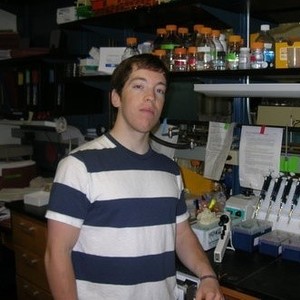
B.S. Biochemistry 2007, DePauw University, Greencastle, IN
Ph.D. Biochemistry, 2012, University of Notre Dame, Notre Dame, IN
Dissertation: In Vivo Optical Imaging of Cell Death Using Fluorescent Synthetic Coordination Complexes
Discipline: Biochemistry
Mentor: Dr. Bradley D. Smith
CBBI Fellow: 2008-2011
Current Position: Senior Scientist Allogene Therapeutics, Los Angeles, CA
Research Project:
Bryan’s research focuses on selective cell delivery via the phosphatidylserine receptor and cancer imaging using near IR probes. He uses biochemistry, chemistry, and biology. He conducted a research internship with Profs. Samuel Achilefu and David Piwnica-Worms at Washington University in St. Louis and learned tumor imaging. He carried out a second research internship with Dr. James Wheeler in Radiation Oncology at the Goshen Center for Cancer Care to evaluate the ability of a fluorescent probe as an in vivo imaging probe for cancer cell death due t radiotherapy. He completed a third research internship with Dr. Clemens Lowik in the Department of Endocrinology at Leiden University Medical Center, Netherlands to learn in vivo imaging cell death of their nerar-IR probe of stroke and other forms of braininjury in mice.
Internships:
- Washington University, St. Louis, MO. Mentors: Professor Samuel Achilefu and David Piwnica-Worms. Bryan’s research internship included learning about tumor imaging.
- Goshen Center for Cancer Care, Radiation Oncology, Goshen, IN. Mentor: Dr. James Wheeler. Bryan’s research internship learning to evaluate the ability of a fluorescent probe as an in vivo imaging probe for cancer cell death due to radiotherapy.
- February 2011 Department of Endocrinology, Leiden University Medical Center, Leiden, Netherlands. Mentor: Dr. Clemens Lowik. Bryan’s research internship included learning in Vivo imaging cell death of their near-IR probe of stroke and other forms of brain injury in mice.
Publications:
- Negin, S.; Smith, B.A.; Unger, A.; Leevy, W.M.;,Gokel, G.W. Hydraphiles: a rigorously studied class of synthetic channel compounds with in vivo activity. Int. J Biomed Imagining. 2013 , Sep 3;10(9):3296-303. 2013:803579. doi: 10.1155/2013/803579. Epub 2013 Jan 15. PMID: 23401675. PMCID: PMC3562588.
- Smith, B.A.; Harmatys, K.M.; Xiao, S.; Cole, E.L.; Plaunt, A.J.; Wolter, W.; Suckow, M.A.; Smith, B.D. Enhanced Cell Death Imaging Using Multivalent Zinc(II)-Bis(Dipicolylamine) Fluorescent Probes. Mol Pharm. 2013, Sep 3; 10(9),3296-3303. doi: 10.1021/mp300720k. Epub 2013 Aug 5. PMID: 23915311. PMCID: PMC3874067.
- Smith, B.A.; Smith, B.D. Biomarkers and Molecular Probes for Cell Death Imaging and Targeted Therapeutics. Bioconjug Chem. 2012, Oct 17; 23(10), 1989-2006. doi: 10.1021/bc3003309. Epub 2012 Sep 26. Review. PMID: 22989049. PMCID: PMC3477794.
- Smith, B.A.; Xie, B.W.; van Beek, E.R.; Que, I.; Blankevoort, V.; Xiao, S.; Cole, E.L.; Hoehn, M.; Kaijzel, E.L.; Löwik, C.W.; Smith, B.D. Multicolor Fluorescence Imaging of Traumatic Brain Injury in a Cryolesion Mouse Model. ACS Chem Neurosci. 2012, Jul 18; 3(7), 530-537. doi: 10.1021/cn3000197. Epub 2012 Apr 7. PMID: 22860222. PMCID: PMC3400377.
- Cole, E.L.; Arunkumar, E.; Xiao, S.; Smith, B.A.; Smith, B.D. Water-Soluble, Deep-Red Fluorescent Squaraine Rotaxanes. Org Biomol Chem. 2012, Aug 14; 10(30), 5769-5773. doi: 10.1039/c2ob06783h. Epub 2011 Dec 8. PMID: 22159917. PMCID: PMC3703462.
- Smith, B.A.; O’Neil, E.J.; Lampkins, A.J.; Johnson, J.R.; Lee, J.J.; Cole, E.L.; Smith, B.D. Evaluation of Fluorescent Phosphatidylserine Substrates for the Aminophospholipid Flippase in Mammalian Cells. J Fluoresc. 2012, Jan; 22(1), 93-101. doi: 10.1007/s10895-011-0933-0. Epub 2001 Aug 4. PMID: 21814762 PMCID: PMC3703462.
- Smith, B.A.; Daschbach, M.M.; Gammon, S.T.; Xiao, S.; Chapman, S.E., Hudson, C.; Suckow, M.; Piwnica-Worms, D.; Gokel, G.W.; Leevy, W.M. In Vivo Cell Death Mediated by Synthetic Ion Channels. Chem Commun (Camb). 2011, Jul 28; 47(28), 7977-7979. doi: 10.1039/c1cc12933c. Epub 2011 Jun 17. PMID 21681307. PMCID: PMC3608405.
- Smith, B.A.; Xiao, S.; Wolter, W.; Wheeler, J.; Suckow, M.A.; Smith, B.D. In Vivo Targeting of Cell Death Using a Synthetic Fluorescent Molecular Probe. Apoptosis. 2011, Jul; 16(7):722-31. doi: 10.1007/s10495-011-0601-5. PMID: 21499791. PMCID: PMC3144473.
- Smith, B.A.; Gammon, S.T.; Xiao, S.; Wang, W.; Chapman, S.; McDermott, R.; Suckow, M.A.; Johnson, J.R.; Piwnica-Worms, D.; Gokel, G.W.; Smith, B.D.; Leevy, W.M. In Vivo Optical Imaging of Acute Cell Death Using a Near-Infrared Fluorescent Zinc-Dipicolylamine Probe. Mol Pharm. 2011, Apr 4; 8(2), 583-90. doi: 10.1021/mp100395u. Epub 2011 Mar 1. PMID: 21323375. PMCID: PMC3608398.
- Smith, B.A.; Akers, W.J.; Leevy, W.M.; Lampkins, A.J.; Xiao, S.; Wolter, W.; Suckow, M.A.; Achilefu, S.; Smith, B.D. Optical imaging of mammary and prostate tumors in living animals using a synthetic near infrared zinc(II)-dipicolylamine probe for anionic cell surfaces. J Am Chem Soc. 2010, Jan 13; 132(1):67-9. doi: 10.1021/ja908467y. PMID: 20014845. PMCID: PMC2805267.
Robert Stanley

B.S. 2016, University of Notre Dame, Notre Dame, IN
Ph.D. 2022, Biology, University of Notre Dame, Notre Dame, IN
Dissertation: Plant Defenses in Non-Model Systems: A Multi-Year Analysis of the chemical defenses deployed by green ash (Fraxinus pennsylvanica) against emerald ash borer (Agrilus planipennis) and the changes in gene expression associated with successful defenses
Discipline: Biochemistry
Mentor: Jeanne Romero-Serverson
CBBI Fellow: 2017-2019
Current Position: Postdoc at Pacific Northwest National Labs, Richland, WA
Research Project:
Robert's research focuses on the isolation and characterization of antimicrobial compounds from Quercus rubra(northern red oak) acorns. He is currently conducting a research internship with Prof. Daniel Jones at Michigan State University in metabolomics of northern red acorns and isolation of compounds with anitmicrobial activity. He is also conducting a second research internship with Dr. Jennifer Koch at the USDA Forest Service to collect green ash samples and analyze of defensive metabolites that resist attack by emerald ash borers.
Internship:
Michigan State University, East Lansing, MI Mentor: Professor Daniel Jones. His research internship involved metabolomics of northern red acorns and isolation of compounds with antimicrobial activity. Second internship: USDA Forest Service Mentor: Dr. Jennifer Koch. He collected green ash samples and analyzed defensive metabolites that resist attack by emerald ash borers.
Jennifer Starner-Kreinbrink

B.A. 2008, Wartburg College, Waverly, IA
Ph.D. 2015 Biochemistry, University of Notre Dame, Notre Dame, IN
Dissertation: Investigating B-Sheet Folding and Aggregation
Discipline: Biochemistry
Mentor: Patricia Clark
CBBI Fellow: 2011-2012
Current: Research Scientist, U.S. Water Services, Inc., St. Michael, MN
Research Project:
Jennifer’s research focuses on understanding the folding and aggregation propensity of parallel β-helices. Parallel β-helices have been identified in many proteins that serve as toxins, virulence factors and allergens, and consist of a geometrically regular all-β-domain. Aggregation of β-helices is especially intriguing as the β-helix has been used as one model for amyloid structure. However, the majority of β-helical proteins are soluble, suggesting that these proteins contain additional sequence or structural elements to help prevent the formation of insoluble amyloid-like fibers. Jennifer is working on identifying these sequences or structural elements and determining how they control aggregation. In addition, she is also studying how the aggregation of β-helices can serve a functional purpose. She completed her internship at the University of Florida with Professor Jorge A. Giron to investigate the assembly of macromolecular rope-like aggregates of EspP, a β-helical autotransporter from E. coli. Her research combines computational biology, biochemical and biophysical experimental techniques, and biological assays.
Internship:
University of Florida, Gainesville, FL. Mentor: Professor Jorge A. Giron. Jennifer’s research internship was conducted to investigate the assembly of macromolecular rope-like aggregates of EspP, a β-helical autotransporter from E. coli. Her research combines computational biology, biochemical and biophysical experimental techniques, and biological assays.
Honors:
*Received the Emil T. Hoffman Graduate Teaching Award for excellence in teaching by a teaching assistant in the first year program- 2009/2010
*Selected for an oral presentation at the Midwest Conference on Protein Folding, Assembly, and Molecular Motions – April 2010
Publications:
- Bryan, A.W.Jr; Starner-Kreinbrink, J.L.; Hosur, R.; Clark, P.L.; Berger. B. Structure-based prediction reveals capping motifs that inhibit β-helix aggregation. PNAS. 2011, 108(27), 11099-11104. doi: 10.1073/pnas.1017504108. Epub 2011 Jun 17. PMID: 21685332. PMCID: PMC3131356.
Lindsay Sweet
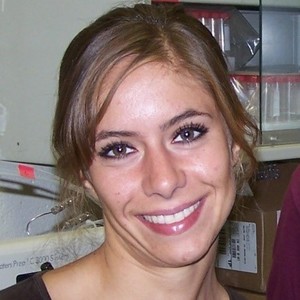
B.S. Microbiology 2003, Colorado State University
Ph.D. Biological Sciences 2008, University of Notre Dame, Notre Dame, IN
Dissertation: Modulation of Macrophage Activation and Phagosome Maturation by Mycobacterium avium Glycopeptidolipids
Mentor: Dr. Jeffrey S. Schorey
CBBI Fellow: 2007-2008
Current Position: Field Medical Director, Pfizer Innovative Health, Boulder, CO
Research Project:
Lindsay characterized the role for Mycobacterium avium surface-located glycopeptidolipids (GPLs) in modulating the host macrophage response; specifically, how they modulate cell signaling and phagosome-lysosome maturation. She found that some GPLs signal via the Toll-like receptor 2 (TLR2) and others do not. Lindsay carried out an internship in the Department of Chemistry to compare the structures of active versus non-active GPLs using GC/MS, MS/MS, and NMR analyses.
Internship:
University of Notre Dame, Department of Chemistry and Biochemistry, Notre Dame, IN Mentor: Professors William Boggess and Anthony Serianni. Lindsay carried out a research internship to compare the structures of active versus non-active GPLs using GC/MS, MS/MS, and NMR analyses.
Honors:
1st Place Presentation CBBI Retreat, 2008
Publications:
- Sweet, L.; Singh, P.P.; Azad, A.K.; Rajaram, M.V.; Schlesinger, L.S.; Schorey, J.S. Mannose Receptor-Dependent Delay in Phagosome Maturation by Mycobacterium Avium Glycopeptidolipids. Infect Immun. 2010, Jan; 78(1), 518-26. doi: 10.1128/IAI.00257-09. Epub 2009 Oct 19. PMID: 19841083. PMCID: PMC2798179.
- Sweet, L.; Zhang, W.; Torres-Fewell, H.; Serianni, A.; Boggess, W.; Schorey, J. Mycobacterium Avium Glycopeptidolipids Require Specific Acetylation and Methylation Patterns for Signaling Through Toll-like Receptor 2. J. Biol Chem. 2008, Nov 28; 283(48), 33221-33231. Doi: 10.1074/jbc.M805539200. Epub 2008 Sept 29. PMID: 18824550. PMCID: PMC2586276.
- Schorey, J.S.; Sweet, L. The Mycobacterial Glycopeptiolipids: Structure, Function, and their Role in Pathogenesis. Glycobiology. 2008, Nov, 18(11), 832-841. Doi: 10.1093/glycob/cwn076. Epub 2008 Aug 22. Review. PMID: 18723691. PMCID: PMC2733780.
- Sweet, L.; Schorey, J.S. Glycopeptiodolipids from Mycobacterium Avium Promote Macrophage Activation in a TLR2- and MyD88-dependent manner. J Leukoc Biol. 2006, Aug, 80(2), 415-423. Epub 2006 Jun 7. PMID: 16760377. DOI: 10.1189/jlb.1205702
- Krzywinska, E.; Bhatnagar, S.; Sweet, L.; Chatterjee, D.; Schorey, J.S. Mycobacterium avium 104 deleted of the methyltransferase D gene by allelic replacement lacks serotype-specific glycopeptidolipids and shows attenuated virulence in mice. Mol Microbiol. 2005, Jun; 56(5), 1262-1273. PMID: 15882419. doi: 10.1111/j.1365-2958.2005.04608.x
Kathryn Trentadue
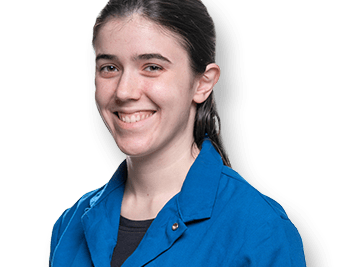
B.S. 2017, Hope College, Holland, MI
Ph.D. Chemistry, 2022, University of Notre Dame, Notre Dame, IN
Dissertation: Investigating the Biosynthesis of the Ambruticians: Total Synthesis and Epoxidation of Intermediate Ambruticin J
Discipline: Chemistry
Mentor: Richard Taylor
CBBI Fellow: 2019-2020
Current Position: Scientist, Snapdragon Chemistry, Waltham, MA
Research Project:
Kathryn's project involves investigating the biosynthesis of the ambruticin family of natural products, a class of antigungal agents extracted from a soil bacterium. She will be conducting a research internship in the lab of Dr. David Sherman at the University of Michigan where Kathryn will explore both chemical and enzymatic methods of synthesis and learn the required biological techniques. Her project involves assessing the antifungal activity of any novel ambruticin analogs produced.
Honors:
- Advanced Teaching Scholar Certificate 2021
- Striving for Excellence in College and University Teaching Certificate 2021
- Jeremiah P. Freeman Award for Teaching in Organic Chemistry 2020
Publications:
Trentadue, K.; Chang, C.F.; Nalin, A.; Taylor, R.E. Enantioselective Total Synthesis of the Putative Biosynthetic Intermediate Ambruticin J. Chemistry- Eur J. 2021, 27(43):11126-11131. doi: 10.1002/chem.202100975. Epub 2021 May 27.PMID: 33887073.
Adriel Villegas-Estrada
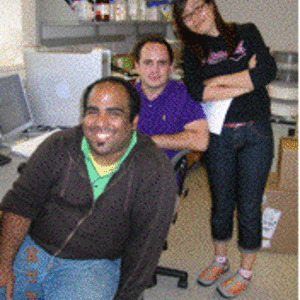
B.A. Chemistry 2004, Vassar College, Poughkeepsie, NY
University of Notre Dame, 2004-2008, Notre Dame, IN
Discipline: Biochemistry
Mentor: Shahriar Mobashery
CBBI Fellow: 2007-2008
Current Position: Research Administration, Dalio ICI, Weill Cornell Medical College
Research Project:
Adriel studied the mechanism of resistance of aminoglycoside-modifying enzymes, the signal transduction pathway for antibiotic resistance in Staphylococcus aureus, and the pharmacokinetic lead optimization of gelatinase inhibitors that can be used as potential drugs. He used a combination of molecular biology, NMR, X-ray crystallography, enzymology, and protein-peptide interactions to elucidate the steps required for S. aureus to generate two enzymes, β-lactamase and PBP2a.
Publications:
- Villegas-Estrada, A.; Lee, M.; Hesek, D.; Vakulenko, S.B.; Mobashery, S. Co-opting the cell wall in fighting methicillin-resistant Staphylococcus aureus: potent inhibition of PBP 2a by two anti-MRSA beta-lactam antibiotics. J Am Chem Soc. 2008, Jul 23; 130(29), 9212-9213. Doi: 10.1021/ja8029448. Epub 2008 Jun 27. PMID: 18582062. PMCID: PMC2747592.
- Moraski, G. C.; Chang, M.; Villegas-Estrada A.; Franzblau, S. G.; Mollmann, U.; Miller, M. J. Structure-activity Relationship of New Anti-tuberculosis Agents Derived from Oxazoline and Oxazole Benzyl Esters. Eur. J. Med. Chem. 2010, 45, 1703-1716.PMID: 20116900 PMCID: PMC2843756
- Celenza, G.; Villegas-Estrada, A.; Lee, M.; Boggess, B.; Forbes, C.; Wolter, W.R.; Suckow, M.A.; Mobashery, S.; Chang, M. Metabolism of (4-phenoxyphenylsulfonyl)methylthiirane, a selective gelatinase inhibitor. Chem. Biol. Drug Design 2008, 71, 187-196. PMID: 18221479.
- Lee, M.; Villegas-Estrada, A.; Celenza, G.; Boggess, B.; Toth, M.; Kreitinger, G.; Forbes, C.; Fridman, R.; Mobashery, S.; Chang, M. Metabolism of a highly selective gelatinase inhibitor generates active metabolite. Chem. Biol. Drug Design 2007, 70, 371-382. PMID: 17927722.
- Kim, C.; Villegas-Estrada, A.; Hesek, D.; Mobashery, S. Mechanistic characterization of the bifunctional aminoglycoside-modifying enzyme AAC (3)-Ib/AAC (6’)-Ib’ from Pseudomonas aeruginosa. Biochemistry. 2007, 46, 5270-5282. PMID: 17417880.
Mark Wacker
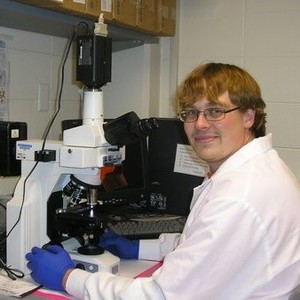
B.A. Biology 2000, Luther College, Decorah, Iowa
Ph.D. Biology 2011, University of Notre Dame, Notre Dame, IN
Dissertation: Impacts of Drug Resistance on the Fitness and Metabolism of Plasmodium falciparum
Discipline: Biology
Mentor: Dr. Michael T. Ferdig
CBBI Fellow: 2009-2011
Current Position: Postdoctoral Fellow, University of Iowa
Research Project:
Mark’s project involved the identification of compounds that map to the pfcrt locus and compounds linked to additional hotspots throughout the genome of the malaria parasite Plasmodium. He assayed global metabolite levels in the parents and progeny clones of a genetic cross between drug sensitive and drug resistant parasite clones. Metabolite extracts were analyzed by HPLC and mass spectrometry. The mass peaks, indicating inherited levels of different metabolites, are treated as phenotypes for quantitative trait loci (QTL) mapping. Mark mapped more than 500 mass peaks to a specific region in the genome. He conducted a research internship with Prof. Manuel Llinas in the Department of Molecular Biology and Prof. Joshua Rabinowitz in the Department of Chemistry, Princeton University in metabolomics to identify the compounds and conduct flux experiments.
Internship:
- July 2009- August 2009, Princeton University, Department of Molecular Biology, Princeton, NJ. Mentor: Professors Manuel Llinas. Mark’s research internship was conducted to identify the compounds and conduct flux experiments.
- Princeton University, Department of Chemistry, Princeton, NJ Mentor: Professor Joshua Rabinowitz. Mark’s research internship was conducted to identify compounds and conduct flux experiments.
Honors:
- Navari Fellowship, University of Notre Dame, 2007
- Young Investigator Award, American Society of Tropical Medicine and Hygiene, 2009
Publications:
- Lewis, I.A.; Wacker, M.; Olszewski, K.L.; Cobbold, S.A.; Baska, K.S.; Tan, A.; Ferdig, M.T.; Llinás, M. Metabolic QTL Analysis Links Chloroquine Resistance in Plasmodium Falciparum to Impaired Hemoglobin Catabolism. PLoS Genet. 2014, Jan; 10(1):e1004085. doi: 10.1371/journal.pgen.1004085. Epub 2014 Jan 2. PMID: 24391526. PMCID: PMC3879234.
- Wacker, M.A.; Turnbull, L.B.; Walker, L.A.; Mount, M.C.; Ferdig, M.T. Quantification of Multiple Infections of Plasmodium Falciparum in Vitro. Malar J. 2012, May 30; 11,180. doi: 10.1186/1475-2875-11-180.PMID: 22646748. PMCID: PMC3483182.
- Reilly Ayala, H.B.; Wacker, M.A.; Siwo, G.; Ferdig, M.T. Quantitative trait loci mapping reveals candidate pathways regulating cell cycle duration in Plasmodium falciparum. BMC Genomics. 2010, Oct 18; 11, 577. doi: 10.1186/1471-2164-11-577. PMID: 20955606. PMCID: PMC3091725.
Katherine Ward

B.S. 2009, University of Central Arkansas, Conway, AR
Ph.D. 2014, Biochemistry, University of Notre Dame, Notre Dame, IN
Dissertation: Cytosolic Phospholipase A2: A Mechanistic Study of Lipid Binding and Its Effects on Membrane Morphology
Discipline: Biochemistry
Mentor: Robert Stahelin
CBBI Fellow: 2011-2014
Current Position: Senior Director, Strategic Operations, IQVIA, New York, NY
Research Project:
Katherine’s research is focused on the characterization and prediction of novel proteins that bind to the lipid Ceramide-1-Phosphate (C1P) using biochemistry and molecular biology. Currently, Katherine is characterizing the molecular binding of C1P within cytosolic phospholipase A2 α (cPLA2α), a target that has been implicated in cerebral ischemia and atherosclerosis, in the laboratory of Prof. Olaf Wiest using computational chemistry. In this internship, Katherine will learn and incorporate molecular dynamics into her current and future research. Through these studies, the goal is to identify new proteins that bind to C1P and also aid in the development of a cPLA2α inhibitor as a potential treatment of heart attack and stroke.
Internship:
University of Notre Dame, Department of Chemistry and Biochemistry, Notre Dame, IN. Mentor: Professor Olaf Wiest. Katherine’s research internship was conducted to identify new proteins that bind to C1P and also aid in the development of a cPLA2α inhibitor as a potential treatment of heart attack and stroke. Katherine learned and incorporated molecular dynamics into her current and future research.
Honors:
- Selected for Oral Research Presentation at the International Experimental Biology ASBMB Conference, 2012.
- Awarded a 2 year American Heart Association Predoctoral Fellowship 2011-2013.
- Roger K. Bretthauer Teaching Award in Biochemistry, 2011.
- Best Poster in Lipid Membrane Metabolism at the International Experimental Biology ASBMB Conference, 2011.
- Kaneb Teaching Award for teaching General Chemistry Laboratory, 2011.
*Graduated from University of Central Arkansas summa sum laude in Chemistry, 2009.
Publications:
- Shirey, C.M.; Ward, K.E.; Stahelin, R.V. Investigation of the Biophysical Properties of a Fluorescently Modified Ceramide-1-Phosphate. Chem Phys Lipids. 2016, Oct; 200, 32-41. doi: 10.1016/j.chemphyslip.2016.06.004. Epub 2016 Jun 16. PMID: 27318040. PMCID: PMC5159338.
- Hankins, J.L.; Ward, K.E.; Linton, S.S.; Barth, B.M.; Stahelin, R.V.; Fox, T.E.; Kester, M. Ceramide 1-Phosphate Mediates Endothelial Cell Invasion Via the Annexin a2-p11 Heterotetrameric Protein Complex. J Biol Chem. 2013, Jul 5;288(27), 19726-19738. doi: 10.1074/jbc.M113.481622. Epub 2013 May 21. PMID: 23696646. PMCID: PMC3707677.
- Ward, K.E.; Bhardwaj, N.; Vora, M.; Chalfant, C.E.; Lu, H.; Stahelin, R.V. The Molecular Basis of Ceramide-1-Phosphate Recognition by C2 Domains.J Lipid Res. 2013, Mar; 54(3), 636-648. doi: 10.1194/jlr.M031088. Epub 2012 Dec 31. PMID: 23277511. PMCID: PMC3617939.
- Saddoughi, S.A.; Gencer, S.; Peterson, Y.K.; Ward, K.E.; Mukhopadhyay, A.; Oaks, J.; Bielawski, J.; Szulc, Z.M.; Thomas, R.J.; Selvam, S.P.; Senkal, C.E.; Garrett-Mayer, E.; De Palma, R.M.; Fedarovich, D.; Liu, A.; Habib, A.A.; Stahelin, R.V.; Perrotti, D.; Ogretmen, B. Sphingosine Analogue Drug FTY720 Targets I2PP2A/SET and Mediates Lung Tumour Suppression Via Activation of PP2A-RIPK1-Dependent Necroptosis. EMBO Mol Med. 2013, Jan; 5(1), 105-121. doi: 10.1002/emmm.201201283. Epub 2012 Nov 25. PMID: 23180565. PMCID: PMC3569657.
- Ward, K.E.; Ropa, J.P.; Adu-Gyamfi, E.; Stahelin, R.V. C2 Domain Membrane Penetration by Group IVA Cytosolic Phospholipase A₂ Induces Membrane Curvature Changes. J Lipid Res. 2012, Dec; 53(12), 2656-66. doi: 10.1194/jlr.M030718. Epub 2012 Sep 18. PMID: 22991194. PMCID: PMC3494261.
- Stahelin, R.V.; Kong, K.F.; Raha, S.; Tian, W.; Melowic, H.R.; Ward, K.E.; Murray, D.; Altman, A.; Cho, W. Protein Kinase Cθ C2 Domain is a Phosphotyrosine Binding Module That Plays a Key Role in its Activation. J Biol Chem. 2012, Aug 31; 287(36), 30518-30528. doi: 10.1074/jbc.M112.391557. Epub 2012 Jul 11. PMID: 22787157. PMCID: PMC3436300.
- Lamour, N.F.; Wijesinghe, D.S.; Mietla, J.A.; Ward, K.E.; Stahelin, R.V.; Chalfant, C.E. Ceramide Kinase Regulates the Production of Tumor Necrosis Factor α (TNFα) Via Inhibition of TNFα-Converting Enzyme. J Biol Chem. 2011, Dec 16; 286(50), 42808-17. doi: 10.1074/jbc.M111.310169. Epub 2011 Oct 18. PMID: 22009748. PMCID: PMC3234830.
- Lamour, N.F.; Wijesinghe, D.S.; Mietla, J.A.; Ward, K.E.; Stahelin, R.V.; Chalfant, C.E. WITHDRAWN: Ceramide Kinase Regulates the Production of TNF{alpha} Via Inhibition of TNF{alpha}-Converting Enzyme.J Biol Chem. 2011, Sep 27. [Epub ahead of print] PMID: 21896476. Manuscript withdrawn by Author.
Kyle Watson

B.A. in Chemistry, 2010, Manchester University, North Manchester, IN
Ph.D. 2015 Chemistry, University of Notre Dame, Notre Dame, IN
Dissertation: The development of metal-mediated methodologies for the synthesis of monoclycil and bicyclic oxamazins
Discipline: Organic Chemistry
Mentor: Marvin J. Miller
CBBI Fellow: 2013-2015
Current Position: Assistant Professor, Manchester University, North Manchester, IN
Research Project:
Kyle is working on developing new metal-mediated methodologies for the syntheses of monocyclic and bicyclic oxamazins – heteroatom-activated b-lactam antibiotics. Kyle has been successful in using ruthenium based catalysts to synthesize the bicyclic oxamazin core and is currently working on incorporating this methodology to synthesize fully functionalized antibiotic targets. During the spring of 2014, Kyle completed an internship at Remepx Pharmaceuticals, part of the Medicines Company, in San Diego, CA. There, he was able to learn the techniques required for testing his compounds for both antibiotic activity and as enzyme inhibitors.
Internship
February – April 2014 Vice President for Biology, Rempex Pharmaceuticals, San Diego, CA. Mentor: Olga Lomovskaya. Kyle’s research internship was conducted to learn the techniques required for testing his compounds for both antibiotic activities and as enzyme inhibitors. The goal of Kyle’s internship project was to learn to do microbiological assays and biochemical assays.
Publications:
- Majewski, M.W.; Watson, K.D.; Cho, S.; Miller, P.A.; Franzblau, S.G.; Miller, M.J. Syntheses and Biological Evaluations of Highly Functionalized Hydroxamate Containing and N-Methylthio Monobactams as Anti-Tuberculosis and β-Lactamase Inhibitory Agents. Medchemcomm. 2016, Jan 1; 7(1), 141-147. Epub 2015 Oct 5. PMID: 26918106. PMCID: PMC4762374.
- Watson, K.D.; Carosso, S.; Miller, M.J. New and Concise Syntheses of the Bicyclic Oxamazin Core Using an Intramolecular Nitroso Diels-Alder Reaction and Ring-Closing Olefin Metathesis.Org Lett. 2013, Jan 18; 15(2), 358-361. doi: 10.1021/ol303305u. Epub 2012 Dec 31. PMID: 23276301. PMCID: PMC3656481.
Abigail Weaver

M.S. 1997 Biochemistry, Purdue University, West Lafayette, IN
Ph.D. 2014 Chemistry, University of Notre Dame, Notre Dame, IN
Dissertation: The Development of Field Friendly Tools for Pharmaceutical Analysis
Discipline: Chemistry
Mentor: Holly V. Goodson and Marya Lieberman
CBBI Fellow: 2012-2013
Current Position: Assistant Research Professor, University of Notre Dame, Notre Dame, IN
Research Project:
Abigail’s research focused on the development of field friendly tools for pharmaceutical analysis.
Publications:
- Derda, R.; Gitaka, J.; Klapperich, C.M.; Mace, C.R.; Kumar, A.A.; Lieberman, M.; Linnes, J.C.; Jores, J.; Nasimolo, J.; Ndung’u, J.; Taracha, E.; Weaver, A.; Weibel, D.B.; Kariuki, T.M.; Yager, P. Enabling the Development and Deployment of Next Generation Point-of-Care Diagnostics. PLoS Negl Trop Dis. 2015, May 14;9(5): e0003676. Doi: 10/1371/journal.pntd. 003676. PMID: 25973602.
- Weaver, A.A.; Lieberman, M. Paper test cards for Presumptive Testing of Very Low Quality Antimalarial Medications. Am J Trop Med Hyg. 2015, 92, PMID: 25897064.
- Weaver, A.A.; Halweg, S.; Joyce, M.; Lieberman, M.; Goodson, H.V. Incorporating yeast biosensors into paper-based analytical tools for pharmaceutical analysis. Anal Bioanul Chem. 2015, Jan; 407(2), 615-9. doi: 10.1007/s00216-014-8280-z. Epub 2014 Nov 9. PMID: 25381614. PMCID: PMC4303517.
- Weaver, A.A.; Reiser, H.; Barstis, T.; Benvenuti, M.; Ghosh, D.; Hunckler, M.; Joy, B.; Koenig, L.; Raddell, K.; Lieberman, M. Paper Analytical Devices for Fast Field Screening of Beta Lactam Antibiotics and Antituberculosis Pharmaceuticals. Anal Chem. 2013, 85, 6453-6460. PMID: 23725012. PMCID: PMC3800146.
- Weaver, A.; Brown, P.; Huey, S.; Magallon, M.; Bollman, E.B.; Mares, D.; Streit, T.G.; Lieberman, M. A Low-Tech Analytical Method for Diethylcarbamazine Citrate in Medicated Salt. PLoS Negl.Trop Dis. 2011, 5, PMID: 21347443. PMCID: PMC 3035663.
Alexander Weig

B.A. 2017, Colgate University, Hamilton, NY
Ph.D. 2022, University of Notre Dame, Notre Dame, IN
Dissertation: Synthesis of Small Molecules Disruptors of Bacterial Resistance Mechanisms
Discipline: Chemistry
Mentor: Christian Melander
Fellow: 2021-2022
Current Position: Scientist, NJ Bio, Inc., Princeton, NJ
Research Project:
Alex's research project involves the synthesis and evaluation of the structure-activity relationships of small molecules used to inhibit virulence factors in Staphylococcus aureus.
Internship:
July 1 - August 1, 2021. University of Colorado, Denver, CO. Mentor: Professor Alex Horswill, Department of Immunology and Microbiology. Alex's internship will delve deeper into the biological effects of the lead compound in S. aureus. His research will attempt to determine the effects of the inhibitor on protein expression and bacterial cell behavior. He will also perform immunofluorescent microscopy experiments to observe bacterial cell behavior in the presence of the lead compound and perform qPCR to determine how the production of different surface associated proteins has been affected by culturing cells in the presence of the lead compound. The internship will further the work Alex does in the Melander lab by further probing the mechanism through which his compounds inhibit virulence factors.
Publications:
- Weig, A. W.; Barlock, S. L.; O’Connor, P. M.; Marciano, O. M.; Melander, R. J.; and Melander, C. A Scaffold Hopping Strategy to Generate New Aryl-2-Amino Pyrimidine MRSA Biofilm Inhibitors. RSC Medicinal Chemistry. 2020, 12(2): 293-296. PMCID: PMC8127629 (available on 2021-12-08)
-
Hubble, V.B.; Bartholomew, K.R.; Weig, A.W.; Brackett, S.M.; Barlock, S.L.; Mattingly, A.E.; Nemeth, A.M.; Melander, R.J.; Melander, C. Augmenting the Activity of Macrolide Adjuvants against Acinetobacter Baumannii. ACS Med Chem Lett. 2020, 11(9):1723- 1731. doi: 10.1021/acsmedchemlett.0c00276. eCollection 2020 Sep 10. PMID: 32944140. PMCID: PMC7488284 (available on 2021-09-10).
-
Rasapalli, S.; Murphy, Z.F.; Sammeta, V.R.; Golen, J.A.; Weig, A.W.; Melander, R.J.; Melander, C.; Macha, P.; Vasudev, M.C. Synthesis and Biofilm Iinhibition Studies of 2-(2-amino-6-arylpyrimidin-4-yl) Quinazolin-4(3H)-ones. Bioorg Med Chem Lett. 2020, 30(23):127550. doi: 10.1016/j.bmcl.2020.127550. Online ahead of print PMID: 32927027.
-
Nemeth, A. M.; Basak, A. K.; Weig, A. W.; Marrujo, S. A.; Barker, W. T.; Jania, L. A.; Hendricks, T. A.; Sullivan, A. E.; O'Connor, P. M.; Melander, R. J.; Koller, B. H.; Melander, C. Structure-Function Studies on IMD-0354 Identifies Highly Active Colistin Adjuvants. ChemMedChem 2020, 15 (2), 210- 218. doi: 10.1002/cmdc.201900560 PMID: 31756025 PMCID: PMC6982545( available on 2021-01-17).
Tim Wencewicz
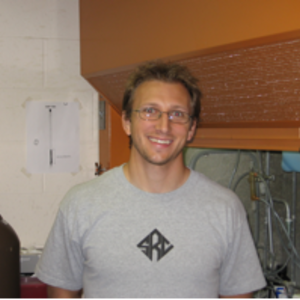
B.S. Chemistry and Applied Mathematics 2006, Southeast Missouri State University, Cape Girardeau, MO
Ph.D. Chemistry 2011, University of Notre Dame, Notre Dame, IN
Dissertation: Development of Microbe-Selective Antibacterial Agents: From Small Molecules to Siderophores
Discipline: Organic Chemistry
Mentor: Dr. Marvin J Miller
CBBI Fellow: 2007-2010
Current Position: Associate Professor, Washington University, St. Louis
Research Project:
Tim’s project involved the synthesis and study of biologically active siderophore-drug conjugates as potential targets for “Trojan Horse” drug delivery in bacteria. He used synthetic organic chemistry, microbiology, and biochemistry. The goals were to evaluate the impact of the siderophore delivery system on the spectrum and potency of antibiotic activity and probing the mechanism of action of the conjugates using kinetic drug release studies and fluorescent probes. Tim completed an internship with Dr. Ute Möllmann at the Hans Knoll Institute in Germany to learn microbial growth promotion and inhibition assays that allowed him to test the biological activity of the siderophore-drug conjugates that he synthesized. Since his return from his internship, Tim set up a fully operational antibiotic testing facility in the Miller lab capable of performing growth inhibition assays (agar diffusion and MIC determination) and growth promotion assays (agar diffusion) using bacteria and fungi.
Internship:
April 2008- July 2008 Molecular & Applied Microbiology, Hans Knoll Institute, Jena, Germany. Mentor: Professor Ute Mollman. Tim’s research internship was conducted to learn microbial growth promotion and inhibition assays that allowed him to test the biological activity of the siderophore-drug conjugates that he synthesized. He was able to set up a fully operational antibiotic testing facility in the Miller lab capable of performing growth inhibition assays (agar diffusion and MIC determination) and growth promotion assays (agar diffusion) using bacteria and fungi.
Honors:
- Brother Columba Curran Fellowship, 2006
- Kaneb Outstanding Teaching Assistant, 2007
- First Place Presentation, CBBI Symposium, 2010
- Jeremiah P. Freeman Award for Teaching in Organic Chemistry, 2010
- Bayer Predoctoral Research Fellowship, 2010
- Grace Fellowship, 2010
- ACS Div. Org. Chem. Graduate Research Symposium Awardee, 2010
- NIH National Graduate Student Research Festival Awardee, 2010
Publications
-
Wencewicz. T.A.; Miller, M.J. Biscatecholate-monohydroxamate mixed ligand siderophore-carbacephalosporin conjugates are selective sideromycin antibiotics that target Acinetobacter baumannii. J Med Chem.
2013, May 23; 56(10), 4044-52. doi: 10.1021/jm400265k. Epub 2013 May 8. PMID:23614627. PMCID: PMC3690592. - Wencewicz, T.A.; Long, T.E.; Möllmann, U.; Miller, M.J. Trihydroxamate siderophore-fluoroquinolone conjugates are selective sideromycin antibiotics that target Staphylococcus aureus. Bioconjug Chem. 2013, Mar 20 ;24(3), 473-86. doi: 10.1021/bc300610f. Epub 2013 Feb 14. PMID: 23350642. PMCID: PMC3633530.
- Wencewicz, T.A.; Oliver, A.G.; Miller, M.J. Iron(III)-Templated Macrolactonization of Trihydroxamate Siderophores. Org Lett. 2012, Sep 7; 14(17), 4390-4393. doi: 10.1021/ol301869x. Epub 2012 Aug 20. PMID: 22906163. PMCID: PMC3436969.
- Wencewicz, T.A.; Yang, B.; Rudloff, J.R., Oliver, A.G.; Miller, M.J. N-O Chemistry for Antibiotics: Discovery of N-Alkyl-N-(Pyridin-2-yl)Hydroxylamine Scaffolds as Selective Antibacterial Agents Using Nitroso Diels-Alder and Ene Chemistry. J Med Chem. 2011, Oct 13; 54(19), 6843-58. doi: 10.1021/jm200794r. Epub 2011 Sep 15. PMID: 21859126. PMCID: PMC3188665.
- Yan, S.; Miller, M.J.; Wencewicz, T.A.; Möollmann, U. Syntheses and Biological Evaluation of New Cephalosporin-Oxazolidinone Conjugates. Medchemcomm. 2010, Aug 1; 1(2), 145-148. Epub 2010 May 5. PMID: 27087912. PMCID: PMC4831628.
- Yan, S.; Miller, M.J.; Wencewicz, T.A.; Möllmann, U. Syntheses and Antibacterial Activity Studies of New Oxazolidinones From Nitroso Diels-Alder Chemistry. Bioorg Med Chem Lett. 2010, Feb 1; 20(3), 1302-1305. doi: 10.1016/j.bmcl.2009.10.018. Epub 2009 Oct 8. PMID: 20031407. PMCID: PMC2818252.
- Wencewicz, T.A.; Möllmann, U.; Long, T.E.; Miller, M.J. Is Drug Release Necessary for Antimicrobial Activity of Siderophore-Drug Conjugates? Syntheses and Biological Studies of the Naturally Occurring Salmycin “Trojan Horse” Antibiotics and Synthetic Desferridanoxamine-Antibiotic Conjugates. Biometals. 2009, Aug; 22(4), 633-48. doi: 10.1007/s10534-009-9218-3. Epub 2009 Feb 17. Review. PMID: 19221879. PMCID: PMC2766516.
- Mayfield, J.A., Frederick, R.E., Steit, B.R., Wencewicz, T.A., Ballou, D.P., DuBois, J.L. Comprehensive Spectroscopic, Steady State, and Transient Kinetic Studies of a Representative Siderophore-Associated Flavin Monooxygenase. J. Biol. Chem. 2010, 285, 30375-30388. PMCID: PMC2945530.
Kaveesha Wijesinghe

BSc (Honors), Biochemistry and Molecular Biology, University of Colombo, Sri Lanka
Ph.D. 2018 Biochemistry, University of Notre Dame, Notre Dame, IN
Dissertation: Exploring Structural and Functional Properties of Marburg Virus Matrix Protein-VP40
Discipline: Biochemistry
Mentor: Robert V. Stahelin
CBBI Fellow: 2015-2017
Current Position: Lecturer, University of Colombo, Sri Lanka
Research Project:
Kaveesha’s research is investigating the membrane binding properties of Marburg virus matrix protein – VP40. She aims to discover the molecular basis of MARV VP40 lipid selectivity that regulates membrane association and subsequent budding from the host cell. Additionally she is working to design and synthesize all hydrocarbon staples alpha-helical peptide to disrupt dimerization of MAVP40 monomers.
Internship:
Honors:
- Certificates of Merit, Class: Distinction for the Australian National Chemistry Quiz, Royal Australian Chemical Institute, 2006
- Certificates of Achievement for General Proficiency (Class prize – Ordinary Level) Annual prize giving, Anula Vidyalaya, 2005
- Certificates of Achievement for General Proficiency (Class Prize) and Biology (Grade prize – Advance Level). Annual prize giving, Anula Vidyalaya, 2008
Publications:
- Abeywickrama, C.S.; Wijesinghe, K.J.; Plescia, C.B.; Fisher, L.S.; Goodson, T. 3rd, Stahelin, R.V.; Pang, Y. A pyrene-based two-photon excitable fluorescent probe to visualize nuclei in live cells. Photochem Photobiol Sci. 2020, 19(9):1152-1159. PMID: 32639494.
- Wijesinghe, K.J.; McVeigh, L.; Husby, M.L.; Bhattarai, N.; Ma, J.; Gerstman, B.S.; Chapagain, P.P.; Stahelin, R.V. Mutation of Hydrophobic Residues in the C-Terminal Domain of the Marburg Virus Matrix Protein VP40 Disrupts Trafficking to the Plasma Membrane. Viruses. 2020, 12(4):482. PMID: 32344654.
- Abeywickrama, C.S.; Wijesinghe, K.J.; Stahelin, R.V.; Pang, Y. Bright red-emitting highly reliable styryl probe with large Stokes shift for visualizing mitochondria in live cells under wash-free conditions. Sens Actuators B Chem. 2019 Apr 15;285:76-83. doi: 10.1016/j.snb.2019.01.041. Epub 2019 Jan 10.PMID: 31762582
- Abeywickrama, C.S.; Wijesinghe, K.J.; Stahelin, R.V.; Pang, Y. Lysosome Imaging in Cancer Cells by Pyrene-Benzothiazolium Dyes: An Alternative Imaging Approach for LAMP-1 Expression Based Visualization Methods to Avoid Background Interference. Bioorg Chem. 2019, Jul 24; 91:103144. doi: 10.1016/j.bioorg.2019.103144. [Epub ahead of print] PMID: 31377388.
- Abeywickrama, C.S.; Wijesinghe, K.J.; Stahelin, R.V.; Pang, Y. Red-Emitting Pyrene-Benzothiazolium: Unexpected Selectivity to Lysosomes for Real-Time Cell Imaging Without Alkalinizing Effect. Chem Commun (Camb). 2019, Mar 19; 55(24), 3469-3472. doi: 10.1039/c9cc01068h. PMID: 30839045. PMCID: PMC6446231.
- Ahn, G.; Kim, H.; Kim, D.H.; Hanh, H.; Yoon, Y.; Singaram, I.; Wijesinghe, K.J.; Johnson, K.A.; Zhuang, X.; Liang, Z.; Stahelin, R.V.; Jiang, L.; Cho, W.; Kang, B.H.; Hwang, I. SH3 Domain-Containing Protein 2 Plays a Crucial Role at the Step of Membrane Tubulation During Cell Plate Formation. Plant Cell. 2017, Jun; 29(6), 1388-1405. doi: 10.1105/tpc.17.00108. Epub 2017 Jun 5. PMID: 28584166. PMCID: PMC5502459.
- Abeywickrama, C.S.; Wijesinghe, K.J.; Stahelin, R.V.; Pang, Y. Bright Red-Emitting Pyrene Derivatives with a Large Stokes Shift for Nucleus Staining. Chem Commun (Camb). 2017, May 30; 53(43), 5886-5889. doi: 10.1039/c7cc03417b. PMID: 28509921.
- Wijesinghe, K.J.; Urata, S.; Bhattarai, N.; Kooijman, E.E.; Gerstman, B.S.; Chapagain, P.P.; Li, S.; Stahelin, R.V. Detection of lipid-induced structural changes of the Marburg virus matrix protein VP40 using hydrogen/deuterium exchange-mass spectrometry. J Biol Chem. 2017, Apr 14; 292(15), 6108-6122. doi: 10.1074/jbc.M116.758300. Epub 2017 Feb 6. PMID: 28167534. PMCID: PMC5391744.
- Wijesinghe, K.J.; Stahelin, R.V. Investigation of the Lipid Binding Properties of the Marburg Virus Matrix Protein VP40. J Virol. 2015, Dec 30; 90(6), 3074-85. doi: 10.1128/JVI.02607-15. PMID: 26719280. PMCID: PMC4810672.
- Oda, S.; Noda, T.; Wijesinghe, K.J.; Halfmann, P.; Bornholdt, Z.A.; Abelson, D.M.; Armbrust, T.; Stahelin, R.V.; Kawaoka, Y.; Saphire, E.O. Crystal Structure of Marburg Virus VP40 Reveals a Broad, Basic Patch for Matrix Assembly and a Requirement of the N-Terminal Domain for Immunosuppression. J Virol. 2015, Dec 9; 90(4), 1839-48. doi: 10.1128/JVI.01597-15. Print 2016 Feb 15. PMID: 26656687. PMCID: PMC4733994.
Laura Woods

BSc (Hons), Chemistry, 2011, University of Otago, New Zealand
Ph.D. 2017 Organic Chemistry, University of Notre Dame, Notre Dame, IN
Dissertation: Combinational Therapy with Epothilone and Kinase Inhibitors Induces a Novel Form of Cell Death
Discipline: Chemistry
Mentor: Richard Taylor
CBBI Fellow: 2014-2016
Current Position: Lab Leader, New Technologies, Covestro, Leverkusen, Germany
Research Project:
Laura’s project focuses on combination therapy with epothilone and aurora kinase inhibitors induces a novel form of cell death
Internship
April – May 2015 Department of Biological Sciences, The University of Notre Dame, Notre Dame, IN. Mentor: Kevin Vaughan.
The goal of Laura’s internship is to assess the biological activity of the modified aurora kinase inhibitors. She has synthesized a range of inhibitors with carbonyl and alkyl functionality. The results will determine if the slight structural change to the inhibitor alters activity, and will provide information on types of linkers to incorporate into their end structure.
Honors:
- International Research Experiences for Students (IRES) of the National Science Foundation 2014, Supervised by Prof. Jan Backvall, Stockholm University, Sweden
- Graduate Student Symposium Program Committtee for ACS Colorado Meeting 2015, Part of a graduate student group chosen to organize a day long symposium
- United States New Zealand Pacific Partnership Forum Future Partners Programme, Selected as one of 20 New Zealand Future partners to participate
- Fulbright-Ministry of Science and Innovation Graduate Award Recipient 2011
Publications:
- Woods, L.M.; Arico, J.W.; Frein, J.D.; Sackett, D.L.; Taylor, R.E. Synthesis and Biological Evaluation of 7-Deoxy-Epothilone Analogues. Int J Mol Sci. 2017, Mar 17;18(3). pii: E648. doi: 10.3390/ijms18030648. PMID: 28304361 PMCID: PMC5372660.
Meiling Zhang

BS, Biotechnology, 2012, Shanghai Jiao Tong University, Shanghai, China
Ph.D. 2019 Biochemistry, University of Notre Dame, Notre Dame, IN
Dissertation: Understanding the Thermostability and Interdomain Communications of Human PIN1
Discipline: Biochemistry
Mentor: Jeffrey W. Peng
CBBI Fellow:
Current Position: Computational Biologist, Evozyne, Grand Rapids, MI
Research Project:
Meiling’s research is focused on the allosteric regulation of a modular protein, Pin1, by conformational dynamics, Pin1 consists of a substrate binding domain-WWdomain, and catalytic domain – PPlase domain. It has been proposed that a substrate binding at the WW domain can regulate the catalytic activity of the PPlase domain through an intra-molecular pathway connecting the two domains across the domain interface. Her aim is to use liquid-state NMR techniques to elucidate how the domain interface bridge the pathway and enforces regulation.
Internship:
January 2017 – April 2017 Chemistry and Chemical Biology. Rutgers University, New Brunswick, NJ. Mentor: Professor David Case.
Honors:
- National Scholarships Inspirational, Shanghai, China, 2009 and 2011
- Academic Excellence Scholarship (Third-class) of Shanghai Jiao Tong University, 2010 and 2011
- Academic Excellence Scholarship (Second-class) of Shanghai Jiao Tong University, 2009
Publications:
- Zhang, M.; Frederick, T.E.; VanPelt, J.; Case, D.A.; Peng, J.W. Coupled intra- and interdomain dynamics support domain cross-talk in Pin1 J Biol Chem. 2020; 295:16585-16603. doi: 10.1074/jbc.RA120.015849. Epub 2020 Sep 22.PMID: 32963105.
- Zhang, M.; Case, D.A.; Peng, J.W. Propagated Perturbations from a Peripheral Mutation Show Interactions Supporting WW Domain Thermostability. Structure. 2018, Nov 6; 26(11),1474-1485.e5. doi: 10.1016/j.str.2018.07.014. Epub 2018 Sep 6. PMID: 30197038.
- Mahoney, B.J.; Zhang, M.; Zintsmaster, J.S.; Peng, J.W. Extended Impact of Pin1 Catalytic Loop Phosphorylation Revealed by S71E Phosphomimetic. J Mol Biol. 2018, Mar 2; 430(5), 710-721. doi: 10.1016/j.jmb.2017.12.021. Epub 2018 Jan 6. PMID: 29317221.
- Wang, X.; Mahoney, B.J.; Zhang, M.; Zintsmaster, J.S.; Peng, J.W. Wang X, Mahoney BJ, Zhang M, Zintsmaster JS, Peng JW. Negative Regulation of Peptidyl-Prolyl Isomerase Activity by Interdomain Contact in Human Pin1. Structure. 2015, Dec 1; 23(12), 2224-2233. doi: 10.1016/j.str.2015.08.019. Epub 2015 Oct 22.PMID:26602185. PMCID: PMC4670574.
